Latest AGILE News
| Date | News |
|---|
| Feb 29, 2024 | New AGILE Public Data up to January 15, 2024
We are pleased to announce the publication of new AGILE gamma-ray data up to January 15, 2024. The new public AGILE archive now contains all data from December 1, 2007 up to January 15, 2024, i.e. from Observation Block (OB) 4900, start of Cycle-1 up to the last complete OB 43100 of the Cycle-17.
We recall that AGILE's scientific observations ended on January 18, 2024, and the satellite re-entered into the atmosphere on February 14, 2024 as a consequence of natural decay of its low Earth orbit.
AGILE-GRID event files (EVT) and spacecraft auxiliary (LOG) files are available from the SSDC Multimission Archive (MMIA) webpage for the AGILE Mission.
The AGILE public scientific software package AGILE_SW_6.0, adapted from the AGILE Science Tools (TAGNAME = BUILD25), is available here.
For an easy on-line AGILE data analysis, the interested user may also query the entire public AGILE level 3 (LV3) archive through the AGILE-LV3 data analysis tool. The AGILE-LV3 tool is meant to be easily comprehensible, and it does not require any install-on-premises software or calibrations.
An open-source Python package named Agilepy, built on top of the command-line version of the AGILE/GRID Science Tools, has been developed at INAF/OAS Bologna to analyse AGILE/GRID data. Since version 1.5.0, Agilepy has implemented an automated download of public AGILE GRID data using an SSDC REST Api. The most recent Agilepy version is v1.6.4.
| | Feb 14, 2024 | The AGILE satellite ceased operations and re-entered today into the atmosphere
New GCN issued: GCN #35726 (M. Tavani et al.).
New ATel issued: ATel #16450 (M. Tavani et al.).
| | Jan 18, 2024 | AGILE satellite ceased scientific observations
After 17 years of productive operations, the AGILE satellite ceased scientific observations on January 18, 2024.
Further communication and press release will follow.
| | Jan 11, 2024 | AGILE detection of gamma-ray rebrightening of the blazar PKS 1424-418
New ATel issued: ATel #16400 (A. Bulgarelli et al.).
| | Dec 15, 2023 | GRB 231215A: AGILE detection
New GCN issued: GCN #35361 (F. Verrecchia et al.).
| | Dec 06, 2023 | GRB 231205B: AGILE detection
New GCN issued: GCN #35295 (C. Casentini et al.).
| | Dec 01, 2023 | GRB 231129C: AGILE detection
New GCN issued: GCN #35244 (G. Panebianco et al.).
| | Nov 17, 2023 | GRB231117A: AGILE/MCAL analysis
New GCN issued: GCN #35085 (C. Casentini et al.).
| | Nov 17, 2023 | GRB 231117A: AGILE detection of a bright short burst
New GCN issued: GCN #35075 (P.W. Cattaneo et al.).
| | Nov 16, 2023 | GRB 231115A: AGILE/MCAL upper limits
New GCN issued: GCN #35061 (C. Pittori et al.).
| | Nov 14, 2023 | LIGO/Virgo S231113bw: upper limits from AGILE/MCAL
New GCN issued: GCN #35024 (L. Foffano et al.).
| | Oct 16, 2023 | New AGILE Public Data up to September 30, 2023
We are pleased to announce the publication of new AGILE gamma-ray data up to September 30, 2023.The new public AGILE archive now contains all data from December 1, 2007 up to September 30, 2023, i.e. from the start of Cycle-1, Observation Block (OB) 4900, up to up to OB 42400 of the on-going Cycle-16. AGILE-GRID event files (EVT) and spacecraft auxiliary (LOG) files are available from the SSDC Multimission Archive (MMIA) webpage for the AGILE Mission.
The AGILE public scientific software package AGILE_SW_6.0, adapted from the AGILE Science Tools (TAGNAME = BUILD25), is available here.
For an easy on-line AGILE data analysis, the interested user may also query the entire public AGILE level 3 (LV3) archive through the AGILE-LV3 data analysis tool. The AGILE-LV3 tool is meant to be easily comprehensible, and it does not require any install-on-premises software or calibrations.
An open-source Python package named Agilepy, built on top of the command-line version of the AGILE/GRID Science Tools, has been developed at INAF/OAS Bologna to analyse AGILE/GRID data. Since version 1.5.0, Agilepy has implemented an automated download of public AGILE GRID data using an SSDC REST Api. The most recent Agilepy version is v1.6.4.
| | Sep 01, 2023 | The Swift X-ray Observations Campaign of the Repeating FRB20220912A
New ATel issued: ATel #16221 (F. Verrecchia et al.).
| | Aug 13, 2023 | GRB 230812B: AGILE/MCAL detection
New GCN issued: GCN #34402 (C. Casentini et al.).
| | Jul 27, 2023 | GRB 230723A: AGILE/MCAL detection
New GCN issued: GCN #34237 (G. Panebianco et al.).
| | Jun 09, 2023 | GRB 230608A: AGILE detection
New GCN issued: GCN #33946 (F. Longo et al.).
| | May 30, 2023 | LIGO/Virgo/KAGRA S230529ay: upper limits from AGILE/MCAL
New GCN issued: GCN #33894 (F. Longo et al.).
| | May 26, 2023 | New AGILE Public Data now available up to March 31, 2023
We are pleased to announce the publication of new AGILE gamma-ray data up to March 31, 2023.
The new public AGILE archive now contains all data from December 1, 2007 up to March 31, 2023, i.e. from Observation Block (OB) 4900, start of Cycle-1 up to OB 41200 of the on-going Cycle-16. AGILE-GRID event files (EVT) and spacecraft auxiliary (LOG) files are available from the SSDC Multimission Archive (MMIA) webpage for the AGILE Mission.
Since October 2015 all AGILE-GRID data are published as soon as they are processed and validated. To produce your own maps and run likelihood tasks please download and install the new public AGILE software available here, and follow the User Manual included. The AGILE public scientific software package AGILE_SW_6.0, adapted from the AGILE Science Tools (TAGNAME = BUILD25), was published on Apr 18, 2019. It includes updated scientific software and calibrations, an updated model for the Galactic diffuse gamma-ray emission, a refined procedure for point-like source detection, and the search for extended gamma-ray sources.
An open-source Python package named Agilepy, built on top of the command-line version of the AGILE/GRID Science Tools, has been developed at INAF/OAS Bologna to analyse AGILE/GRID data. Since version 1.5.0, Agilepy has implemented an automated download of public AGILE GRID data using an SSDC REST Api.
For an easy on-line AGILE data analysis, the interested user may also query the entire public AGILE level 3 (LV3) archive through the AGILE-LV3 data analysis tool. The AGILE-LV3 tool is meant to be easily comprehensible, and it does not require any install-on-premises software or calibrations.
NOTE: due to a temporary problem on the AGILE telemetry time stamps, a correction has been implemented in 2022 on the real time ground software. The reprocessing of the consolidated archive for the 6-months period from September 30, 2021 to March 31, 2022 (OBs 37700-38800) is still pending, and the corresponding data are not public yet. The public archive is not affected. All AGILE payload functions are nominal.
| | May 24, 2023 | GRB 230524A: AGILE detection
New GCN issued: GCN #33867 (G. Panebianco et al.).
| | May 19, 2023 | LIGO/Virgo S230518h: AGILE/MCAL observations
New GCN issued: GCN #33826 (F. Verrecchia et al.).
| | Apr 26, 2023 | AGILE detection of the gamma-ray source AGL J2114+6249
New ATel issued: ATel #16012 (L. Foffano et al.).
| | Apr 19, 2023 | GRB 230418A: AGILE detection
New GCN issued: GCN #33656 (G. Panebianco et al.).
| | Apr 11, 2023 | GRB 230410B: AGILE detection of a burst
New GCN issued: GCN #33604 (F. Verrecchia et al.).
u
| | Apr 07, 2023 | GRB 230405B: AGILE detection
New GCN issued: GCN #33585 (C. Casentini et al.).
| | Apr 06, 2023 | AGILE detection of the gamma-ray source AGL J1626-3528
New ATel issued: ATel #15979 (C. Pittori et al.).
| | Apr 02, 2023 | GRB 230402A: AGILE detection
New GCN issued: GCN #33555 (C. Casentini et al.).
| | Mar 18, 2023 | Gamma-ray rebrightening of the blazar PKS 0402-362 detected by AGILE
New ATel issued: ATel #15952 (C. Pittori et al.).
| | Mar 09, 2023 | GRB 230307A: AGILE/MCAL analysis
New GCN issued: GCN #33444 (C. Casentini et al.).
| | Mar 09, 2023 | GRB 230308A: AGILE/MCAL detection
New GCN issued: GCN #33435 (C. Casentini et al.).
| | Mar 07, 2023 | GRB 230307A: AGILE/MCAL detection
New GCN issued: GCN #33412 (C. Casentini et al.).
| | Feb 18, 2023 | GRB 230217A: AGILE/MCAL detection
New GCN issued: GCN #33343 (C. Casentini et al.).
| | Feb 15, 2023 | Gamma-ray activity of the blazar PKS 0402-362 detected by AGILE
New ATel issued: ATel #15905 (A. Bulgarelli et al.).
| | Feb 15, 2023 | GRB 230209B: AGILE detection
New GCN issued: GCN #33325 (C. Casentini et al.).
| | Feb 07, 2023 | GRB 230207B: AGILE detection of a burst
New GCN issued: GCN #33296 (C. Casentini et al.).
| | Feb 05, 2023 | GRB 230204B: AGILE detection
New GCN issued: GCN #33272 (C. Casentini et al.).
| | Jan 10, 2023 | AGILE detection of gamma-ray activity from blazar 4C 29.45
New ATel issued: ATel #15853 (A. Di Piano et al.).
| | Jan 04, 2023 | GRB 230104A: AGILE/MCAL detection
New GCN issued: GCN #33148 (A. Ursi et al.).
| | Jan 02, 2023 | GRB 230102A: AGILE/MCAL detection
New GCN issued: GCN #33138 (A. Ursi et al.).
| | Dec 27, 2022 | GRB 221226A: AGILE detection
New GCN issued: GCN #33113 (G. Panebianco et al.).
| | Dec 22, 2022 | GRB 221221A: AGILE detection
New GCN issued: GCN #33093 (C. Casentini et al.).
| | Dic 21, 2022 | AGILE detection of increasing gamma-ray activity of blazar PKS 1424-418
New ATel issued: ATel #15818 (F. Verrecchia et al.).
| | Nov 30, 2022 | AGILE detection of renewed Gamma-ray activity from 3C 454.3
New ATel issued: ATel #15782 (G. Panebianco et al.).
| | Nov 28, 2022 | GRB 221126A: AGILE detection
New GCN issued: GCN #32992 (C. Casentini et al.).
| | Nov 19, 2022 | Ongoing gamma-ray flare from the PKS 0805-07 detected by AGILE
New ATel issued: ATel #15768 (A. Bulgarelli et al.).
| | Oct 29, 2022 | GRB 221028A: AGILE detection
New GCN issued: GCN #32885 (A. Ursi et al.).
| | Oct 29, 2022 | GRB 221027A: AGILE detection
New GCN issued: GCN #32884 (A. Ursi et al.).
| | Oct 26, 2022 | GRB 221023A: AGILE/GRID analysis
New GCN issued: GCN #32856 (F. Verrecchia et al.).
| | Oct 24, 2022 | GRB 221023A: AGILE detection of a burst
New GCN issued: GCN #32825 (A. Ursi et al.).
| | Oct 23, 2022 | GRB 221022B: AGILE detection
New GCN issued: GCN #32822 (C. Casentini et al.).
| | Oct 19, 2022 | AGILE detection of a burst from SGR J1935+2154 reported by VZLUSAT-2
New GCN issued: GCN #32801 (C. Casentini et al.).
| | Oct 18, 2022 | AGILE detection of the 2022 October 17 burst from SGR J1935+2154 reported by Konus-Wind
New GCN issued: GCN #32796 (F. Verrecchia et al.).
| | Oct 18, 2022 | AGILE detection of short X-ray flaring activity contemporary to SGR J1935+2154 reported bursts
New GCN issued: GCN #32789 (C. Casentini et al.).
| | Oct 11, 2022 | GRB 221009A/Swift J1913.1+1946: AGILE-GRID detection
New ATel issued: ATel #15662 (G. Piano et al.).
| | Oct 10, 2022 | GRB 221009A (Swift J1913.1+1946): AGILE/GRID detection
New GCN issued: GCN #32657 (A. Ursi et al.).
| | Oct 10, 2022 | GRB 221009A (Swift J1913.1+1946): AGILE/MCAL detection
New GCN issued: GCN #32650 (A. Ursi et al.).
| | Sep 10, 2022 | GRB 220910A: AGILE detection
New GCN issued: GCN #32540 (A. Ursi et al.).
| | Jul 31, 2022 | Gamma-ray rebrightening of the blazar PKS 1424-418 detected by AGILE
New ATel issued: ATel #15533 (F. Verrecchia et al.).
| | Jul 25, 2022 | Ongoing gamma-ray flare from the blazar PKS 1424-418 detected by AGILE
New ATel issued: ATel #15527 (G. Piano et al.).
| | Jul 22, 2022 | AGILE news
AGILE, PUBLISHED THE FIRST ARTICLE ABOUT THE "NEW YEAR'S BURST"
The first article about the GRB 220101A, the exceptionally energetic "New Year's Burst", has been published by AGILE on July, 15, 2022 (Ursi et al., ApJ 933, 2022).
Few hours after the midnight of January 1, 2022, several satellites devoted to high-energy astrophysics, including AGILE had greeted the beginning of the new year by revealing what is probably the most energetic Gamma-Ray Burst (GRB) ever reported in the history of the observations of these phenomena, i.e., the GRB 220101A.
In its 15 years activity, AGILE has already had the opportunity to reveal some particularly intense GRBs, such as the GRB 080916C and the GRB 160625B, but these events are quite rare. GRB 220101A took place more than 12 billion light years away, at the time when the Universe was just about 1.3 billion years old, and its equivalent isotropic energy is the highest ever reconstructed for a GRB.
This record-breaking energy has drawn a great deal of attention from the scientific community in a short time. In the following days, more than twenty GCN communications were released, reporting observations carried out by other space missions and by astronomical ground-based observatories.
AGILE data provide a first characterization of the prompt phase of this GRB, which corresponds to the emission of high-energy radiation in the initial shocks taking place within the central engine. The different detectors onboard the satellite, whose energy coverage ranges from the X-ray (SuperAGILE 20-60 keV) to the gamma-ray (AGILE-MCAL 0.4-100 MeV) band, allowed to provide a first comprehensive overview of the temporal evolution and the energetics of this event. Using AGILE data together with public data from the Swift satellite, it was also possible to study also the so-called "afterglow" emission, that is, the delayed emission at lower energies, produced by the interactions of the initial shocks with the surrounding interstellar medium. This analysis allows to obtain interesting information regarding the environment in which such energetic event took place.
NEW AGILE TGF CATALOG UPDATE UP TO DECEMBER 31, 2021
AGILE confirms itself as an exceptional instrument, not only for the observation of cosmic phenomena, but it continues to give fundamental contribution also for the observation of high-energy phenomena from the Earth, such as the Terrestrial Gamma-Ray Flashes (TGFs) (A. Lindanger et al. 2020; C. Maiorana et al. 20209). Recently all TGFs seen by AGILE up to 31 December 2021 have been published as an interacting SSDC web page, including details and additional information compared to the original publications of the third TGF catalog in 2020.
Additional links:
ASI news (in Italian): https://www.asi.it/2022/07/agile-pubblicato-il-primo-studio-sul-grb-di-capodanno/
ASI news (in English): https://www.asi.it/en/2022/07/agile-published-the-first-article-about-the-new-years-burst/
| | Jul 15, 2022 | GRB 220715A: AGILE/MCAL detection
New GCN issued: GCN #32401 (A. Ursi et al.).
| | Jun 30, 2022 | GRB 220624A: AGILE/GRID refined analysis
New GCN issued: GCN #32303 (F. Verrecchia et al.).
| | Jun 24, 2022 | GRB 220624A: AGILE/GRID analysis
New GCN issued: GCN #32261 (F. Verrecchia et al.).
| | Jun 24, 2022 | GRB 220624A: AGILE detection
New GCN issued: GCN #32259 (A. Ursi et al.).
| | Jun 23, 2022 | GRB 220623A: AGILE detection
New GCN issued: GCN #32247 (A. Ursi et al.).
| | May 27, 2022 | GRB 220527A: AGILE detection
New GCN issued: GCN #32129 (A. Ursi et al.).
| | May 11, 2022 | GRB 220511A: AGILE detection
New GCN issued: GCN #32021 (A. Ursi et al.).
| | Apr 30, 2022 | GRB 220430A: AGILE detection
New GCN issued: GCN #31975 (A. Ursi et al.).
| | Apr 23, 2022 | GRB 220423A: AGILE detection
New GCN issued: GCN #31938 (A. Ursi et al.).
We notice that today, April 23rd 2022, is the 15th anniversary of the AGILE launch. The AGILE instrument has been flawlessly operating in orbit since then. We take this opportunity to thank ASI, the AGILE scientific Team and the ground segment team for their committment to the excellence of the mission (GCN #31939 , M. Tavani et al.).
| | Apr 06, 2022 | AGILE confirmation of the gamma-ray flaring activity from the FSRQ 3C 345
New ATel issued: ATel #15314 (F. Verrecchia et al.).
| | Mar 23, 2022 | GRB 220323A: AGILE/MCAL detection
New GCN issued: GCN #31784 (A. Ursi et al.).
| | Mar 10, 2022 | GRB 220308A: AGILE detection
New GCN issued: GCN #31733 (A. Ursi et al.).
| | Feb 19, 2022 | GRB 220219A: AGILE/MCAL detection
New GCN issued: GCN #31611 (A. Ursi et al.).
| | Feb 11, 2022 | GRB 220210A: AGILE detection
New GCN issued: GCN #31575 (A. Ursi et al.).
| | Feb 10, 2022 | GRB 220209A: AGILE/MCAL detection
New GCN issued: GCN #31563 (A. Ursi et al.).
| | Feb 08, 2022 | The Second AGILE-MCAL GRB Catalog: 13 years of observations
We are pleased to announce that "The Second AGILE MCAL Gamma-Ray Burst Catalog: 13 yr of Observations" has been published in the Astrophysical Journal: A. Ursi et al., ApJ 925 (2022).
This new catalog presents the results of a systematic search and analysis of Gamma-Ray Burst (GRBs) detected by the Astrorivelatore Gamma ad Immagini LEggero (AGILE) MiniCALorimeter (MCAL) in the energy band 0.4–100 MeV, over a time frame of 13 years, from November 2007 to November 2020. The MCAL GRB sample consists of 503 bursts triggered by MCAL, 394 of which were fully detected onboard with high time resolution. The sample consists of about 44% short GRBs and 56% long GRBs.
The AGILE MCAL GRB sample in the new catalog mostly consists of hard-spectrum GRBs, with a large fraction of short-duration events. The MCAL bursts details can be used to perform joint broad-band analysis with other missions, and to provide insights on the high-energy component of the prompt emission in the tens of mega electron volt energy range.
An on-line version of the 2nd AGILE MCAL GRB Catalog is also available as an interactive web table at SSDC. The interactive webpage offers access to supplementary AGILE data products, such as: GRB MCAL lightcurves over 4 different timescales, hardness ratios, AGILE ratemeters lightcurves, and T50 and T90 lightcurve estimates.
For each event, the available supplementary data products can be visualized through the SSDC “GRB Explorer” tool.
| | Jan 21, 2022 | AGILE observations of a bright burst from SGR 1935+2154
New GCN issued: GCN #31515 (A. Ursi et al.).
| | Jan 12, 2022 | AGILE observations of a burst from SGR 1935+2154
New GCN issued: GCN #31444 (A. Ursi et al.).
| | Jan 01, 2022 | GRB 220101A: AGILE detection
New GCN issued: GCN #31354 (A. Ursi et al.).
| | Dec 31, 2021 | GRB 211229B: AGILE detection
New GCN issued: GCN #31344 (A. Ursi et al.).
| | Dec 26, 2021 | GRB 211226A: AGILE/MCAL detection of a burst
New GCN issued: GCN #31309 (A. Ursi et al.).
| | Dec 24, 2021 | AGILE observations of a bright burst from SGR 1935+2154
New GCN issued: GCN #31296 (A. Ursi et al.).
| | Dec 20, 2021 | GRB 211219A: AGILE detection
New GCN issued: GCN #31270 (A. Ursi et al.).
| | Dec 06, 2021 | GRB 211206A: AGILE/MCAL detection of a burst
New GCN issued: GCN #31175 (A. Ursi et al.).
| | Dic 05, 2021 | AGILE detects a gamma-ray rebrightening of the blazar PKS 0903-57
New ATel issued: ATel #15086 (C. Pittori et al.).
| | Nov 23, 2021 | GRB 211120A: AGILE detection
New GCN issued: GCN #31105 (A. Ursi et al.).
| | Nov 05, 2021 | GRB 211105A: AGILE detection of a burst
New GCN issued: GCN #31044 (A. Ursi et al.).
| | Oct 29, 2021 | AGILE detection of intense transient gamma-ray activity from Cygnus X-3 emerging from a prolonged quenching state
New ATel issued: ATel #15009 (G. Piano et al.).
| | Oct 24, 2021 | GRB 211023A: AGILE detection
New GCN issued: GCN #30969 (A. Ursi et al.).
| | Oct 18, 2021 | AGILE detection of gamma-ray flaring activity from the FSRQ TXS 0646-176
New ATel issued: ATel #14981 (C. Pittori et al.).
| | Sep 13, 2021 | AGILE observations of two bright bursts from SGR 1935+2154
New GCN issued: GCN #30835 (A. Ursi et al.).
| | Sep 10, 2021 | Updated online version of the 3rd AGILE TGF Catalog, including events up to October 31, 2020
We announce that the SSDC online version of the 3rd AGILE Terrestrial Gamma-ray Flashes (TGF) Catalog, initially including events detected by the Minicalorimeter (MCAL) during the period March 2015 - September 2018 (A. Lindanger et al. 2020 and C. Maiorana et al. 2020), has been recently updated to include 517 new events associated with lightning sferics detected from October 1, 2018 to October 31, 2020. The total number of AGILE TGF events associated with lightning sferics from March 2015 to October 2020 is more than a thousand (1116).
The complete SSDC AGILE TGF web table is available here, and it also gives access to the available TGF light curves and counts details, providing supplementary material to the published papers. The current version, published online on September 2, 2021 also includes minor bug fixes affecting the previous plotting of some of the TGF lightcurves during the so-called DRIFT period (see references for more details).
| | Aug 18, 2021 | GRB 210818A: AGILE detection
New GCN issued: GCN #30654 (A. Ursi et al.).
| | Aug 09, 2021 | AGILE detection of enhanced gamma-ray activity from the blazar BL Lac
New ATel issued: ATel #14839 (G. Piano et al.).
| | Lug 27, 2021 | GRB 210727A: AGILE/MCAL detection
New GCN issued: GCN #30533 (A. Ursi et al.).
| | Lug 14, 2021 | AGILE detection of gamma-ray flaring activity from the FSRQ Ton 0599
New ATel issued: ATel #14785 (F. Verrecchia et al.).
| | Lug 13, 2021 | AGILE confirmation of the gamma-ray flaring activity from the blazar BL Lac
New ATel issued: ATel #14782 (G. Piano et al.).
| | Lug 13, 2021 | AGILE detection of transient gamma-ray activity from Cygnus X-3 during a prolonged quenched state
New ATel issued: ATel #14780 (G. Piano et al.).
| | Lug 05, 2021 | GRB 210705A: AGILE/MCAL detection of a burst
New GCN issued: GCN #30373 (A. Ursi et al.).
| | Lug 05, 2021 | GRB 210704A: AGILE/MCAL detection
New GCN issued: GCN #30372 (A. Ursi et al.).
| | Lug 03, 2021 | GRB 210702A: AGILE detection
New GCN issued: GCN #30363 (A. Ursi et al.).
| | Jun 11, 2021 | GRB 210610B: AGILE detection
New GCN issued: GCN #30195 (A. Ursi et al.).
| | Jun 07, 2021 | GRB 210606B: AGILE detection
New GCN issued: GCN #30142 (A. Ursi et al.).
| | May 31, 2021 | GRB 210531A: AGILE/MCAL detection (Fermi Trigger 644155206 / GRB 210531500)
New GCN issued: GCN #30106 (A. Ursi et al.).
| | May 26, 2021 | Transient gamma-ray emission from Cygnus X-3 detected by AGILE during the current quenched/hypersoft state
New ATel issued: ATel #14662 (G. Piano et al.).
| | May 17, 2021 | AGILE confirmation of the gamma-ray flaring activity from the two blazars PKS 0514-459 and TXS 1700+685
New ATel issued: ATel #14634 (A. Bulgarelli et al.)
| | May 17, 2021 | GRB 210517A: AGILE detection
New GCN issued: GCN #30036 (A. Ursi et al.).
| | May 11, 2021 | GRB 210511B: AGILE detection
New GCN issued: GCN #29991 (A. Ursi et al.).
| | Apr 11, 2021 | GRB 210410A: AGILE/MCAL analysis
New GCN issued: GCN #29798 (A. Ursi et al.).
| | Apr 10, 2021 | GRB 210410A: AGILE detection of a burst
New GCN issued: GCN #29782 (A. Ursi et al.).
The AGILE satellite detected the long burst GRB 210410A that triggered the automatic AGILE Mini-CALorimeter (MCAL) GRB alert Notice (trigger id 545100796).
For more information about automatic AGILE MCAL ALERT notices, please see: https://gcn.gsfc.nasa.gov/agile_mcal.html
| | Feb 08, 2021 | GRB 210207B: AGILE observations
New GCN issued: GCN #29428 (A. Ursi et al.).
| | Feb 05, 2021 | GRB 210205B: AGILE/MCAL detection of a burst
New GCN issued: GCN #29404 (A. Ursi et al.).
| | Feb 03, 2021 | GRB 210202A: AGILE/MCAL detection
New GCN issued: GCN #29389 (A. Ursi et al.).
| | Jan 12, 2021 | GRB 210112A: AGILE detection
New GCN issued: GCN #29293 (A. Ursi et al.).
| | Dec 27, 2020 | GRB 201227A: AGILE detection of a burst
New GCN issued: GCN #29179 (A. Ursi et al.).
| | Dec 09, 2020 | GRB 201207A: AGILE detection
New GCN issued: GCN #29010 (A. Ursi et al.).
| | Dec 01, 2020 | AGILE detection of the bright M-class solar flare of November 29, 2020
FThe AGILE satellite detected the remarkable X-ray emission associated to the medium-strength flare (class M4.4) at UT 2020-11-29 13:18:00. This is the strongest solar flare of the new solar cycle 25 thus far. See AGILE details and light curves in the published ATel #14236.
New ATel issued: ATel #14236 (A. Ursi et al.).
| | Nov 14, 2020 | AGILE detection of C-class solar flares at the beginning of the new solar cycle 25
From October 27 to November 12, 2020 the AGILE Anti-Coincidence scientific ratemeters oriented toward the Sun (AC Lat4; 80-200 keV) detected about 45 intense X-ray emissions from C-class solar flares. See details and light curves in the published ATel #14172.
New ATel issued: ATel #14172 (A. Ursi et al.).
| | Nov 4, 2020 | GRB 201103B: AGILE detection
New GCN issued: GCN #28831 (A. Ursi et al.).
| | Nov 4, 2020 | GRB 201104A: AGILE/MCAL detection
New GCN issued: GCN #28829 (A. Ursi et al.).
| | Oct 21, 2020 | GRB 201020B: AGILE detection
New GCN issued: GCN #28714 (A. Ursi et al.).
| | Oct 12, 2020 | Fermi trigger No 624139481: AGILE detection
New GCN issued: GCN #28605 (A. Ursi et al.).
| | Oct 09, 2020 | GRB 201009A: AGILE detection of a burst
New GCN issued: GCN #28588 (A. Ursi et al.).
| | Sep 21, 2020 | GRB 200920B: AGILE/MCAL detection of a burst
New GCN issued: GCN #28464 (A. Ursi et al.).
| | Sep 15, 2020 | GRB 200914A: AGILE detection
New GCN issued: GCN #28426 (A. Ursi et al.).
| | Sep 07, 2020 | GRB 200907A: AGILE/MCAL detection of a burst
New GCN issued: GCN #28378 (A. Ursi et al.).
| | Sep 03, 2020 | AGILE detection of a burst (AGILE trigger no. 526185273)
New GCN issued: GCN #28356 (A. Ursi et al.).
| | Aug 29, 2020 | GRB 200829A: AGILE/MCAL detection
New GCN issued: GCN #28314 (A. Ursi et al.).
| | Aug 26, 2020 | GRB 200826A: AGILE detection
New GCN issued: GCN #28289 (C. Pittori et al.).
| | Aug 09, 2020 | GRB 200808A: AGILE detection
New GCN issued: GCN #28235 (A. Ursi et al.).
| | Jul 17, 2020 | GRB 200716C: AGILE/MCAL detection
New GCN issued: GCN #28133 (A. Ursi et al.).
| | Jul 16, 2020 | GRB 200716A: AGILE detection
New GCN issued: GCN #28116 (A. Ursi et al.).
| | Jul 15, 2020 | GRB 200714E: AGILE detection
New GCN issued: GCN #28105 (A. Ursi et al.).
| | June 19, 2020 | GRB 200619A: AGILE detection
New GCN issued: GCN #27991 (A. Ursi et al.).
| | June 5, 2020 | New AGILE Public Data now available up to March 31, 2020.
We are pleased to announce the publication of new AGILE gamma-ray data up to March 31, 2020.
The new public AGILE archive now contains all data from December 1, 2007 up to March 31, 2020, i.e. from Observation Block (OB) 4900, start of Cycle-1 up to OB 34000 of the on-going Cycle-13. AGILE-GRID event files (EVT) and spacecraft auxiliary (LOG) files are available from the SSDC Multimission Archive (MMIA) webpage for the AGILE Mission.
Since October 2015 all AGILE-GRID data are published as soon as they are processed and validated. To produce your own maps and run likelihood tasks please download and install the new public AGILE software available here, and follow the User Manual included. The AGILE public scientific software package AGILE_SW_6.0, adapted from the AGILE Science Tools (TAGNAME = BUILD25), was published on Apr 18, 2019. It includes updated scientific software and calibrations, an updated model for the Galactic diffuse gamma-ray emission, a refined procedure for point-like source detection, and the search for extended gamma-ray sources.
For an easy on-line AGILE data analysis, the interested user may also query the entire public AGILE level 3 (LV3) archive through the AGILE-LV3 data analysis tool. The AGILE-LV3 tool is meant to be easily comprehensible, and it does not require any install-on-premises software or calibrations. The underlying AGILE software and calibrations will be updated also in the AGILE-LV3 Tool in the next few months.
NOTE on COVID-19 related changes to operations:
reduced operations at the ASI Malindi ground station because of temporary COVID-19 precautions. Limited telemetry since April 1, 2020 (from OB 34100), only AGILE-MCAL and instrument ratemeters are on since April 16, 2020. All AGILE payload functions are nominal.
| | May 21, 2020 | GRB 200521A: AGILE/MCAL and ratemeters detection
New GCN issued: GCN #27776 (F. Verrecchia et al.).
The AGILE satellite detected the short burst GRB 200521A that triggered the automatic AGILE Mini-CALorimeter (MCAL) GRB alert Notice (trigger ID 517148200).
GCN/AGILE-MCAL ALERT NOTICE SIGN-UP: to sign up for the AGILE_MCAL_ALERT type, just send an email (especially with your SITE_NAME) to sbarthel@milkyway.gsfc.nasa.gov saying you want this AGILE-MCAL ALERT notice type added to your configuration.
For more information about automatic AGILE MCAL ALERT notices, please see: https://gcn.gsfc.nasa.gov/agile_mcal.html
| | May 12, 2020 | AGILE detection of a burst from SGR 1935+2154 on May 10, 2020
New GCN issued: GCN #27727 (F. Verrecchia et al.).
| | May 04, 2020 | AGILE detection of a short and hard X-ray burst possibly related to SGR 1935+2154
New GCN issued: GCN #27687 (A. Ursi et al.).
The AGILE satellite detected a short hard X-ray burst at T0 = 2020-05-03 23:25:13.50 (UT) compatible with a source at the position of SGR 1935+2154. The event is visible in the scientific ratemeters of the SuperAGILE (SA; 20-60 keV) detector and of the Anti-Coincidence (AC, 50-200 keV). The SA and AC ratemeters light curves can be found here.
| | May 03, 2020 | GRB 200503A: AGILE observations
New GCN issued: GCN #27685 (A. Ursi et al.).
| | May 03, 2020 | GRB 200502A: AGILE observations
New GCN issued: GCN #27684 (A. Ursi et al.).
| | Apr 29, 2020 | AGILE detection of a hard X-ray burst in temporal coincidence with a radio burst from SGR 1935+2154
New ATel issued: ATel #13686 (M. Tavani et al.)
| | Apr 28, 2020 | AGILE observations of the SGR 1935+2154 "burst forest"
New ATel issued: ATel #13682 (A. Ursi et al.)
| | Apr 01, 2020 | AGILE detection of enhanced gamma-ray activity from the blazar PKS 0903-57
New ATel issued: ATel #13602 (F. Lucarelli et al.)
| | Mar 28, 2020 | GRB 200327A: AGILE/MCAL observations
New GCN issued: GCN #27461 (A. Ursi et al.).
The AGILE satellite detected the short burst GRB 200327A, also reported by Fermi/GBM (GCN #27458). This GRB was also previously reported as an automatic GCN/AGILE-MCAL ALERT NOTICE, trigger ID 512427408.
GCN/AGILE-MCAL ALERT NOTICE SIGN-UP: to sign up for the AGILE_MCAL_ALERT type, just send an email (especially with your SITE_NAME) to sbarthel@milkyway.gsfc.nasa.gov saying you want this AGILE-MCAL ALERT notice type added to your configuration.
For more information on automatic AGILE MCAL ALERT notices see: https://gcn.gsfc.nasa.gov/agile_mcal.html
| | Mar 25, 2020 | GRB 200325A: AGILE/MCAL observations
New GCN issued: GCN #27437 (A. Ursi et al.).
The AGILE satellite detected the short burst GRB 200325A, also reported by Fermi/GBM (GCN #27434). This GRB was also previously reported as an automatic GCN/AGILE-MCAL ALERT NOTICE, trigger ID 512191111.
GCN/AGILE-MCAL ALERT NOTICE SIGN-UP: to sign up for the AGILE_MCAL_ALERT type, just send an email (especially with your SITE_NAME) to sbarthel@milkyway.gsfc.nasa.gov saying you want this AGILE-MCAL ALERT notice type added to your configuration.
For more information on automatic AGILE MCAL ALERT notices see: https://gcn.gsfc.nasa.gov/agile_mcal.html
| | Mar 11, 2020 | GRB 200311A: AGILE/MCAL and scientific ratemeters observations
New GCN issued: GCN #27365 (A. Ursi et al.).
The AGILE satellite detected the long burst GRB 200311A, also reported by Fermi/GBM (GCN #27363). This GRB was also previously reported as an automatic GCN/AGILE-MCAL ALERT NOTICE, trigger ID 511024575.
GCN/AGILE-MCAL ALERT NOTICE SIGN-UP : to sign up for the AGILE_MCAL_ALERT type, just send an email (especially with your SITE_NAME) to sbarthel@milkyway.gsfc.nasa.gov saying you want this AGILE-MCAL ALERT notice type added to your configuration.
For more information on automatic AGILE MCAL ALERT notices see: https://gcn.gsfc.nasa.gov/agile_mcal.html
| | Feb 07, 2020 | Gamma-ray flare from Cygnus X-3 detected by AGILE
New ATel issued: ATel #13458 (G. Piano et al.).
| | Jan 28, 2020 | AGILE gamma-ray observations of Cygnus X-3 during the current quenched/hypersoft state
New ATel issued: ATel #13423 (G. Piano et al.).
| | Jan 28, 2020 | GRB 200128B: AGILE/MCAL detection of a burst
New GCN issued: GCN #26917 (A. Ursi et al.).
This GRB was also previously reported as an automatic GCN/AGILE-MCAL ALERT NOTICE, trigger ID 507299009.
The GCN/AGILE-MCAL TRIGGER ALERT NOTICES, active since May 11, 2019, alert the community on transient events that trigger the AGILE MCAL on-board trigger logic, and are successively selected and identified as GRBs by an offline burst search algorithm (with significance values greater than 5 sigma).
GCN/AGILE-MCAL ALERT NOTICE SIGN-UP :
To encorporate the AGILE_MCAL_ALERT type, just send an email (especially with your SITE_NAME) to sbarthel@milkyway.gsfc.nasa.gov saying you want this AGILE-MCAL ALERT notice type added to your configuration.
For more information on automatic AGILE MCAL ALERT notices see:https://gcn.gsfc.nasa.gov/agile_mcal.html
| | Dec 23, 2019 | New AGILE Public Data from the start of Cycle-1 up to the end of Cycle-12
We are pleased to announce the publication of new AGILE gamma-ray data up to November 30, 2019.
The new public AGILE archive now contains all data from December 1, 2007 up to November 30, 2019, i.e. from the start of Cycle-1 up to the end of Cycle-12. AGILE-GRID event files (EVT) and spacecraft auxiliary (LOG) files are available from the SSDC Multimission Archive (MMIA) webpage for the AGILE Mission.
Since October 2015 all AGILE-GRID data are published as soon as they are processed and validated. AGILE satellite operations and all AGILE payload functions are nominal. To produce your own maps and run likelihood tasks please download and install the new public AGILE software available here, and follow the User Manual included. The AGILE public scientific software package AGILE_SW_6.0, adapted from the AGILE Science Tools (TAGNAME = BUILD25), was published on Apr 18, 2019. It includes updated scientific software and calibrations, an updated model for the Galactic diffuse gamma-ray emission, a refined procedure for point-like source detection, and the search for extended gamma-ray sources.
For an easy on-line AGILE data analysis, the interested user may also query the entire public AGILE level 3 (LV3) archive through the AGILE-LV3 data analysis tool. The AGILE-LV3 tool is meant to be easily comprehensible, and it does not require any install-on-premises software or calibrations. The underlying AGILE software and calibrations will be updated also in the AGILE-LV3 Tool in the next few months.
| | Dec 22, 2019 | GRB 191221B: AGILE/MCAL observations
New GCN issued: GCN #26549 (F. Longo et al.).
This GRB was also previously reported as an automatic GCN/AGILE-MCAL ALERT NOTICE, trigger ID 504045551.
The GCN/AGILE-MCAL TRIGGER ALERT NOTICES, active since May 11, 2019, alert the community on transient events that trigger the AGILE MCAL on-board trigger logic in one or more predefined timescales (sub-ms, 1 ms, 16 ms, 64 ms, 256 ms, 1024 ms, and 8192 ms), and are successively selected and identified as GRBs by an offline burst search algorithm that yields total significance values greater than 5 sigma.
GCN/AGILE-MCAL ALERT NOTICE SIGN-UP ACTION ITEM:
Since the "Modify Sites Config" webform page has not yet been updated to encorporate the AGILE_MCAL_ALERT type, just send an email (especially with your SITE_NAME) to sbarthel@milkyway.gsfc.nasa.gov saying you want this AGILE-MCAL ALERT notice type added to your configuration.
For more information on automatic AGILE MCAL ALERT notices see:
https://gcn.gsfc.nasa.gov/agile_mcal.html
| | Dec 16, 2019 | AGILE detection of enhanced gamma-ray activity from the FSRQ PKS 0208-512
New ATel issued: ATel #13352 (F. Lucarelli et al.)
| | Dec 04, 2019 | Enhanced gamma-ray activity from Eta Carinae detected by AGILE
AGILE is detecting gamma-ray emission above 100 MeV from a source positionally consistent with the colliding wind binary Eta Carinae:
New ATel issued: "Enhanced gamma-ray activity from Eta Carinae", ATel #13329 (G. Piano et al.).
This high-energy gamma-ray activity is consistent with the emission pattern of October 2008, when AGILE observed a peak gamma-ray emission from Eta Carinae a few months before the periastron passage of January 2009 (Tavani et al., ApJ 698, L142, 2009). The next periastron passage should occur by the end of February 2020.
See also:
AGILE top results: April 21, 2009 "AGILE Detection of Gamma-ray Emission from the Eta-Carinae Region"
| | Nov 01, 2019 | GRB 191031D: AGILE/MCAL observations
New GCN issued: GCN #26123 (A. Ursi et al.).
| | Oct 31, 2019 | New AGILE Public Data Now Available
We are pleased to announce the publication of new AGILE gamma-ray data up to September 30, 2019.
We recall that since October 2015 all AGILE-GRID data are published as soon as they are processed and validated. AGILE satellite operations and all AGILE payload functions are nominal. The new public AGILE archive now contains all data from December 1, 2007 up to Sep 30, 2019, i.e. from the start of Cycle-1 up to the on-going Cycle-12. AGILE-GRID event files (EVT) and spacecraft auxiliary (LOG) files are available from the SSDC Multimission Archive (MMIA) webpage for the AGILE Mission.
To produce your own maps and run likelihood tasks please download and install the new public AGILE software available here, and follow the User Manual included. The new AGILE public scientific software package AGILE_SW_6.0, adapted from the AGILE Science Tools (TAGNAME = BUILD25), was published on Apr 18, 2019. It includes new scientific software and calibrations, an updated model for the Galactic diffuse gamma-ray emission, a refined procedure for point-like source detection, and the search for extended gamma-ray sources.
For an easy on-line AGILE data analysis, the interested user may also query the entire public AGILE level 3 (LV3) archive through the AGILE-LV3 data analysis tool.The AGILE-LV3 tool is meant to be easily comprehensible, and it does not require any install-on-premises software or calibrations. The underlying AGILE software and calibrations will be updated also in the AGILE-LV3 Tool in the next few months.
| | Oct 30, 2019 | AGILE confirmation of the gamma-ray flaring activity from the narrow-line Seyfert1 Galaxy PKS 2004-447
New ATel issued: ATel #13244 (F. Verrecchia et al.).
| | Sep 02, 2019 | AGILE detection of renewed gamma-ray activity from the FSRQ PKS 1830-211
New ATel issued: ATel #13065 (F. Lucarelli et al.).
| | Aug 30, 2019 | GRB 190829A: AGILE ratemeters detection and AGILE-MCAL and AGILE-GRID analysis
AGILE observed the long GRB 190829A at T0 = 2019-08-29 19:55:53 (UT) first reported by Fermi GBM (GCN #25551) and by Swift (GCN #25552). The scientific ratemeters of the Anti-Coincidence (50-200 keV) and Super-AGILE (SA; 18-60 keV) detected the burst. The GRB 190829A was also seen at VHE gamma-ray energy by H.E.S.S.(GCN 25566).
AGILE ratemeters detection and AGILE-MCAL upper limits are reported in GCN #25577 (C. Pittori et al.).
AGILE-GRID upper limits and a possible sub-threshold gamma-ray source detection are reported in GCN #25578 (G. Piano et al.).
| | Aug 09, 2019 | AGILE detection of gamma-ray flaring activity from the FSRQ PKS 0454-234
New ATel issued: ATel #13011 (M. Cardillo et al.).
| | Aug 08, 2019 | New AGILE public data and new scientific software package now available
We are pleased to announce the publication of new AGILE gamma-ray data up to May 31, 2019 and a new AGILE scientific software package.
We recall that since October 2015 all AGILE-GRID data are published as soon as they are processed and validated. AGILE satellite operations and all AGILE payload functions are nominal. The new public AGILE archive now contains all data from December 1, 2007 up to May 31, 2019, i.e. from the start of Cycle-1 up to the on-going Cycle-12. AGILE-GRID event files (EVT) and spacecraft auxiliary (LOG) files are available from the SSDC Multimission Archive (MMIA) webpage for the AGILE Mission.
To produce your own maps and run likelihood tasks please download and install the new public AGILE software available here, and follow the User Manual included. The new AGILE public scientific software package AGILE_SW_6.0, adapted from the AGILE Science Tools (TAGNAME = BUILD25), was published on Apr 18, 2019. It includes new scientific software and calibrations, an updated model for the Galactic diffuse gamma-ray emission, a refined procedure for point-like source detection, and the search for extended gamma-ray sources.
For an easy on-line AGILE data analysis, the interested user may also query the entire public AGILE level 3 (LV3) archive through the AGILE-LV3 data analysis tool. The AGILE-LV3 tool is meant to be easily comprehensible, and it does not require any install-on-premises software or calibrations. The underlying AGILE software and calibrations will be updated also in the AGILE-LV3 tool in the next few months.
| | Jul 31, 2019 | AGILE follow-up of the high-energy neutrino candidate event IceCube-190730A
New ATel issued: ATel #12970 (F. Lucarelli et al.).
| | Jul 12, 2019 | AGILE new High-Energy TGF Catalog
We are pleased to announce that the paper: "On The High-Energy Spectral Component and Fine Time Structure of Terrestrial Gamma-Ray Flashes" (Marisaldi et al.) has been accepted for publication in Journal of Geophysical Research, Doi: 10.1029/2019JD030554. The online version of the new AGILE-MCAL High-Energy Terrestrial Gamma-Ray Flashes (TGFs) Catalog is available here.
The SSDC web table also gives access to the available TGF light curves and counts details, providing supplementary material to the submitted paper. This third AGILE TGF catalog includes a previously unpublished high-energy dataset of events with energy larger than 30 MeV, observed by the AGILE minicalorimeter (MCAL) from March 2015 to June 2015, in association with lightning measurements.
| | Jun 27, 2019 | Enhanced gamma-ray activity from Cygnus X-3
New ATel issued: ATel #12894 (G. Piano et al.).
| | Jun 06, 2019 | Fermi trigger No 581478912 / GRB 190606A: AGILE/MCAL observations
New GCN issued: GCN #24759 (A. Ursi et al.).
| | May 30, 2019 | GRB 190530A: AGILE/GRID analysis
New GCN issued: GCN #24683 (F. Verrecchia et al.).
| | May 30, 2019 | GRB 190530A: AGILE-MCAL detection
New GCN issued: GCN #24678 (F. Lucarelli et al.).
| | May 06, 2019 | AGILE detection of enhanced gamma-ray emission from the FSRQ PKS 0736+01 region
New ATel issued: ATel #12733 (F. Lucarelli et al.).
| | May 02, 2019 | GRB 190501A: AGILE detection and refined analysis of a burst
New GCN issued:
GCN #24360: GRB 190501A: AGILE/MCAL and scientific ratemeters detection of a burst (A. Ursi et al.)
GCN #24361: GRB 190501A: AGILE/GRID detection (F. Lucarelli et al.)
GCN #24363: GRB 190501A: refined position from AGILE/GRID analysis (F. Verrecchia et al.)
| | Apr 24, 2019 | New gamma-ray flux record from the FSRQ PKS1830-211 detected by AGILE
New ATel issued: ATel #12685 (M. Cardillo et al.).
| | Apr 22, 2019 | Ongoing gamma-ray flaring activity from Cygnus X-3 detected by AGILE
New ATel issued: ATel #12678 (G. Piano et al.).
| | Apr 20, 2019 | AGILE detection of enhanced gamma-ray emission from Cygnus X-3
New ATel issued: ATel #12677 (G. Piano et al.).
| | Apr 03, 2019 | The new AGILE-GRID Catalog: 2AGL
We are pleased to announce that "The Second AGILE Catalog of Gamma-Ray Sources" (A. Bulgarelli et al., 2019), arXiv:1903.06957, has been accepted for publication in Astronomy & Astrophysics. The new 2AGL incorporates several analysis improvements, including better calibrations, an updated model for the Galactic diffuse gamma-ray emission, and the inclusion of a search for extended gamma-ray sources. The 2AGL Catalog includes 175 high-confidence sources, with a sub-class of 29 "AGILE only" gamma-ray sources that are not present in 1FGL, 2FGL or 3FGL Fermi catalogs.
An on-line version of the new 2AGL Catalog, plus some supplementary information, including AGILE skymaps, is now available as an interactive web table at SSDC.
After the paper publication on A&A, a new version of the 2AGL webpage (V2.0) at SSDC will also give access to other AGILE data products, such as spectra and light curves.
| | Apr 02, 2019 | AGILE detection of the source AGL J2233-2212 in temporal and space closeness to the IceCube-190331A neutrino event
New ATel issued: ATel #12623 (F. Lucarelli et al.).
| | Apr 02, 2019 | AGILE detection of a very strong gamma-ray flaring activity from the FSRQ PKS1830-211
New ATel issued: ATel #12622 (M. Cardillo et al.).
| | Mar 18, 2019 | AGILE detection of renewed gamma-ray flaring activity from the FSRQ PKS1830-211
New ATel issued: ATel #12594 (C. Pittori et al.).
| | Mar 05, 2019 | GRB 190305A: AGILE/MCAL detection of a burst
New GCN issued: GCN #23930 (A. Ursi et al., on behalf of the AGILE Team).
| | Mar 01, 2019 | AGILE detection of enhanced gamma-ray activity from the FSRQ PKS 1830-211
New ATel issued: ATel #12541 (F. Lucarelli et al.).
| | Feb 02, 2019 | GRB 190202A: AGILE ratemeters detection
New GCN issued: GCN #23835 (F. Verrecchia et al., on behalf of the AGILE Team).
| | Jan 17, 2019 | GRB 190117A: AGILE/MCAL detection of a burst
New GCN issued: GCN #23752 (A. Ursi et al., on behalf of the AGILE Team).
| | Jan 15, 2019 | GRB 190114C: AGILE/MCAL detection of a burst
New GCN issued: GCN #23712 (A. Ursi et al., on behalf of the AGILE Team).
| | Jan 15, 2019 | New AGILE Public Data Now Available
We are pleased to announce the publication of new AGILE gamma-ray data up to November 30, 2018.
Since December 28, 2018, the new public AGILE archive now contains all data from December 1, 2007 up to November 30, 2018,i.e. from the start of Cycle-1 up to the end of Cycle-11. AGILE-GRID event files (EVT) and spacecraft auxiliary (LOG) files are available from the SSDC Multimission Archive (MMIA) webpage for the AGILE Mission.
We recall that since October 2015 all AGILE-GRID data are published as soon as they are processed and validated. The new AGILE Cycle-11 data were obtained with AGILE observing a large portion of the sky in spinning mode, and they have been processed with the latest available software and calibrations. AGILE satellite operations and all AGILE payload functions are nominal.
For an easy on-line AGILE data analysis, the interested user may also query the entire public AGILE level 3 (LV3) archive through the AGILE-LV3 data analysis tool. The AGILE-LV3 web tool is meant to be easily comprehensible, and it does not require any installed software or calibrations. We also plan to update the underlying AGILE software and calibrations in the next few months. Stay tuned!
| | Jan 03, 2019 | GRB 190103A: AGILE/MCAL detection of a burst
New GCN issued: GCN #23600 (A. Ursi et al., on behalf of the AGILE Team).
| | Dec 25, 2018 | GRB 181225A: AGILE/MCAL detection of a burst
New GCN issued: GCN #23560 (A. Ursi et al., on behalf of the AGILE Team).
| | Nov 22, 2018 | GRB 181121A: AGILE/MCAL detection of a burst
New GCN issued: GCN #23429 (A. Ursi et al., on behalf of the AGILE Team).
| | Nov 13, 2018 | AGILE confirmation of flaring activity from the new gamma-ray source Fermi J1153-1124
New ATel issued: ATel #12208 (F. Lucarelli et al.).
| | Oct 29, 2018 | AGILE is detecting a renewed and intense gamma-ray flare above 100 MeV from the direction of the Crab Nebula.
New ATel issued: ATel #12148 (A. Bulgarelli et al.).
| | Oct 18, 2018 | AGILE detection of enhanced gamma-ray activity from the Crab Nebula
New ATel issued: ATel #12123 (M. Cardillo et al.) and Erratum: ATel #12125
| | Oct 12, 2018 | Ongoing episode of enhanced gamma-ray emission from the Crab Nebula detected by AGILE
New ATel issued: ATel #12105 (F. Lucarelli et al.).
| | Oct 10, 2018 | SSDC interactive analysis tools among US Students: an american public school pioneer project
As part of the collaborative efforts with SSDC, Dr. Franco Paoletti incorporated two remote space data analysis activities in the curriculum of the "Introduction to Modern Astro-Plasma Physics" course, recently approved by the Board of Education of the East Windsor Regional School District in Hightstown, NJ (USA).
The two activities will see students analyzing data coming from both Solar System exploration and high-energy observations of the Universe, and will be performed using the SSDC interactive online analysis tools: MATISSE for Solar System observations and AGILE-LV3 for the gamma-ray AGILE satellite data.
The activities point to reproduce published scientific results, such as the characterization of dark material on the Vesta asteroid (e.g. Palomba et al., 2014) and the analysis of a couple of exceptional bright flares seen in gamma-rays from monster black holes in distant galaxies (e.g. Astronomer's Telegrams: ATel #9186 and ATel #7631).
The final goal is to provide the students with knowledge, skills, and competences required to correctly use tools specifically designed at our data center for professional researchers, and to get a better understanding of the day to day work of an astrophysicist.
| | Sep 16, 2018 | GRB 180914B: AGILE/MCAL refined analysis
New GCN issued: GCN #23242 (A. Ursi et al., on behalf of the AGILE Team).
| | Sep 15, 2018 | GRB 180914B: AGILE/GRID detection
New GCN issued: GCN #23231 (F. Verrecchia et al., on behalf of the AGILE Team).
| | Sep 15, 2018 | GRB 180914B: AGILE/MCAL detection of a burst
New GCN issued: GCN #23226 (A. Ursi et al., on behalf of the AGILE Team).
| | Sep 11, 2018 | AGILE detection of a prolonged enhanced gamma-ray emission from the blazar 4C +38.41
New ATel issued: ATel #12026 (M. Cardillo et al.).
| | Sep 03, 2018 | AGILE detection of a gamma-ray flare from the high-redshift FSRQ 4C +38.41
New ATel issued: ATel #12005 (G. Piano et al.).
| | Jul 20, 2018 | AGILE/MCAL detection of GRB 180720A
New GCN issued: GCN #22970 (A. Ursi et al., on behalf of the AGILE Team).
| | Jul 12, 2018 | Discovery of neutrino and gamma rays from the same blazar source by IceCube and Fermi with contribution of MAGIC and AGILE
Neutrinos, electrically uncharged and traveling at nearly the speed of light, are able to escape the densest astrophysical environments and point back to their source of origin, therefore they represent unique tracers of cosmic-ray particles acceleration. Such extreme environments can be found in blazars, that are active galactic nuclei characterized by accreting supermassive black holes developing immense relativistic jets of plasma pointing close to our line of sight. Blazars are among the most powerful objects in the universe speculated to be sources of high-energy cosmic rays. The discovery of an association of a very high-energy neutrino with a flaring photon gamma-ray blazar object by the IceCube experiment and the Fermi space satellite, announced on July 12, 2018 with a press conference by NSF and a cover and paper in the Science journal, highlights for the first time mechanisms and conditions for highest-energy cosmic rays acceleration and the existence of extragalactic sources producing high-energy neutrinos and gamma rays. The detection of an about 290 TeV energy neutrino (namely the event IC-170922A) on 22 September 2017 by the IceCube experiment at the Amundsen-Scott South Pole Station, in Antarctica, was found to be consistent with the location of a Fermi Gamma-ray Space Telescope catalogued gamma-ray source (3FGL J0509.4+0541, i.e. the blazar TXS 0506+056). The Fermi Large Area Telescope (LAT) first reported the positional coincidence (within 0.1 degrees) of the very high-energy neutrino event with a gamma-ray source detected at E>100 MeV, the blazar TXS 0506+056 (also known as MG1 J050927+0541, RX J0509.3+054, ZS 0506+056 and other), in a flaring state, issuing one Astronomer's Telegram (ATel) on September, 28, 2017. This triggered many observations and results with the corresponding multi-wavelength follow-up measurements, for example by MAGIC, AGILE, Swift and NuSTAR. All these are missions and experiments see the participation of the ASI Space Science Data Center (SSDC), and Fermi, MAGIC and AGILE are built with a fundamental contribution of INFN and INAF. Notably AGILE confirmed soon after the association of IC-170922A with the E>100 MeV gamma-ray activity of TXS 0506+056 with another ATel, while the MAGIC Cherenkov telescope also detected it and revealed periods where the gamma-ray flux from the blazar reached energies of up to 400 GeV. Subsequent measurements of the source have been completed at X-ray, optical, and radio wavelengths. Formerly AGILE suggested also a possible association of gamma rays with an IceCube neutrino event in July 2016, after the detection of a gamma-ray transient found to be consistent with the position and time of IC-160731. Based on the redshift of TXS 0506+056, with value z=0.3365 corresponding to a luminosity distance of 5.5 billion light years, accurately measured and published in February 2018 (only upper/lower limits were available before), constraints are derived for the muon neutrino luminosity for this source, found to be similar to the luminosity observed in gamma rays. The energies of the gamma rays and the neutrino indicate that blazar jets may accelerate cosmic rays to at least several PeV. Chance correlation of this neutrino with the flare of TXS 0506+056 is statistically disfavored at the level of 3 sigma in any of the evaluated models associating neutrino and gamma-ray production. This important result for the newborn multi-messenger astro-particle physics confirms the close relations among the different cosmic messengers. The most extreme cosmic explosions producing transient gamma rays (GRBs) also produce gravitational waves, and the most extreme cosmic accelerators producing intense, persisting and variable flux of gamma-rays (blazars) produce high-energy neutrinos and cosmic rays. Through the Fermi and AGILE satellites and the large ground based astro-particle experiments for neutrinos, UHE cosmic rays and gravitational waves, gamma rays are providing a bridge to each of these new cosmic signals, opening the multi-messenger astronomy era. Many interpretations and works, published or in preparation, are following up the discovery, shedding light on a truly multi-messenger scenario for the flaring GeV gamma-ray blazar TXS 0506+056 and the implications for very high-energy neutrino emission and cosmic ray acceleration. The ASI SSDC is contributing and supporting archive, data, software and science operations and data analysis tasks for the Fermi, AGILE, Swift, and NuSTAR missions. More information: Italian news: 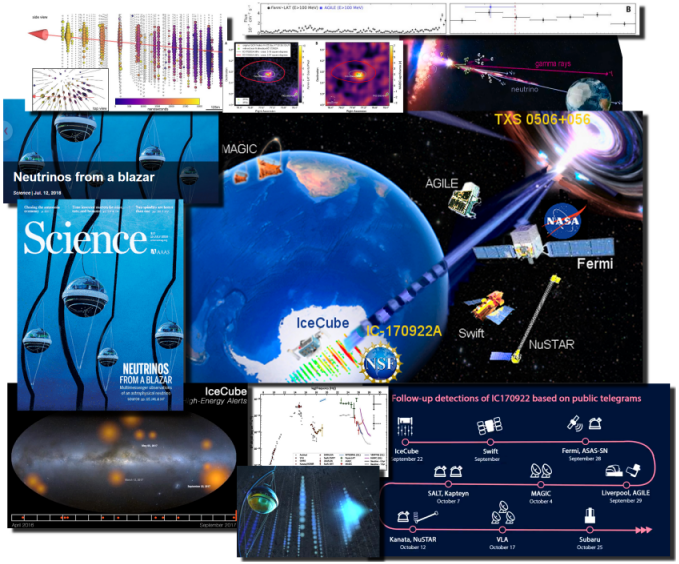 Figure collage credits: SCIENCE magazine/American Association for the Advancement of Science (AAAS), SCIENCE Communication Lab, IceCube Collaboration, NSF U.S. National Science Foundation-Office of Polar Programs, NSF U.S. National Science Foundation-Physics Division, University of Wisconsin-Madison, National Aeronautics and Space Administration (NASA), NASA's Goddard Space Flight Center/CI Lab, NASA/DOE/Fermi Large Area Telescope Collaboration, Sonoma State University, MAGIC Collaboration, AGILE Collaboration, PGC/NASA U.S. Geological Survy Data SIO,NOAA, U.S. Navy, NGA, GEBCO Landsat/Copernicus, Jamie Yang, Savannah Guthrie, Nicolle R. Fuller, Aurore Simonnet. | | Jul 04, 2018 | AGILE detection of prolonged and intense gamma-ray emission from Cygnus X-3
New ATel issued: ATel #11814 (G. Piano et al.).
| | Jul 02, 2018 | AGILE detection of enhanced gamma-ray emission from Cygnus X-3
New ATel issued: ATel #11804 (G. Piano et al.).
| | Jun 26, 2018 | 16th AGILE Scientific Workshop: presentations available
We are pleased to announce that all the presentations authorized for distribution given during the 16th AGILE Workshop "Fast and AGILE: Multimessenger Astrophysics and Beyond" (ASI, 18 May, 2018), are now publicly available.
The slides (pdf format) may be viewed, together with the final program and the recorded videos of the event, at the Workshop web site. On behalf of the Workshop SOC and LOC, we thank very much all the participants.
| | Jun 21, 2018 | New AGILE Public Data now available up to May 31, 2018
We announce the publication of new AGILE gamma-ray data. The public AGILE archive now contains all data from December 1, 2007 to May 31, 2018, i.e. from the start of Cycle-1 up to the on-going Cycle-11. AGILE-GRID event files (EVT) and spacecraft auxiliary (LOG) files are available from the SSDC Multimission Archive (MMIA) webpage for the AGILE Mission.
We recall that, starting from October 2015 the standard one-year proprietary period was eliminated, and all AGILE-GRID data are now published as soon as they are processed and validated. The new public AGILE Cycle-11 data were obtained with AGILE observing a large portion of the sky in spinning mode, and they have been processed with the latest public software and calibrations.
For an easy on-line AGILE data analysis, we recall that the interested user may also query the entire public AGILE level 3 (LV3) archive through the AGILE-LV3 data analysis tool.
| | Jun 05, 2018 | AGILE detection of enhanced gamma-ray emission from the blazar 3C 279
New ATel issued: ATel #11687 (M. Cardillo et al.).
| | May 29, 2018 | AGILE/MCAL detection of GRB 180529 and a possible precursor
New GCN issued: GCN #22741 (A. Ursi et al., on behalf of the AGILE Team).
| | Apr 20, 2018 | AGILE detection of prolonged gamma-ray emission from the Galactic Nova ASASSN-18fv
New ATel issued: ATel #11553 (G. Piano et al.).
| | Apr 06, 2018 | New AGILE Public Data Now Available up to December 31, 2017
We are pleased to announce the publication of new AGILE gamma-ray data.
The public AGILE archive now contains all data from December 1, 2007 to December 31, 2017, i.e. from the start of Cycle-1 up to the start of the on-going Cycle-11. AGILE-GRID event files (EVT) and spacecraft auxiliary (LOG) files are available from the SSDC Multimission Archive (MMIA) webpage for the AGILE Mission.
We recall that, starting from October 2015 the standard one-year proprietary period was eliminated, and all AGILE-GRID data are now published as soon as they are processed and validated. The new AGILE Cycle-10 and Cycle-11 data which become public today were obtained with AGILE observing a large portion of the sky in spinning mode, and they have been processed with the latest available software and calibrations.
For an easy on-line AGILE data analysis, the interested user may also query the entire public AGILE level 3 (LV3) archive through the AGILE-LV3 data analysis tool. By simply entering in the AGILE-LV3 web form the source name or coordinates of the object of interest and clicking on one of the 'Interactive Analysis' buttons on the query-result table, the user can execute the official AGILE Maximum Likelihood (ML) analysis in each available time bin of the chosen duration (default is 28 days).
By selecting more than one time bin, with a click of the mouse it is also possible to generate in few minutes the complete gamma-ray light curve above 100 MeV over the selected period with default analysis parameters.
The AGILE-LV3 tool is meant to be easily comprehensible, even without many instructions and it does not require any install-on-premises software or calibrations. Your feedback will be greatly appreciated.
| | Mar 13, 2018 | AGILE confirms enhanced gamma-ray emission from the Crab Nebula
New ATel issued: ATel #11415 (A. Bulgarelli et al.).
| | Jan 24, 2018 | AGILE observations of gamma-ray emission from the blazar PKS B1424-418
New ATel issued: ATel #11222 (A. Ursi et al.).
| | Jan 19, 2018 | AGILE observations of intense gamma-ray emission from the blazar 3C 279
New ATel issued: ATel #11200 (F. Lucarelli et al.).
| | Jan 12, 2018 | GRB 180111A: AGILE/MCAL detection
New GCN issued: GCN #22321 (F. Verrecchia et al., on behalf of the AGILE Team).
| | Jan 04, 2018 | AGILE detection of a rebrightening of the gamma-ray source AGL J2251-1239
New ATel issued: ATel #11127 (G. Piano et al.).
| | Dec 31, 2017 | AGILE detection of a rapid gamma-ray flare from the blazar 3C 279
New ATel issued: ATel #11115 (C. Pittori et al.).
| | Dec 27, 2017 | GRB 171227A: AGILE/MCAL detection
New GCN issued: GCN #22288 (F. Verrecchia et al., on behalf of the AGILE Team).
| | Dec 18, 2017 | AGILE detection of gamma-ray emission from the FSRQ Ton 0599
New ATel issued: ATel #11073 (A. Bulgarelli et al.).
| | Dec 09, 2017 | AGILE detection of increasing gamma-ray activity from CTA 102
New ATel issued: ATel #11045 (F. Lucarelli et al.).
| | Dec 08, 2017 | AGILE detection of gamma-ray activity from the source AGL J2251-1239
New ATel issued: ATel #11043 (F. Lucarelli et al.).
| | Nov 24, 2017 | Enhanced gamma-ray emission from the FSRQ PKS 0131-522
New ATel issued: ATel #11003 (G. Piano et al.).
| | Nov 13, 2017 | Early AGILE gamma-ray observations of the recent Glitch in the Crab Pulsar
New ATel issued: ATel #10965 (F. Verrecchia et al.).
| | Nov 08, 2017 | AGILE detection of transient gamma-ray activity from the FSRQ Ton 599
New ATel issued: ATel #10937 (G. Piano et al.).
| | Sep 29, 2017 | AGILE confirmation of gamma-ray activity from the IceCube-170922A error region
New ATel issued: ATel #10801 (F. Lucarelli et al.).
| | Aug 25, 2017 | GRB 170825A: AGILE/MCAL Detection
New GCN issued: GCN #21689 (M. Cardillo et al., on behalf of the AGILE Team).
| | Aug 07, 2017 | AGILE detection of an unknown gamma-ray source AGL J1412-0522
New ATel issued: ATel #10623 (G. Piano et al.).
| | Jul 31, 2017 | AGILE Cycle-10 Public Data Now Available and New On-line AGILE-LV3 Analysis Tool
AGILE Cycle-10 data up to the June 30, 2017 are now publicly available, according to the current AGILE scientific data policy. Starting from October 2015 all AGILE-GRID data are published as soon as they are processed and validated.
The new public AGILE archives now contain all data from the start of Cycle-1 on December 1, 2007 Observation Block (OB) 4900, up to the first half of Cycle-10, OB 26500. AGILE Level 2 archive (STD1) of event lists and ancillary files is available from the Multimission Archive (MMIA) webpage for the AGILE Mission..
We are pleased to announce also the publication of the AGILE-LV3 data analysis tool, which provides an easy web interface for interactive on-line analysis on AGILE-GRID data, based on the official AGILE scientific software release. It does not require any install-on-premises software or calibrations.
The user may query the entire new public AGILE Level 3 archive (STD1Kal) of counts, exposure and diffuse gamma-ray maps by simply entering in the AGILE-LV3 web form the source name or coordinates of the object of interest. From the query-result table, by clicking on one of the 'Interactive Analysis' buttons the user can execute the AGILE Maximum Likelihood (ML) analysis at the source coordinates. By selecting more than one time bin, with a click of the mouse it is also possible to generate in few minutes the complete gamma-ray light curve above 100 MeV over the selected period with default analysis parameters (default is 28-day timebins).
| | Jul 07, 2017 | AGILE detection of a gamma-ray flare from the blazar 3C 279
New ATel issued: ATel #10563 (A. Bulgarelli et al.).
| | Jul 07, 2017 | Renewed gamma-ray emission from the FSRQ CTA 102 detected by AGILE
New ATel issued: ATel #10560 (A. Bulgarelli et al.).
| | Jun 06, 2017 | AGILE detection of enhanced gamma-ray activity from BL Lacertae
New ATel issued: ATel #10469 (G. Piano et al.).
| | May 18, 2017 | Enhanced gamma-ray emission from the FSRQ CTA 102 detected by AGILE
New ATel issued: ATel #10386 (G. Minervini et al.).
| | Apr 18, 2017 | AGILE detection of enhanced gamma-ray activity from a new unidentified source, AGL J0523+0646
New ATel issued: ATel #10282 (F. Lucarelli et al.).
| | Mar 17, 2017 | Enhanced Gamma-Ray Emission from the Microquasar Cygnus X-3 Detected by AGILE
New ATel issued: ATel #10179 (G. Piano et al.).
| | Mar 01, 2017 | AGILE Detection of Enhanced Gamma-Ray Emission from the Microquasar Cygnus X-3
New ATel issued: ATel #10138 (G. Piano et al.).
| | Feb 27, 2017 | All AGILE Data up to the end of Cycle-9 are now publicly available
In 2015 the AGILE Mission Board suggested a change in the AGILE gamma-ray scientific data policy.
The standard one-year proprietary period requirement was eliminated, and starting from October 2015 all AGILE-GRID data are published as soon as they are processed and validated.
The new public AGILE archive now contains all data from the start of Cycle-1 on December 1, 2007 Observation Block (OB) 4900, up to the end of Cycle-9 on November 30, 2016, OB 25100.
Data are available from the ASDC Multimission Archive (MMIA) webpage for the AGILE Mission..
The query to the archive give access to all AGILE public data through an interactive webpage including the ASDC "Interactive Analysis" tool. The tool allows web users to preview the AGILE data fields, and to perform a preliminary analysis around a chosen sky position.
| | Jan 27, 2017 | GRB 170127C (Fermi/GBM trigger 507173752): AGILE analysis
New GCN issued: GCN #20545 (A. Ursi et al., on behalf of the AGILE Team).
| | Jan 25, 2017 | GRB 170115B: AGILE/SuperAGILE localisation
New GCN issued: GCN #20525 (Y. Evangelista et al., on behalf of the AGILE Team).
| | Jan 17, 2017 | GRB 170115B: AGILE detection
New GCN issued: GCN #20474 (F. Verrecchia et al., on behalf of the AGILE team).
| | Jan 04, 2017 | AGILE confirmation of enhanced gamma-ray activity from NGC 1275
New ATel issued: ATel #9934 (F. Lucarelli et al.).
| | Dec 29, 2016 | AGILE detection of renewed and intense gamma-ray flaring from the FSRQ CTA 102
New ATel issued: ATel #9911 (A. Bulgarelli et al.).
| | Dec 14, 2016 | AGILE detection of intense gamma-ray emission from the FSRQ CTA102
New ATel issued: ATel #9863 (A. Bulgarelli et al.).
| | Dec 09, 2016 | AGILE detection of a new episode of enhanced gamma-ray emission from the FSRQ CTA102
New ATel issued: ATel #9840 (F. Verrecchia et al.).
| | Nov 24, 2016 | AGILE detects renewed gamma-ray emission from the FSRQ CTA 102
New ATel issued: ATel #9788 (A. Bulgarelli et al.).
| | Nov 11, 2016 | AGILE detection of enhanced gamma-ray emission from the FSRQ CTA 102
New ATel issued: ATel #9743 (G. Minervini et al.).
| | Oct 14, 2016 | AGILE detection of transient emission from the FSRQ TXS 0907+230 region
New ATel issued: ATel #9623 (P. Munar-Adrover et al.).
| | Oct 12, 2016 | New episode of enhanced gamma-ray emission from the Crab Nebula detected by AGILE
New ATel issued: ATel #9617 (P. Munar-Adrover et al.).
| | Oct 3, 2016 | Enhanced gamma-ray emission from the Crab Nebula detected by AGILE
New ATel issued: ATel #9586 (A. Bulgarelli et al.).
| | Sep 21, 2016 | PKS 1510-089 in high gamma-ray state as detected by AGILE
New ATel issued: ATel #9520 (G. Minervini et al.).
| | Sep 4, 2016 | Renewed Gamma-Ray Emission from the blazar PKS 1510-089 Detected by AGILE
New ATel issued: ATel #9450 (P. Munar-Adrover et al.).
| | Aug 30, 2016 | AGILE Detection of Gamma-Ray Emission from the Microquasar Cygnus X-3
New ATel issued: ATel #9429 (G. Piano et al.).
| | Aug 09, 2016 | Renewed gamma-ray activity from the blazar PKS 1510-089 detected by AGILE
New ATel issued: ATel #9350 (C. Pittori et al.).
| | Aug 01, 2016 | AGILE follow-up of the neutrino ICECUBE-160731 event
New ATel issued: ATel #9295 (F. Lucarelli et al.).
| | Jul 11, 2016 | AGILE detection of enhanced gamma-ray emission from the FSRQ 4C +01.02
New ATel issued: ATel #9232 (F. Verrecchia et al.).
| | June 28, 2016 | ASDC participation to high-school outreach program
In mid June 2016, twenty high-school students from Liceo Classico "Aristofane" and Liceo Classico "Giulio Cesare" of Rome, spent one week at the Headquarters of the Italian Space Agency (ASI) to participate to the "Alternanza Scuola-Lavoro" (School and Work synergy) project, according to the new indications of the Italian Ministry for Education, University and Research (MIUR) aimed at giving a real work experience to high-school students.
On June 17, 2016, the students used ASDC tools to analyze data coming from both Solar System exploration and Universe observation missions, under the guide of Stefano Ciprini, Dario Gasparrini, Fabrizio Lucarelli, Carlotta Pittori and Angelo Zinzi.
After a brief introduction by Ciprini and Pittori on the astrophysical observations of the Universe, and by Zinzi on the exploration of the Solar System, the students were divided into four groups of five persons each. The students chose their preferred field of analysis, so that two groups used planetology ASDC tools and the other two groups used Universe observation ASDC tools.
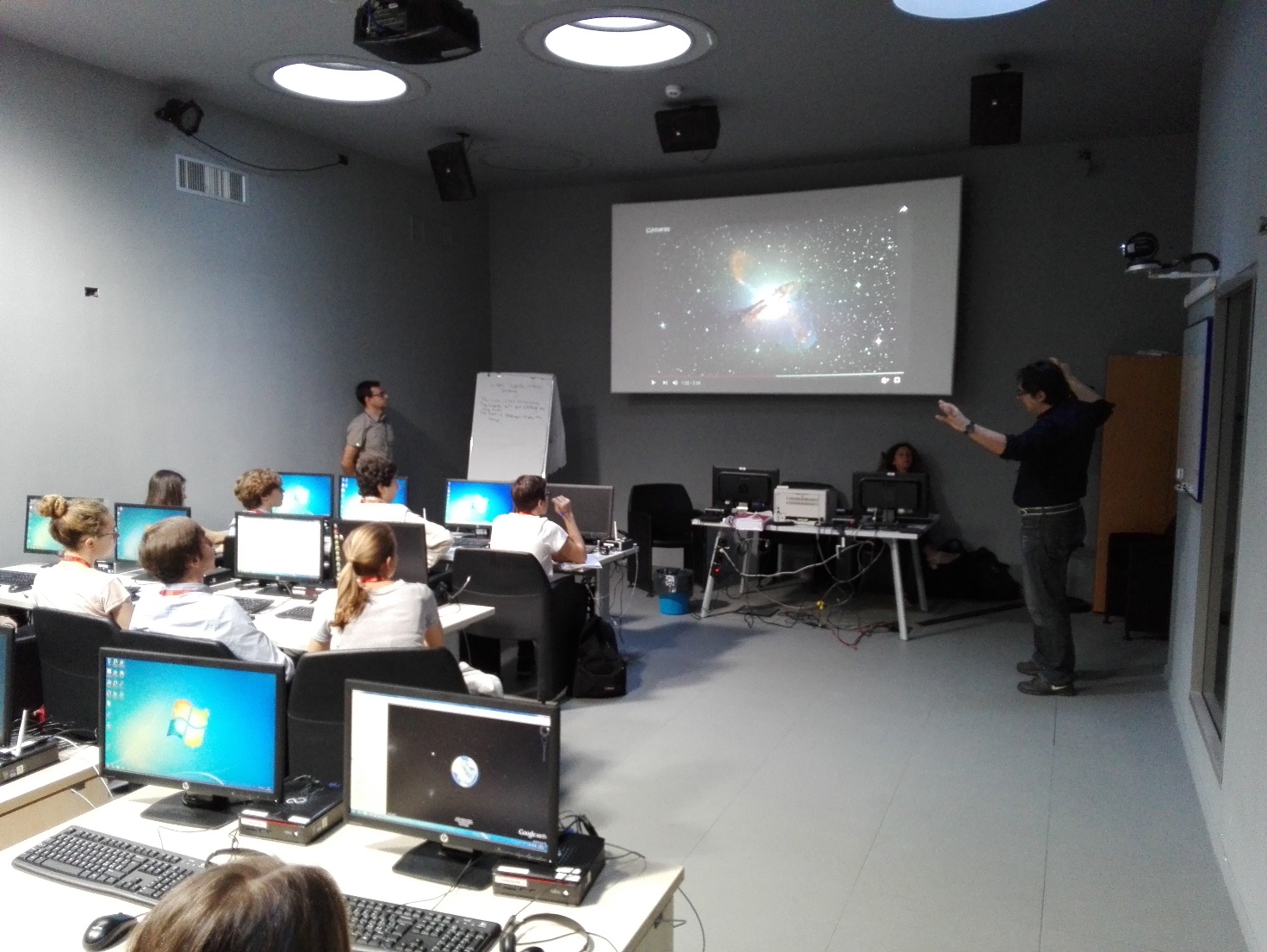
Stefano Ciprini and Carlotta Pittori introducing the subject of Active Galactic Nuclei (AGN) observations.
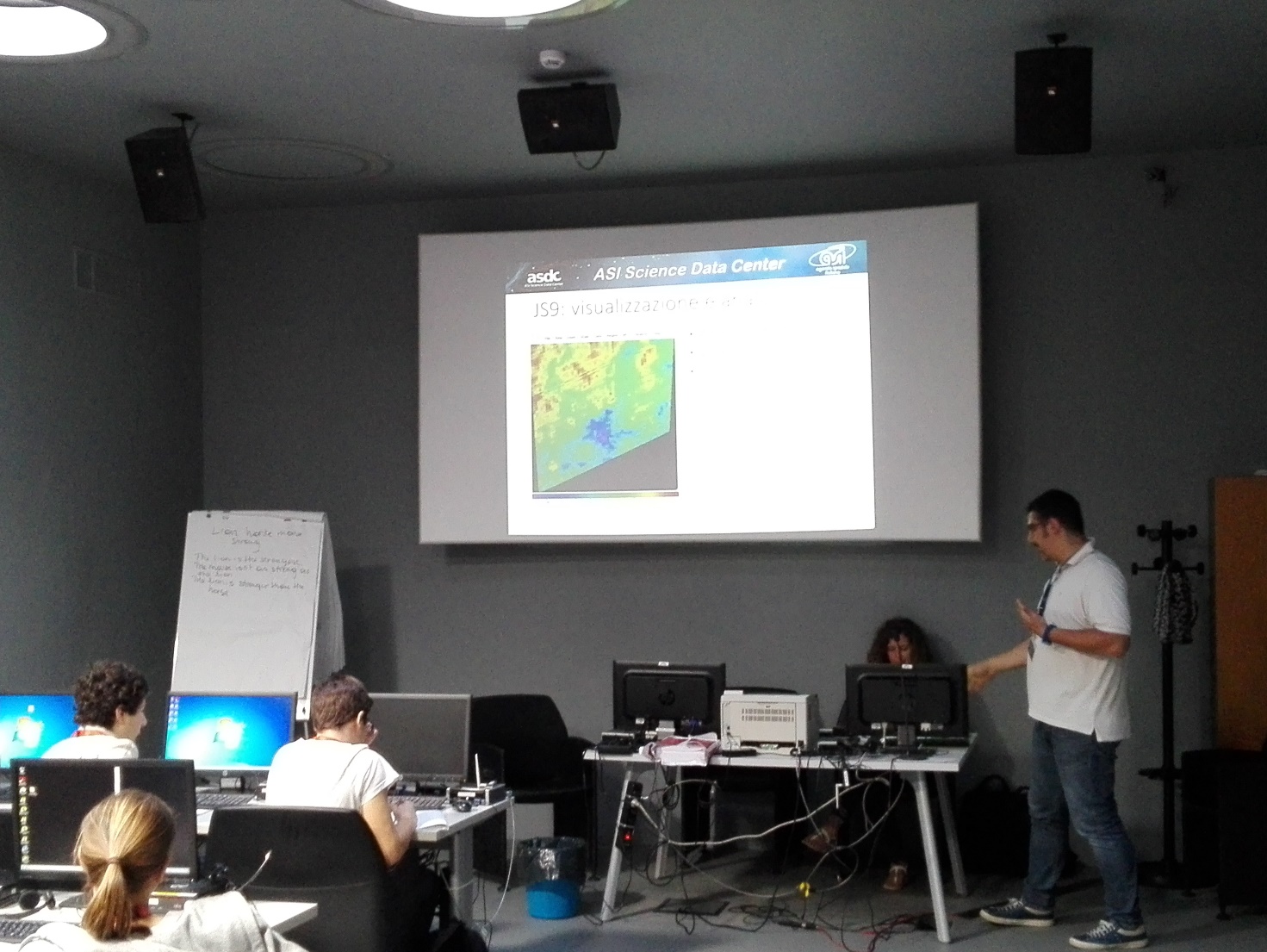
Angelo Zinzi talking about the use of infrared spectra for mineralogic analysis on asteroids.
The planetological analysis was carried out by looking at data acquired by VIR spectrometer onboard NASA Dawn mission over the asteroid Vesta. The search for the data was conducted using the ASDC tool MATISSE, whose output (in FITS format) was then passed on to the JS9 tool to evaluate the 1.98 μm band depth, on the basis of the work by Palomba et al. (2015) devoted to the characterization of dark units on Vesta.
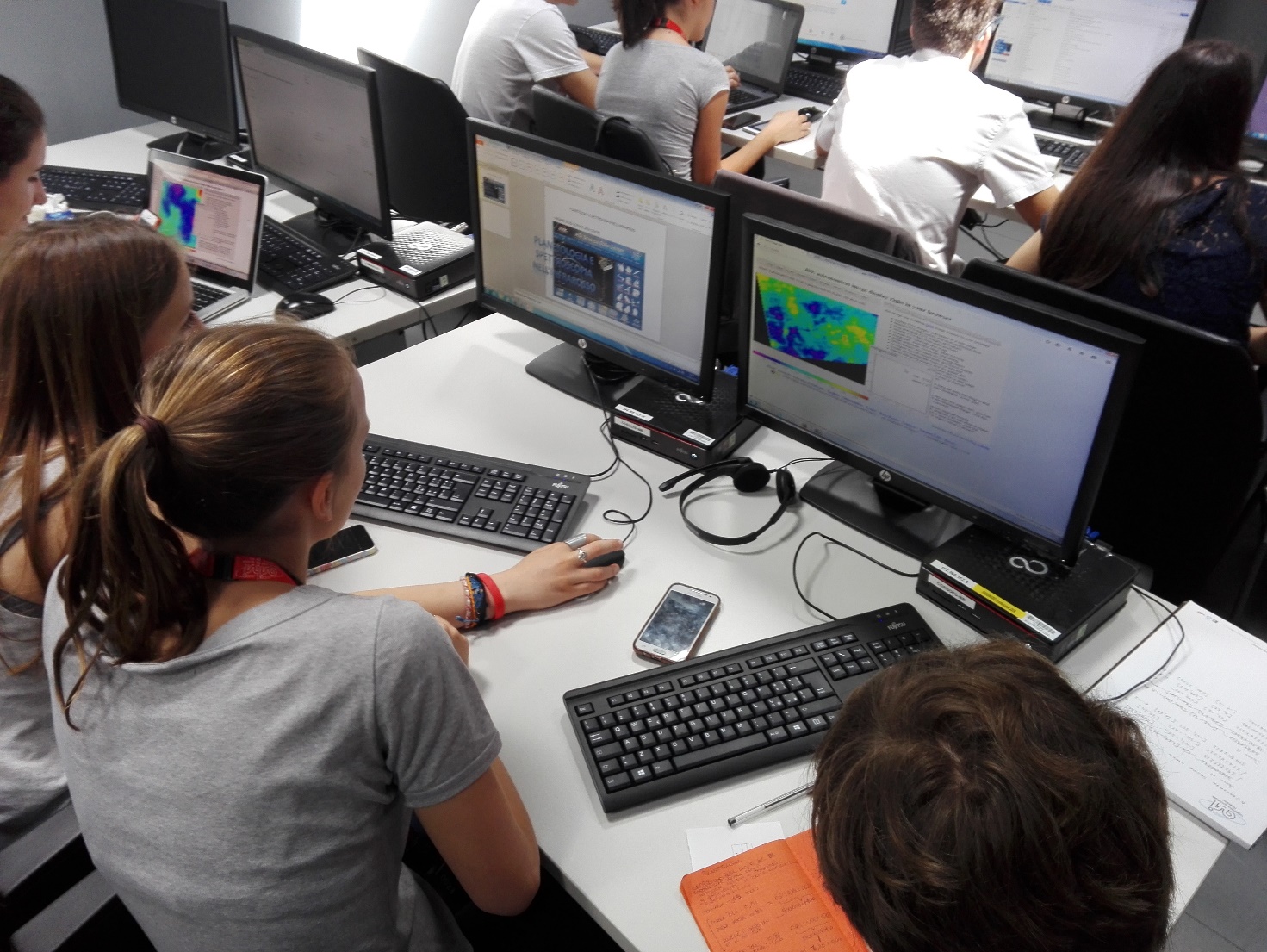
Students working with planetological data
The groups of students who chose to use the Universe observation tools from ASDC had to replicate the analysis of a couple of exceptional bright flares seen in gamma-rays from the AGILE satellite from the two AGNs PKS 1510-059 and 3C 279. Starting from the AGILE Astronomer's Telegrams (ATels) #6366 and #7631, announcing the dramatic gamma-ray enhancements, they identified the period of AGN activity and searched the correspondent AGILE data from the MMIA Archive. For this special occasion, we provided the students with access to the AGILE LV3 online analysis tool accessible through the ASDC web pages (the tool will soon become public). They very easily familiarized with the tool and, by means of that, they were able to produce a sky map and a light curve of the two sources, showing the rapid increase in gamma-ray flux observed in correspondence of the period reported in the ATels.
At the end of the day, the students compiled a "Daily Log" with all the capabilities acquired during the work.
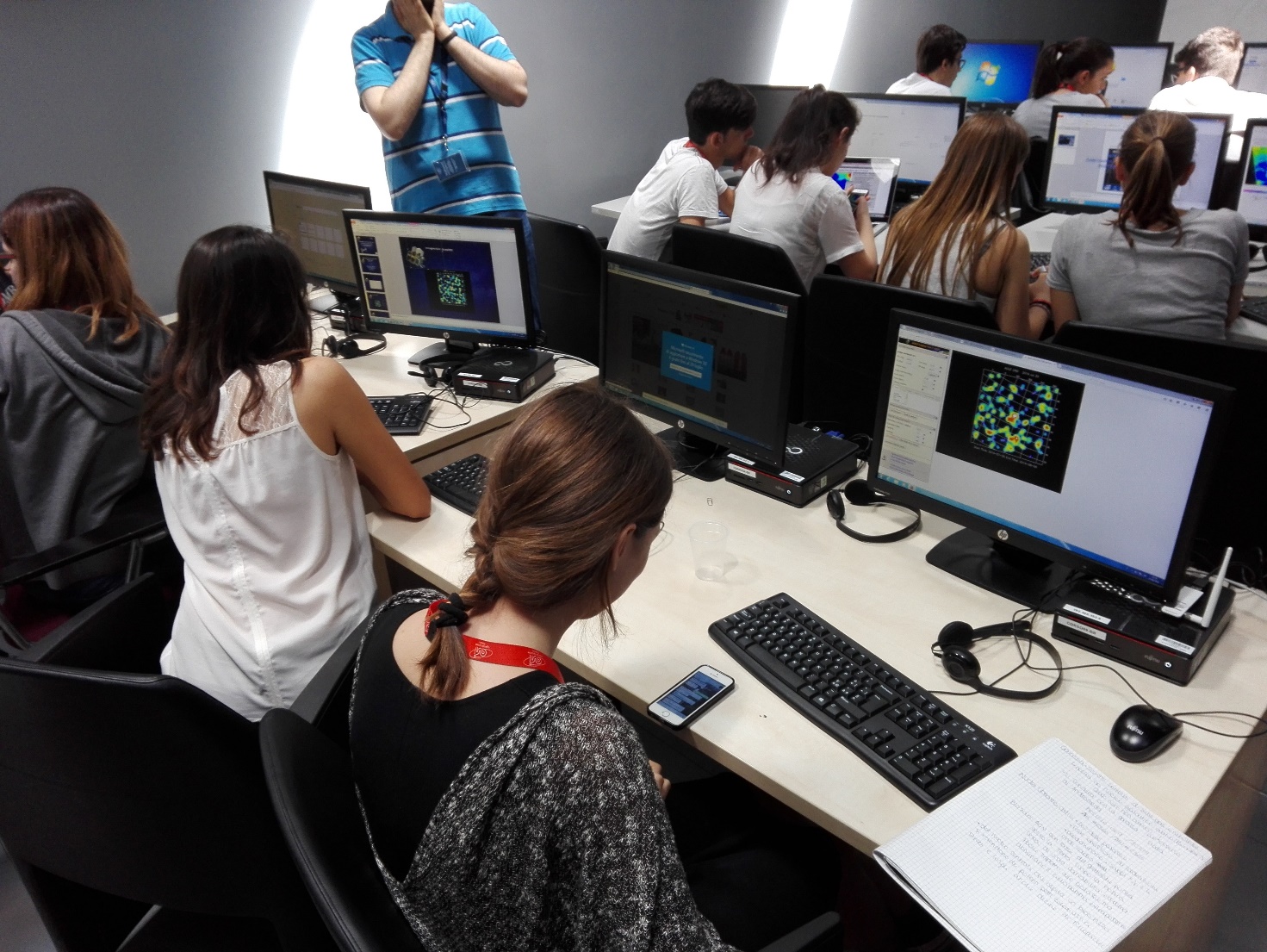
Students analysing AGN data
| | Jun 24, 2016 | A gamma-ray flare from 3C 454.3 detected by AGILE
New ATel issued: ATel #9186 (G. Munar-Adrover et al.).
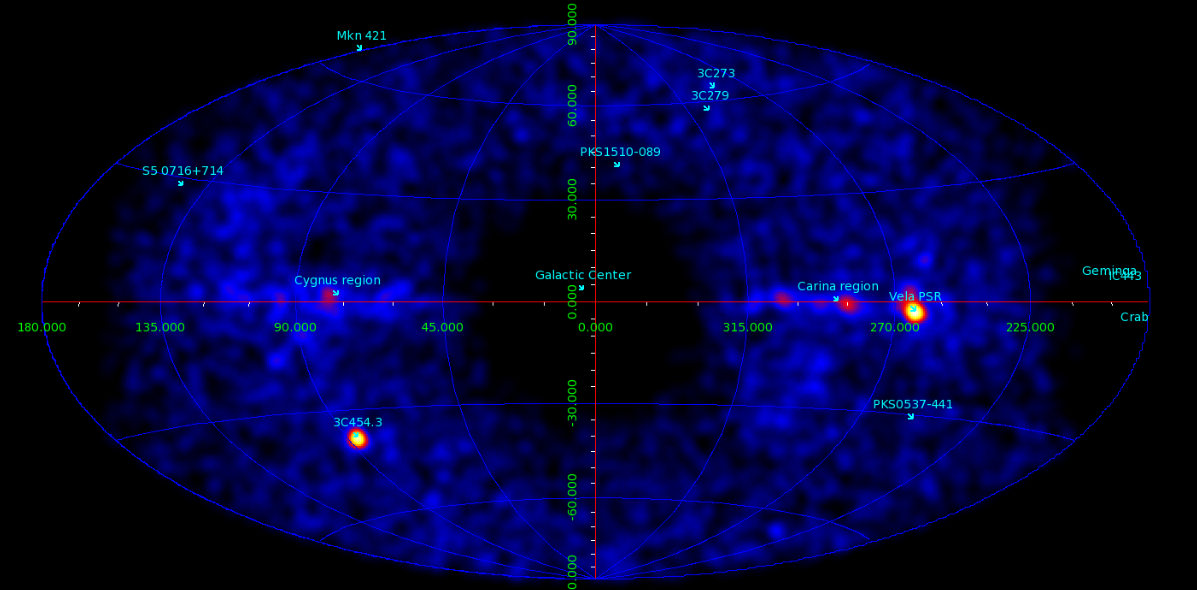
AGILE-GRID sky map (E >100 MeV) in Aitoff projection during the period 22-24 June, 2016, showing the 3C 454.3 flare.
| | Jun 21, 2016 | Renewed gamma-ray activity of the Blazar 3C 454.3 detected by AGILE
New ATel issued: ATel #9176 (A. Bulgarelli et al.).
| | Jun 18, 2016 | AGILE confirmation of enhanced gamma-ray activity from the Blazar 1ES 1959+650
New ATel issued: ATel #9168 (F. Lucarelli et al.).
| | Jun 15, 2016 | AGILE detection of increasing gamma-ray activity from the Blazar 3C 454.3
New ATel issued: ATel #9157 (F. Lucarelli et al.).
| | Apr 20, 2016 | AGILE detection of enhanced gamma-ray activity from a new unidentified source at high Galactic latitude, AGLJ0917+1511
New ATel issued: ATel #8974 (F. Lucarelli et al.).
| | Apr 19, 2016 | Enhanced gamma-ray emission from the microquasar Cygnus X-3 detected by AGILE
New ATel issued: ATel #8970 (G. Piano et al.).
| | Apr 16, 2016 | AGILE confirmation of enhanced gamma-ray emission from the FSRQ PKS 2023-07
New ATel issued: ATel #8960 (F. Verrecchia et al.).
| | Apr 8, 2016 | AGILE detection of gamma-ray activity from the FSRQ S5 1039+81 region
New ATel issued: ATel #8925 (A. Bulgarelli et al.).
| | Mar 28, 2016 | AGILE detection of a gamma-ray flare from the FSRQ PKS 2023-07
New ATel issued: ATel #8879 (G. Piano et al.).
| | Mar 25, 2016 | A new gamma-ray transient, AGL J1835-6040, detected by AGILE
New ATel issued: ATel #8866 (C. Pittori et al.).
| | Jan 27, 2016 | AGILE confirms the enhanced gamma-ray emission from Cygnus X-3
New ATel issued: ATel #8597 (M. Tavani et al.).
| | Jan 27, 2016 | AGILE detection of renewed gamma-ray activity from the blazar PKS 1502+106
New ATel issued: ATel #8593 (C. Pittori et al.).
| | Jan 12, 2016 | AGILE detection of increased gamma-ray emission from the FSRQ PKS 1313-333
New ATel issued: ATel #8536 (A. Lucarelli et al.).
| | Dec 30, 2015 | AGILE detection of enhanced gamma-ray activity from the CTA 102 region
New ATel issued: ATel #8476 (A. Bulgarelli et al.).
| | Nov 28, 2015 | Increasing gamma-ray activity from the FSQR 4C +40.25
New ATel issued: ATel #8344 (G. Piano et al.).
| | Nov 10, 2015 | Renewed gamma-ray activity of the high-redshift quasar 0836+71 (4C 71.07)
New ATel issued: ATel #8266 (C. Pittori et al.).
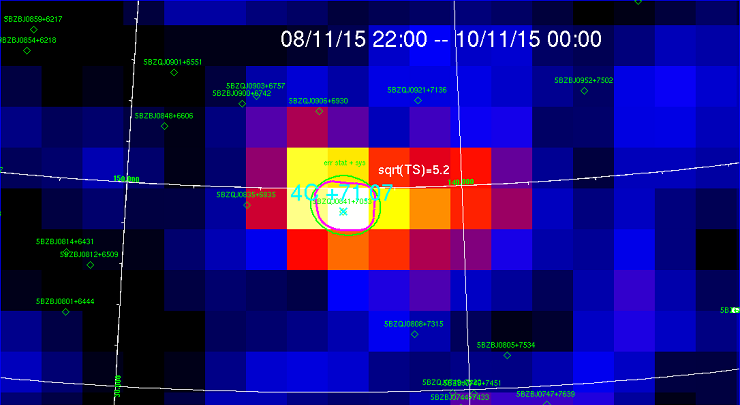
AGILE intensity map (E >100 MeV) of the 4C +71.07 field during the flare, on a 26-hours integration time from 2015-11-08 22:00 UT to 2015-11-10 00:00 UT.
| | Oct 29, 2015 | AGILE detection of enhanced gamma-ray activity from the S5 0836+71 (4C +71.07) region
New ATel issued: ATel #8223 (A. Bulgarelli et al.).
| | Oct 06, 2015 | New AGILE data distribution policy and new public data up to June 30, 2015
A change in AGILE gamma-ray scientific data policy was suggested by the Mission Board and it has been approved by ASI. To strengthen the engagement of the Scientific Community during the extended lifetime of the AGILE mission the standard one-year proprietary period was eliminated.
Starting from October 5, 2015, all AGILE-GRID data will be published as soon as they will be processed and validated, about 4 times a year.
The new public AGILE archive now contains all data from December 1, 2007 up to June 30, 2015. AGILE data are available as usual from the ASDC Multimission Archive (MMIA) webpage for the AGILE Mission.
| | Oct 06, 2015 | AGILE detection of enhanced gamma-ray activity from a source at high Galactic coordinates, AGLJ1948-7906
New ATel issued: ATel #8129 (A. Bulgarelli et al.).
| | Sep 29, 2015 | "Sigillo d'Argento" lifetime career award of the Trieste Province to Prof. Guido Barbiellini Amidei for his outstanding scientific and academic achievements
On Monday September 28, 2015 Prof. Guido Barbiellini Amidei, currently co-Principal Investigator of the AGILE Mission of the Italian Space Agency and one of the founding members of the NASA international experiment Fermi, has been awarded the honor of the "Sigillo" of the Province of Trieste.
Prof. Barbiellini Amidei, full professor at the Physics Department of the Trieste University, currently retired, has a long experience in the field of elementary particles and of high-energy astrophysics of cosmic radiation.
Both AGILE and Fermi instruments use silicon detectors, precisely proposed for a space application by Prof. Barbiellini Amidei in 1987. His many students and colleagues have always admired his working method and his team-working attitude in common projects, often following his original intuitions.
For further information see MEDIA INAF and ASI News.

| | Jun 22, 2015 | AGILE detection of enhanced gamma-ray activity from BL Lacertae
New ATel issued: ATel #7687 (F. Lucarelli et al.).
| | Jun 15, 2015 | AGILE detection of a bright gamma-ray flare from the blazar 3C 279
New ATel issued: ATel #7631 (F. Lucarelli et al.).
| | Jun 04, 2015 | Renewed gamma-ray activity of the FSRQ PKS 2032+107 detected by AGILE
New ATel issued: ATel #7589 (F. Lucarelli et al.).
| | May 20, 2015 | AGILE detects the new gamma-ray source AGL J0134-3340
New ATel issued: ATel #7539 (G. Piano et al.).
| | Apr 29, 2015 | Confirmation by AGILE of increased gamma-ray emission from the FSRQ PKS 2032+107
New ATel issued: ATel #7457 (C. Pittori et al.).
| | Mar 17, 2015 | AGILE detects enhanced gamma-ray activity from the radio galaxy NGC 1275 region
New ATel issued: ATel #7239 (F. Verrecchia et al.).
| | Mar 15, 2015 | AGILE detection of an unidentified gamma-ray source at low Galactic latitude, AGLJ2251+6454
New ATel issued: ATel #7227 (A. Bulgarelli et al.).
| | Mar 09, 2015 | AGILE detects enhanced gamma-ray emission above 100 MeV from the blazar BZQ J0447-0322 region
New ATel issued: ATel #7193 (C. Pittori et al.).
| | Feb 27, 2015 | AGILE detects enhanced gamma-ray emission above 100 MeV from the blazar S4 0554+58 region
New ATel issued: ATel #7155 (F. Lucarelli et al.).
| | Jan 20, 2015 | AGILE satellite: 40.000th orbit around the Earth successfully completed
On January 19, 2015 at 05:49:25 UTC the AGILE satellite successfully completed its 40.000th pass over the ASI Malindi Ground Station.
Launched April 23, 2007 in low Earth orbit, AGILE is working nominally after almost 8 years. The Italian satellite continues its exploration of the high-energy Universe, also giving a crucial contribution to the study of extreme Terrestrial atmospheric events (TGFs).
All AGILE data are regularly received and processed at the AGILE Data Center at ASDC, where the public archive now contains all observations from December 1, 2007 up to November 30, 2013. The data are available from the ASDC Multimission Archive webpage for the AGILE Mission.
Also read: "Le 40mila orbite di Agile", ASI news (in italian).
| | Dec 22, 2014 | All AGILE Cycle-6 Public Data Now Available
The proprietary period for all AGILE Cycle-6 Observation Blocks, up to 2013-11-30 (from OB 15600 to OB 17900) has currently expired. The data are now public and available from the ASDC Multimission Archive (MMIA) webpage for the AGILE Mission.
AGILE Cycle-6 data were obtained with AGILE observing a large portion of the sky in spinning mode, and they have been processed with the latest available software and calibrations.
The new public archive now contains all AGILE data from December 1, 2007 up to November 30, 2013 (from Cycle-1 to Cycle-6).
The query to the archive give access to all AGILE public data through an interactive webpage including the ASDC "Interactive Analysis" tool. The tool allows web users to preview the AGILE data fields, and to perform a preliminary analysis around a chosen sky position.
| | Nov 22, 2014 | AGILE detection of intense gamma-ray emission above 100 MeV from the blazar 4C+21.35 (PKS 1222+21)
New ATel issued: ATel #6733 (F. Verrecchia et al.).
| | Oct 01, 2014 | AGILE Cycle-6 Public Data Now Available
The proprietary period for the first AGILE Cycle-6 Observation Blocks, up to 2013-06-30 (from OB 15600 to OB 16900) has currently expired. The data are now public and available from the ASDC Multimission Archive (MMIA) webpage for the AGILE Mission.
AGILE Cycle-6 data were obtained with AGILE observing a large portion of the sky in spinning mode, and they have been processed with the latest available software and calibrations.
The query to the archive give access to all AGILE public data through an interactive webpage including the ASDC "Interactive Analysis" tool. The tool allows web users to preview the AGILE data fields, and to perform a preliminary analysis around a chosen sky position.
| | Sep 10, 2014 | AGILE detects enhanced gamma-ray emission from the FSRQ PKS 0502+049
New ATel issued: ATel #6457 (F. Lucarelli et al.).
| | Aug 28, 2014 | A new gamma-ray transient, AGL J1608-5253, detected by AGILE in the Galactic Plane
New ATel issued: ATel #6427 (F. Verrecchia et al.).
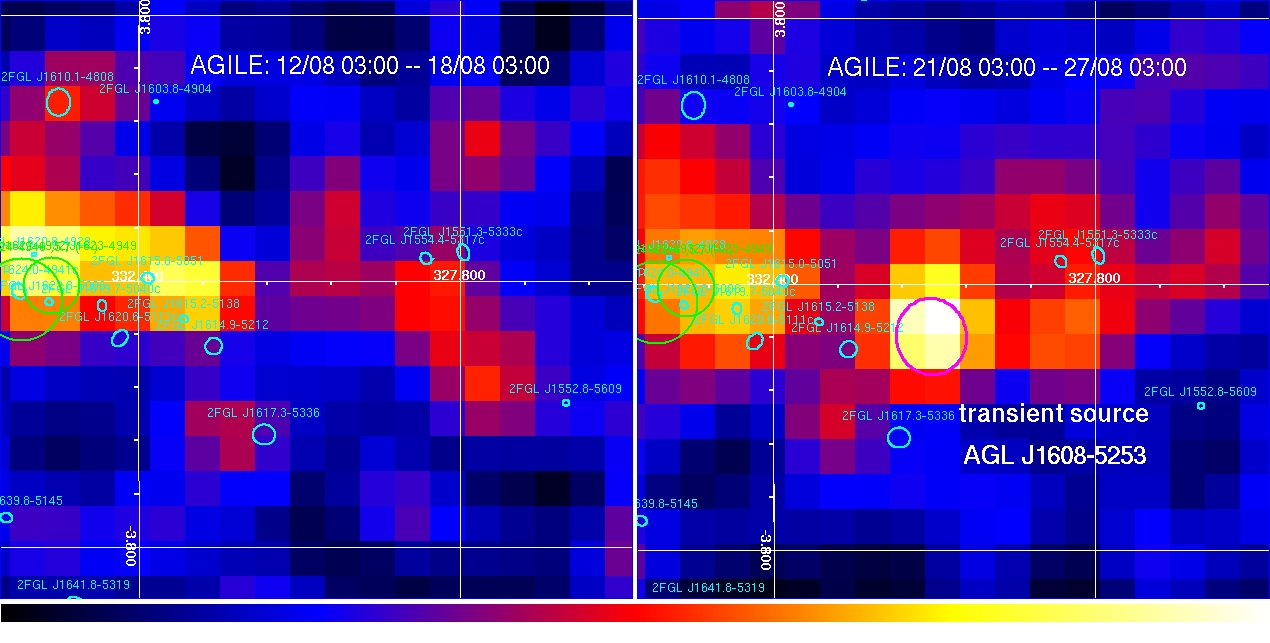
AGILE 6-day intensity map (E> 100 MeV) of the transient source region during the flare on August 21-27, 2014, and before it on August 12-18 2014.
| | Aug 03, 2014 | AGILE detection of a flare from PKS 1510-089
New ATel issued: ATel #6366 (A. Bulgarelli et al.).
| | Aug 03, 2014 | AGILE detection of a flare from the FSRQ 3C 279
New ATel issued: ATel #6365 (A. Bulgarelli et al.).
| | Jun 14, 2014 | Increasing gamma-ray activity of the Blazar 3C 454.3 detected by AGILE
New ATel issued: ATel #6234 (A. Bulgarelli et al.).
| | Jun 13, 2014 | AGILE detection of a gamma-ray flare from the PSR B1259-63 region
New ATel issued: ATel #6231 (C. Pittori et al.).
| | Jun 09, 2014 | Renewed gamma-ray activity of the Blazar 3C 454.3 detected by AGILE
New ATel issued: ATel #6217 (F. Verrecchia et al.).
| | Jun 05, 2014 | IPN Triangulation of GRB 140604A (short/hard)
New GCN issued: GCN #16350 (S. Golenetskii et al.; G. Di Cocco, F. Fuschino, M. Galli, C. Labanti, and M. Marisaldi, on behalf of the AGILE MCAL team).
| | May 28, 2014 | AGILE detects enhanced gamma-ray activity of the Blazar 3C 454.3
New ATel issued: ATel #6182 (F. Verrecchia et al.).
| | May 16, 2014 | 12th AGILE Scientific Workshops: presentations now available.
We are pleased to announce that all the presentations authorized for distribution given during the 12th AGILE Workshops "ASTRO-EARTH: astrophysics and high-energy terrestrial phenomena" (8-9 May, 2014), are now publicly available.
The slides (pdf format) may be viewed, together with the final program, at the Workshops web sites:
https://www.ssdc.asi.it/12thagilemeeting/
On behalf of the Workshops SOC and LOC, we thank very much all the participants.
| | Mar 31, 2014 | GRB 140330A: intense and persistent gamma-ray emission detected by AGILE.
New GCN issued: GCN #16058 (C. Pittori et al.)
Following the IPN triangulation of GRB 140330A (GCN #16051) and subsequent gamma-ray data analysis, the high-energy source detected by Fermi (GCN #16048) and by AGILE (GCN #16058) was found to be unrelated to GRB 140330A, and it has been tentatively associated with the extra-galactic radio source PKS 2136-642, as reported in GCN #16062.
| | Feb 12, 2014 | AGILE gamma-ray detection of a new unidentified source in 2010 has led to the discovery of the first ever known Be-BH binary system.
On July 2010 the ASI AGILE gamma-ray satellite recorded an intense and sporadic gamma-ray emission above 100 MeV from a new unidentified source, AGL J2241+4454 (Lucarelli F. et al., ATel #2761).
MWC 656 (also known as HD 215227) is a rapidly spinning Be-type star located within the error circle of the AGL J2241+4454 gamma-ray source, which was identified as its candidate optical counterpart, and proposed as a new member of the small class of gamma-ray emitting binaries (Williams S. J. et al., ApJ 723, 2010).
A recent detailed analysis of the optical spectrum of MWC 656 allowed researchers to infer the characteristics of its companion, that turned out to be an object with a mass between 3.8 and 6.9 solar masses. Such a compact object can only be a black hole, as no neutron star with more than about three solar masses can exist according to current theoretical and observational studies.
This important discovery was recently published in Nature by a group of Spanish scientists (Casares J. et al., Nature 505, 2014). Two of them, Marc Ribò and Josep M. Paredes, members of the Group High Energy Astrophysics at Universitat de Barcelona, have also been AGILE Guest Observers in past ASI Announcements of Opportunity.
| | Jan 15, 2014 | AGILE scientific operations in stand-by since Jan 1st, 2014
On January 1st, 2014 scientific in-orbit operations of the AGILE satellite have been temporarily interrupted. The payload is currently in a "stand-by" state, with only housekeeping telemetry being downlinked on alternate days.
AGILE is now waiting for future ASI decisions about the mission funding.
| | Dec 22, 2013 | Confirmation by AGILE of increased gamma-ray emission from the blazar 3C 279
New ATel issued: ATel #5682 (E. Striani et al.).
| | Nov 22, 2013 | Complete set of AGILE Cycle-5 data now public
The proprietary period for all AGILE Cycle-5 Observation Blocks up to 2012-11-30 (from OB 13200 to OB 15500), has currently expired. The data are now public and available from the ASDC Multimission Archive (MMIA) webpage for the AGILE Mission.
The AGILE-GRID data published today are related to the last 10 AGILE observations of Cycle-5, from 2012-06-30 to 2012-11-30. AGILE Cycle-5 data were obtained with AGILE observing a large portion of the sky in spinning mode, and they have been processed with the latest available software and calibrations.
The query to the archive give access to all AGILE public data from Cycle-1 to Cycle-5 (December 1, 2007 - November 30, 2012), through an interactive webpage including the ASDC "Interactive Analysis" tool. The tool allows web users to preview the AGILE data fields, and to perform a preliminary analysis around a chosen sky position.
| | Nov 09, 2013 | GRB 131108A: AGILE-GRID observation
New GCN issued: GCN #15479 (A. Giuliani et al.)
| | Oct 24, 2013 | After a gamma-ray flare, AGILE detects the Crab Nebula returning to the normal flux level
New ATel issued: ATel #5506 (F. Verrecchia et al.)
| | Oct 17, 2013 | An updated AGILE catalog including source variability in pointing mode has been published
We are pleased to announce that the new AGILE-GRID catalog "An updated list of AGILE bright gamma-ray sources and their variability in pointing mode", is now available here as an interactive web table. In the on-line version of the catalog, the ASDC light curve tool can be accessed from the ASDC Data Explorer.
| | Oct 01, 2013 | AGILE Cycle-5 Public Data Now Available
The proprietary period for 14 AGILE Cycle-5 Observation Blocks, up to 2012-06-30 (from OB 13200 to OB 14500) has currently expired. The data are now public and available from the ASDC Multimission Archive (MMIA) webpage for the AGILE Mission.
AGILE Cycle-5 data were obtained with AGILE observing a large portion of the sky in spinning mode, and they have been processed with the latest available software and calibrations.
The query to the archive give access to all AGILE public data through an interactive webpage including the ASDC "Interactive Analysis" tool. The tool allows web users to preview the AGILE data fields, and to perform a preliminary analysis around a chosen sky position.
| | Sep 26, 2013 | AGILE detection of increasing gamma-ray emission from the blazar PKS 1510-089 following an optical/near-infrared flare
New ATel issued: ATel #5422 (V. Fioretti et al.)
| | Jul 29, 2013 | Significant increase in the gamma-ray emission from the FSRQ 4C +38.41 (BZQ J1635+3808) reported by Fermi and AGILE satellites
New Fermi LAT ATel issued: ATel #5232 (D. Gasparrini et al.)
New AGILE GRID ATel issued: ATel #5234 (F. Lucarelli et al.).
| | Jun 08, 2013 | GRB 130606B: AGILE-MCAL observation
New GCN issued: GCN #14823 (M. Marisaldi et al.).
| | Apr 30, 2013 | GRB 130427A: high energy gamma-ray detection by AGILE and Fermi
AGILE detected high energy emission above 50 MeV with the Gamma-Ray Imaging Detector (GRID) and above 350 keV with the Mini-Calorimeter MCAL) from the long-duration GRB 130427A on April 27, localised by Swift (GCN 14448, Maselli et al.).
Due to the exceptionally high fluence above 100 MeV of this burst, it was possible for the first time to derive its properties using the technique ("maximum likelihood") routinely used in the standard data analysis of AGILE-GRID point sources.
This burst was detected above 100 MeV and reported previously by the Fermi Large Area Telescope (LAT).
The LAT data show a multi-peaked light curve consistent with the Fermi GBM trigger. More than 200 photons above 100 MeV are observed within 100 seconds with a TS above 1000.
Different observations by other space missions such as MAXI, INTEGRAL and Konus-Wind and by optical/NIR and radio ground-based telescopes followed.
Some GCN issued:
Swift localization: GCN# 14448 (Maselli et al.);
MAXI-GSC detection: GCN# 14462 (Kawamuro et al.);
Fermi-LAT detection: GCN# 14471 (Zhu et al.) and http://fermisky.blogspot.it;
Fermi-GBM detection: GCN# 14473 (von Kienlin et al.);
INTEGRAL-SPI detection: GCN# 14484 (Pozanenko et al.);
Fermi-LAT refined analysis: GCN# 14508 (Zhu et al.).
AGILE detection: GCN# 14515 (Verrecchia et al.).
| | Apr 11, 2013 | AGILE-MCAL Gamma-ray Burst Catalog on-line at ASDC
We are pleased to announce that an on-line version of the AGILE-MCAL GRB catalog (M. Galli et al., A&A 2013) is available from the AGILE Data Center web pages in the form of an interactive web table. The interactive web table contains all the data for the published GRBs, including spectral data for 21 bursts, plus some supplementary information on other 7 events.
Light Curves and Energy Spectra (when available) can be accessed from the GRB Explorer tool, in the AGILE MCAL Data Products tab.
| | Mar 28, 2013 | GRB 130327B: gamma-ray detection by AGILE
The AGILE Gamma-Ray Imaging Detector (GRID) detected high energy emission above 80 MeV from the long-duration GRB 130327B, localised by Fermi-GBM (http://gcn.gsfc.nasa.gov/other/386065447.fermi).
High energy emission above 100 MeV was also observed by Fermi-LAT. Konus-Wind observation followed, and a Swift TOO observation has been requested.
New GCN issued:
AGILE detection: GCN #14344 (Longo et al.);
Fermi-GBM detection: GCN #14346 (Chaplin and Fitzpatrick);
Fermi-LAT detection: GCN #14347 (Ohno et al.);
Konus-Wind observation: GCN #14348 (Golenetskii et al.).
| | Mar 12, 2013 | Sustained gamma-ray emission from the Crab Nebula and hard X-ray and Optical follow up reported
The Crab Nebula continues to be in a high-flux gamma-ray state above 100 MeV following the initial detections reported by Fermi-LAT (ATel #4855) and AGILE (ATel #4856). Hard X-ray and Optical preliminary analysis of follow up observations show no significant variations.
New ATel issued: Sustained high-flux emission above 100 MeV from the Crab Nebula source, ATel #4867 (F. Verrecchia et al.)
New ATel issued: Hard X-ray INTEGRAL observations of the Crab Nebula during its gamma-ray flare, ATel #4869 (E. Jourdain et al.)
New ATel issued: Optical Observations of the Crab pulsar from March 2 through 4, 2013, with Aqueye at the Copernico telescope in Asiago (Cima Ekar Observatory), ATel #4878 (L. Zampieri et al.)
| | Mar 05, 2013 | Significant increase in the gamma-ray emission from the Crab Nebula region reported by Fermi and AGILE satellites
A new increase of the gamma-ray activity above 100 MeV from the Crab Nebula has been recently reported by Fermi-LAT (ATel #4855) and AGILE-GRID (ATel #4856). On March 3, the daily-averaged gamma-ray flux was about a factor of 3 greater than the source average flux in the second Fermi LAT catalog.
Fermi has interrupted the all-sky scanning mode on March 4 starting at 15:30 UTC to observe the Crab Nebula and is expected to remain in this observing mode for up to 300 ks, depending on when the flare fades.
New ATel issued: Fermi LAT detection of a new gamma-ray flare from the Crab Nebula region, ATel #4855 (R. Ojha et al.)
New ATel issued: Enhanced gamma-ray emission from the Crab Nebula region detected by AGILE, ATel #4856 (E. Striani et al.)
| | Feb 27, 2013 | AGILE detection of a new gamma-ray source at high Galactic latitude, AGLJ1647+5107
AGILE detection of a new gamma-ray source at high Galactic latitude, AGLJ1647+5107
New ATel issued: ATel #4842 (A. Bulgarelli et al.)
| | Feb 19, 2013 | ASI's Malindi ground station tracking capabilities resumed and AGILE satellite operations back to normal
ASI's Malindi ground station problems that disrupted all AGILE satellite scientific telemetry download since Dec 21, 2012 have now been overcome.
All AGILE payload functions are nominal, and the acquisition of AGILE-GRID scientific telemetry data has been resumed since yesterday, February 18, 2013.
| | Jan 04, 2013 | Malindi Ground station problems impact on AGILE telemetry download
Due to ASI's Malindi ground station technical problems, the acquisition of telemetry data from the AGILE satellite has been significantly reduced since December 21, 2012.
All AGILE payload functions are nominal, and normal operations will be resumed as soon as the Malindi antenna system problems are solved.
| | Dec 20, 2012 | All AGILE Cycle-4 Public Data Now Available
The proprietary period for all AGILE Cycle-4 Observation Blocks (OB), from OB 10800 to OB 13100 has currently expired.
The GRID data published today are related to the last 4 AGILE observations of Cycle-4, from 2011-09-30 to 2011-11-30 taken in spinning observing mode.
The data have been processed with the latest available software and calibrations.
Public data are available from the ASDC Multimission Archive (MMIA) webpage for the AGILE Mission.
The public AGILE archive now contains all data from December 1, 2007 (Cycle-1) to September 30, 2011 (Cycle-4).
The query to the archive give access to the public data, producing an interactive table includingthe ASDC "On-line Analysis" tool.
| | Nov 21, 2012 | AGILE Cycle-4 Public Data Now Available
The proprietary period for the AGILE Cycle-4 Observation Blocks (OB) from OB 10800 to OB 12700 has currently expired. The data are public and available from the ASDC Multimission Archive (MMIA) webpage for the AGILE Mission.
The new public GRID data are related to the first 20 AGILE observations of Cycle-4, from 2010-11-30 to 2011-09-30 taken in spinning observing mode. The data have been processed with the latest available software and calibrations.
The new public AGILE archive now contains all data from December 1, 2007 (Cycle-1) to September 30, 2011 (Cycle-4).
The query to the archive give access to the public data, producing an interactive table including the ASDC "On-line Analysis" tool.
| | Sep 19, 2012 | AGILE detection of enhanced gamma-ray emission from a position consistent with the blazar 4C +38.41
New ATel issued: ATel #4389 (F. Verrecchia et al.)
| | Sep 11, 2012 | IPN Triangulation of GRB 120911B
New GCN issued: GCN #13755 (K. Hurley et al.).
| | June 6, 2012 | AGILE confirmation of the increasing gamma-ray activity from PKS 2233-148
New ATel issued: ATel #4154 (F. Lucarelli et al.)
| | June 5, 2012 | AGILE detection of increasing gamma-ray emission from a region including 2FGL J1823.8+4312
New ATel issued: ATel #4153 (F. Lucarelli et al.)
| | May 23, 2012 | AGILE 9th and 10th Scientific Workshops: all presentations now available
We are pleased to announce that all the presentations given at the 9th and 10th AGILE Scientific Workshops, held in ASDC on 16-18 April, 2012, are now publicly available.
As for the 10th AGILE Workshop, most presentations are published along with some supplementary information kindly provided by the speakers.
The slides (pdf format) may be viewed, together with the final program, at the Workshops web sites:
https://www.ssdc.asi.it/9thagilemeeting/
https://www.ssdc.asi.it/10thagilemeeting/
On behalf of the Workshops SOC and LOC, we thank very much all the participants.
| | February 23, 2012 | Swift follow-up observations of renewed gamma-ray emission from the FSRQ PKS 1510-089
New ATel issued: ATel #3939 (S. Vercellone et al.)
| | February 17, 2012 | AGILE detection of increasing gamma-ray emission from the FSRQ PKS1510-089
New ATel issued: ATel #3934 (F. Lucarelli et al.)
| | February 3, 2012 | Swift follow-up observation of the detection of a gamma-ray enhanced emission from the FSRQ PKS 1510-089
New ATel issued: ATel #3910 (S. Vercellone et al.)
| | February 2, 2012 | AGILE detects enhanced gamma-ray emission from the FSRQ PKS 1510-089
New ATel issued: ATel #3907 (F. Verrecchia et al.)
| | January 13, 2012 | AGILE detection of a high Galactic latitude gamma-ray source
New ATel issued: ATel #3862 (M. Cardillo et al.)
| | January 11, 2012 | AGILE gamma-ray detection of the Catalina transient CSS111117
New ATel issued: ATel #3858 (C. Pittori et al.)
| | January 4, 2012 | Detection of a Supernova component contributing to the light curve of the afterglow of the SuperAGILE GRB 111211A
New GCN issued: "GRB 111211A: Detection of the SN with the 10.4m GTC", GCN #12802 (A. de Ugarte Postigo).
| | December 13, 2011 | GRB 111211A: A Superagile localization of a long GRB
New GCN issued: GCN #12666 (F. Lazzarotto et al.).
| | November 24, 2011 | AGILE sheds light on the mistery of the origin of comic rays
AGILE has discovered a pattern of gamma-ray emission from the supernova remnant W44 that, combined with the observed multifrequency properties of the source, can be unambiguously attributed to accelerated protons interacting with nearby dense gas.
The AGILE gamma-ray imager reaches its optimal sensitivity just at the energies in the 50 MeV-a few GeV range at which neutral pions (produced by proton-proton interactions) radiate with an unambiguous signature.
The AGILE data resolves the problem of clearly identifying a source of energetic cosmic rays in our Galaxy exactly 100 years after the discovery of cosmic rays by Victor Hess in 1912. Up to now a direct identification of sites in our Galaxy where proton acceleration takes place was elusive. This important AGILE result is reported in a paper to be published by Astrophysical Journal Letters (A. Giuliani et al., 2011).
All the scientific oriented activities related to the analysis, archiving and distribution of AGILE data are supported by the AGILE Data Center at ASDC.
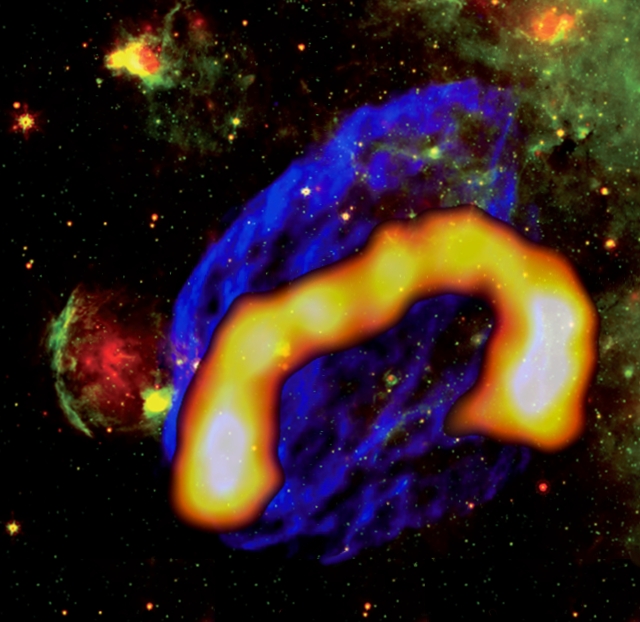
Figure credits: AGILE Team, G. Castelletti, G. Dubner
| | November 9, 2011 | AGILE Cycle-3 Public Data Now Available
The proprietary period for the AGILE Cycle-3 Observation Blocks (OB) from OB 8600 to OB 10400 has currently expired. The data are public and available from the ASDC Multimission Archive (MMIA) webpage for the AGILE Mission.
Since the beginning of Cycle-3 the AGILE satellite is operating in a spinning observing mode, i.e. with the instrument axis sweeping the sky with an angular speed of ~0.8 degree/sec. The allowed pointing directions lie on a great circle orthogonal to the Sun direction, whose orientation changes with time, so that the whole sky is accessible during a six months period.
The new public GRID data are related to the first 19 AGILE observations of Cycle-3, from 2009-10-31 to 2010-10-15. These data have been processed with the latest available software and calibrations optimized for the new observing mode.
The new public AGILE archive is now containing both Cycle-3 spinning, and Cycle-1 and Cycle-2 pointing data.
The query to the archive give access to the public data, producing an interactive table including the ASDC "On-line Analysis" tool.
********** Imaging tool at ASDC **********
The ASDC interactive tool allows web users to preview the AGILE public data fields and to perform a preliminary analysis around a chosen sky position. The tool uses the XIMAGE software package for multi-mission X-ray astronomy, adapted to gamma-ray image display and data analysis.
This new version of the tool allows also to browse several multi-wavelength ASDC catalogs, and to overlay the source positions found in the field. Please send any feedback to the AGILE helpdesk.
WARNING: use only as a preview of the AGILE gamma-ray field. To perform your own scientific analysis, please download and install the public AGILE software, and follow the User Manual included.
Data delivery details and important recommendations for scientific analysis can be found in the AGILE data release note v6.0 (txt, pdf).
| | September 24, 2011 | Gamma-ray activity of the blazar PKS 0402-362 detected by AGILE
New ATel issued: ATel #3658 (M. Cardillo et al.)
| | September 16, 2011 | GRB 110915B: SuperAGILE localization of a long GRB
New GCN issued: GCN #12341 (E. Del Monte et al.)
| | August 12, 2011 | GRB 110812A: SuperAGILE localization of a long GRB
New GCN issued: GCN #12274 (E. Del Monte et al.)
| | August 10, 2011 | AGILE detects intense gamma-ray emission from a new unidentified source AGL J2103+5630
New ATel issued: ATel #3544 (A. Bulgarelli et al.)
| | July 4, 2011 | AGILE detects enhanced gamma-ray emission from BZQ J1512-0905 (PKS1510-089)
New ATel issued: ATel #3470 (I. Donnarumma et al.)
| | June 22, 2011 | AGILE detects enhanced gamma-ray emission from the region of the Narrow-Line Sy1 PMN J0948+0022
New ATel issued: ATel #3448 (F. Lucarelli et al.)
| | May 31, 2011 | AGILE fourth Announcement of Opportunity
The Italian Space Agency (ASI) announces the release of the fourth Announcement of Opportunity (AO4) for the Guest Observer Program of the AGILE mission.
ASI is soliciting proposals from the world-wide astronomy community to apply for the 4th AGILE Announcement of Opportunity for obtaining one-year data rights on gamma-ray sources detected by the AGILE GRID instrument (Energy > 100 MeV) during Cycle-4, between December 1, 2010 and November 30, 2011.
AO4 key dates:
- Release of AO4: May 31, 2011
- Proposals submission period: June 1 - June 30, 2011
- AO4 Observing Period (Cycle-4 data): December 1, 2010 - November 30, 2011
The complete documentation for this AO4 can be found on-line at the AGILE-ASDC web page https://agile.ssdc.asi.it/ao4.html
| | May 29, 2011 | AGILE detection of enhanced gamma-ray emission from BL Lacertae
New ATel issued: ATel #3387 (G. Piano et al.)
| | May 29, 2011 | Enhanced gamma-ray emission detected by AGILE from the Cygnus X-3 region
New ATel issued: ATel #3386 (G. Piano et al.)
| | May 18, 2011 | AGILE detects enhanced gamma-ray emission from a new unidentified source AGL J2302-3251
New ATel issued: ATel #3357 (F. Lucarelli et al.)
| | April 15, 2011 | Renewed increase of gamma-ray activity from the Crab Nebula
A renewed increase of the gamma-ray activity above 100 MeV from the Crab Nebula has been recently reported by Fermi in ATel #3276 (R. Buheler at al.) in the period April 9-11, 2011, and confirmed by the AGILE monitoring in ATel #3282 (M. Tavani et al.).
A ToO Swift/XRT observation was promptly performed but no significant X-ray flux variation was detected, as reported in ATel #3279 (G. Cusumano et al.).
Chandra was observing the Crab on April 12 and 13, 2011 as part of their monitoring program, which began following the previous surprising gamma-ray flare in September 2010.
We recall that a gamma-ray flux increase from the direction of the Crab Nebula was reported for the first time by AGILE, and then confirmed by Fermi in September 2010 (ATel #2855 and ATel #2861).
The new Chandra observations are reported in ATel #3283 (A. Tennant et al.).
| | March 28, 2011 | AGILE detection of Cygnus X-3 above 400 MeV
New ATel issued: ATel #3239 (A. Bulgarelli et al.)
| | March 1, 2011 | AGILE detects enhanced gamma-ray emission from a region including the BL Lac Object S4 1749+70
New ATel issued: ATel #3199 (F. Lucarelli et al.)
| | February 8, 2011 | Gamma-ray flaring emission from Cygnus X-3 detected by AGILE
New ATel issued: ATel #3151 (A. Bulgarelli et al.)
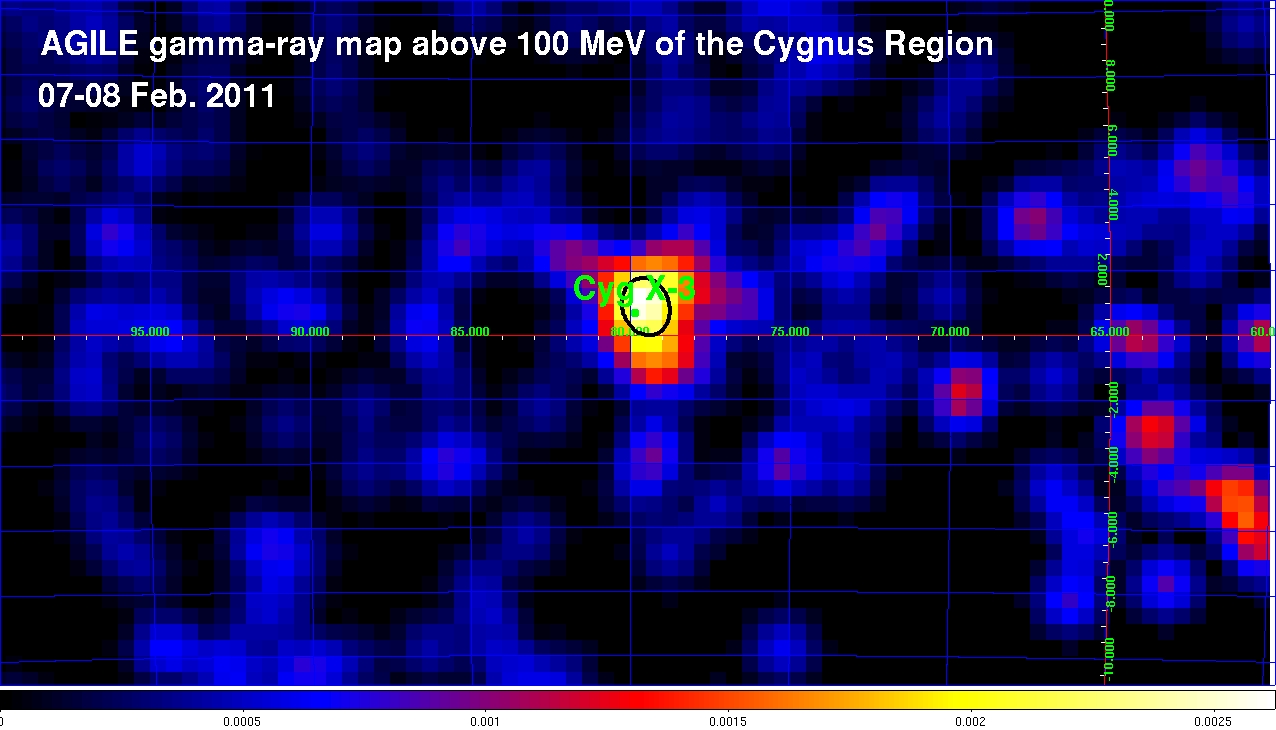
AGILE 1-day intensity map (E> 100 MeV) of the Cygnus region on February 7-8, 2011.
| | February 1, 2011 | AGILE detection of enhanced gamma-ray emission from Cygnus X-3
New ATel issued: ATel #3141 (A. Bulgarelli et al.)
| | January 4, 2011 | Terrestrial Gamma-Ray Flashes as Powerful Particle Accelerators
AGILE latest article on Terrestrial Gamma-Ray Flashes (TGFs) reporting the discovery of gamma-ray radiation up to 100 MeV from Earth thunderclouds was published on January 3, 2011 by Phys. Rev. Letters:
"Terrestrial Gamma-Ray Flashes as Powerful Particle Accelerators", M. Tavani et al. (AGILE Team), Phys. Rev. Lett. 106, 018501 (2011) . Download PDF (free)
See also J. Dwyer Viewpoint published on Physics (Jan. 3, 2011):"Chance of thunder and gamma-ray flashes"
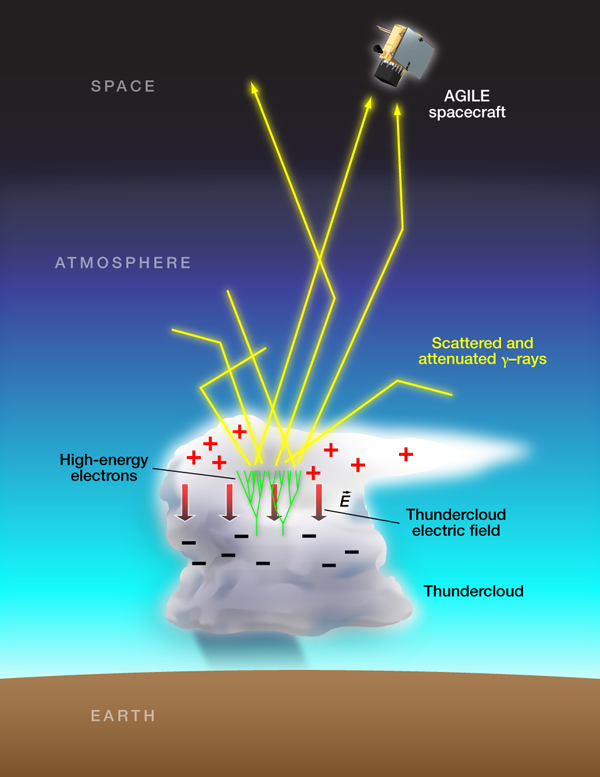
Figure credits: APS Physics/Alan Stonebraker
| | December 21, 2010 | Reprocessed AGILE Cycle-1 and Cycle-2 Public Data Now Available
A new version of the whole AGILE archive for all Cycle-1 and Cycle-2 data, reprocessed with the latest available software (sw=5_19_18_17) is now available, including data of the last two AGILE Cycle-2 Observation Blocks (OB8300 and OB8400) whose proprietary period expired today.
This is the same software version used for the creation of the proprietary Cycle-3 data delivered to successful proponents of the AO3 AGILE Guest Observer Program.
During Cycle-1 and Cycle-2 AGILE was operated by performing long observations, called Observation Blocks (OBs), typically of 2-4 weeks duration. On November 4, 2009, toward the end of Cycle-2, AGILE scientific operations were reconfigured following a malfunction of the rotation wheel occurred in mid October,2009. The satellite is currently operating regularly in a spinning observing mode, surveying a large fraction of the sky each day.
As in previous public deliveries, AGILE public data in pointing observing mode have been cleaned by eliminating time periods corresponding to repointing slews and occasional losses of fine-pointing attitude.
Moreover the present data release also includes non-cleaned data, treated in a similar way to those presently taken in spinning observing mode.
WARNING: to avoid spurious artefacts, this set of non-cleaned data must be carefully analysed using a smaller field of view (fovrad=50).
The new public data are available from the ASDC Multimission Archive webpage for the AGILE Mission. Data delivery details can be found in the AGILE_data_release_note_v5.0 (txt, pdf)
| | November 30, 2010 | AGILE detection of the transient gamma-ray source AGL J1037-5708
New ATel issued: ATel #3059 (A. Bulgarelli et al.)
| | November 22, 2010 | Decreasing gamma-ray emission from the blazar 3C 454.3
New ATel issued: ATel #3049 (E. Striani et al.)
| | November 19, 2010 | AGILE detection of the extraordinary and prolonged gamma-ray activity from 3C 454.3
New ATel issued: ATel #3043 (E. Striani et al.)
| | November 17, 2010 | AGILE detects another extraordinary gamma-ray flare from the blazar 3C 454.3
New ATel issued: ATel #3034 (E. Striani et al.)
| | November 11, 2010 | AGILE Cycle-3 Guest Observer data now available
The AGILE Data Center announces that Cycle-3 Guest Observer data from December 1, 2009 to October 15, 2010 are now available.
All Cycle-3 Guest Observers have been invited via email on November 9, 2010 to login from the AGILE Data Center home page to the Guest Observer Program area with their username and password to retrieve available data for their accepted proposals.
AGILE Cycle-3 data obtained with AGILE observing a large portion of the sky in spinning mode, have been processed with the latest available software and calibrations optimized for the new AGILE observing mode.
| | November 5, 2010 | AGILE detects gamma-ray emission from AGL J2330-5036, in the region of BZQ J2329-4955 (PKS 2326-502)
New ATel issued: ATel #3008 (F. Lucarelli et al.)
| | November 1, 2010 | AGILE/GRID detection of increased gamma-ray emission from 3C 454.3
New ATel issued: ATel #2995 (S. Vercellone et al.)
| | October 26, 2010 | AGILE detection of AGL J0813+2420, a new unidentified gamma-ray source
New ATel issued: ATel #2971 (F. Lucarelli et al.)
| | October 17, 2010 | AGILE detection of prolonged gamma-ray activity from the blazar PKS 1830-211
New ATel issued: ATel #2950 (I. Donnarumma et al.)
| | October 7, 2010 | The Crab "goes wild" in gamma-rays
More suprises from sky observations in gamma-rays.
The ASI satellite AGILE, thanks to its sky monitoring capability and fast ground segment alert system, has discovered an increased gamma-ray flux above 100 MeV from a source positionally consistent with the Crab Nebula.
The unexpected discovery has been promptly reported on September 23, 2010 in ATel #2855 (M. Tavani et al.), and confirmed the next day by the Fermi satellite in ATel #2861 (R. Buehler et al.). Fermi interrupted its all-sky scanning mode and completed a dedicated pointed observation of the Crab Nebula from 2010-09-23 to 2010-09-27 to increase its exposure on the source. Measurements taken starting on 23 September show that the gamma-ray flux is back to normal values, see ATel #2879.
The Crab Pulsar and Nebula are the remnants of the explosion of the supernova SN1054, and the spectra containing the diffuse and pulsed emission has always been considered the standard X-ray candle for X-ray and gamma-ray satellites used also for instrument calibration.
Following the surprising discovery by AGILE, the results of INTEGRAL observations of the Crab nebula, performed for calibration purpose, and the Swift/BAT team routine monitor of the source were reported in ATel #2856 and ATel #2858 respectively. In these hard X-rays observations, however, no statistically significant increase in the Crab flux was observed.
Special ToO observations were then requested and performed by Swift, see ATel #2866, Chandra, see ATel #2882, and Hubble Space Telescope, see ATel #2903. Comparing the current Crab Nebula image with the extensive database available in the HST public archive, an increased emission about 3 arcsec East of the pulsar was noticed. The Chandra exposure, taken a few days before the HST one, reported a brightening from the same region.
Gamma-ray data suggests that the origin of the flare is related to the nebula rather than the pulsar emission, and provide evidence for particle acceleration mechanisms in nebular shock regions more efficient than previously expected from current theoretical models.
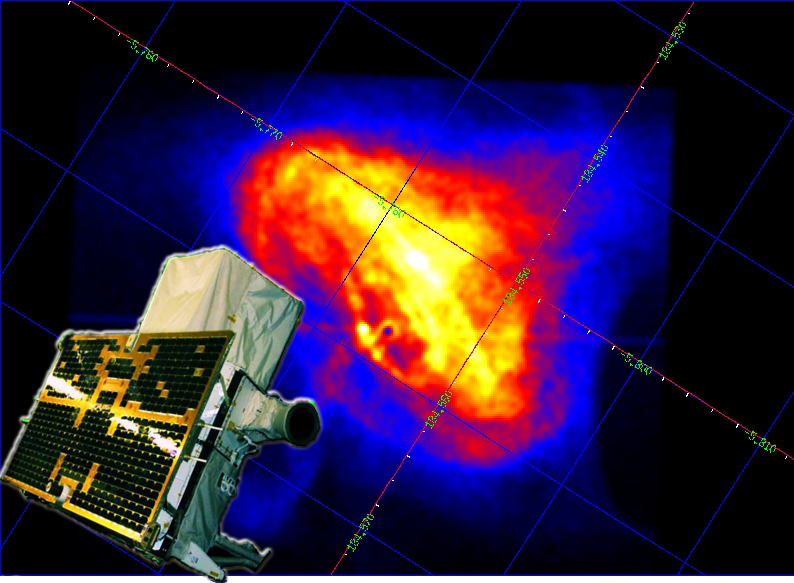
In the image background: Chandra X-ray Observatory data from the ToO observation of Crab on September 28, 2010, following the gamma-ray flare detected by AGILE.
| | October 6, 2010 | AGILE Cycle-2 Public Data Now Available
The proprietary period for the AGILE Cycle-2 Observation Blocks (OB) from OB 6500 to OB 8200 has currently expired, and the data are public and available from the ASDC Multimission Archive webpage https://www.ssdc.asi.it/mmia/ for the AGILE Mission
The set of GRID data which become public today corresponds to the first 22 AGILE observations of Cycle-2, from 2008-11-30 to 2009-09-30, following the second year AGILE Baseline Pointing Plan and including 2 Target of Opportunities (ToO) and 1 Partial Repointing.
Data delivery details can be found in the AGILE_data_release_note_v4.0 (txt, pdf)
| | September 28, 2010 | AGILE upper limits above 100 MeV regarding the recent transient MAXI J1659-152
New ATel issued: ATel #2880 (F. Lucarelli et al.)
| | September 22, 2010 | AGILE detection of enhanced gamma-ray emission from the Crab Nebula region
New ATel issued: ATel #2855 (M. Tavani et al.)
| | August 5, 2010 | AGILE detection of transient gamma-ray emission from the PSR B1259-63 region
New ATel issued: ATel #2772 (M. Tavani et al.)
| | July 27, 2010 | AGILE detection of the new unidentified gamma-ray source AGL J2241+4454
New ATel issued: ATel #2761 (F. Lucarelli et al.)
| | July 26, 2010 | GRB 100724B: AGILE/GRID analysis
New GCN issued: GCN #10996 (A. Giuliani et al.)
The preliminary GRB lightcurves of AGILE MCAL and GRID instruments are shown in the figure below.
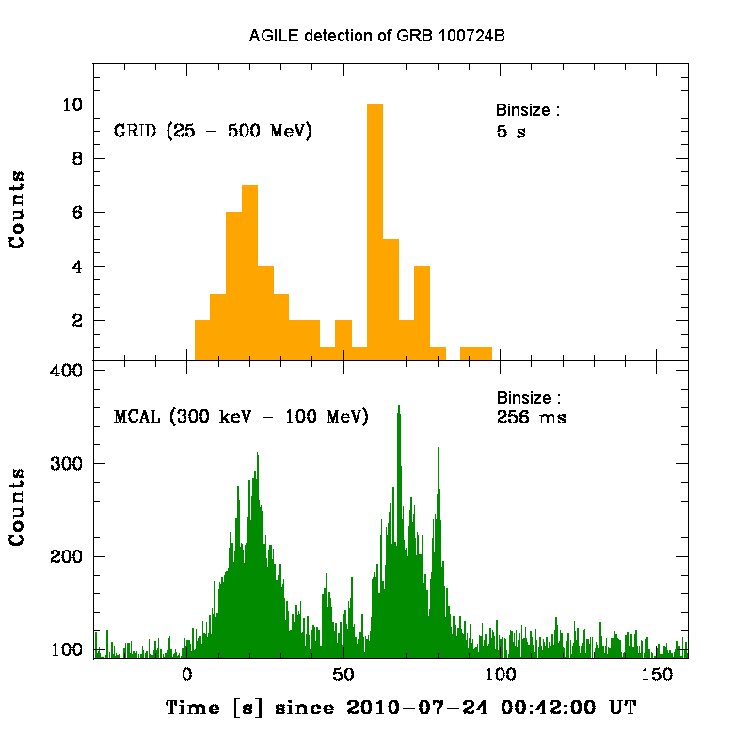
| | July 26, 2010 | GRB 100724B: gamma-ray detection by AGILE
New GCN issued: GCN #10994 (M. Marisaldi et al.)
| | July 6, 2010 | AGILE AO-3 list of approved targets
The official list of all AGILE AO-3 approved targets is now available here.
In all cases of gamma-ray sources partially or fully fitting the proposed error boxes specified by different groups, the AGILE Mission Board encourages collaboration among these groups .
| | July 2, 2010 | AGILE gamma-ray detection of Cygnus X-1
New ATel issued: ATel #2715 (S. Sabatini et al.)
| | July 1, 2010 | Funding of data analysis projects (ADAE): deadline postponed to July 16, 2010
The deadline for ADAE proposal submission (ASI-INAF agreement I/009/10/0) has been postponed. The new deadline is July 16, 2010
| | June 28, 2010 | Swift follow-up of the blazar 4C+21.35 (PKS 1222+21) after a bright gamma-ray flare
New ATel issued: ATel #2698 (F. Verrecchia et al.)
| | June 21, 2010 | AGILE and Fermi detection of intense gamma-ray flare from the blazar 4C+21.35 (PKS 1222+21)
New AGILE ATel issued: ATel #2686 (E. Striani et al.)
New Fermi ATel issued: ATel #2687 (G. Iafrate et al.)
On June 19, 2010, AGILE and Fermi reported the detection of intense gamma-ray emission above 100 MeV from the Flat Spectrum Radio Quasar 4C+21.35, also known as PKS 1222+21.
Flaring activity from this source has been also detected in the past few days by the MAGIC (ATel #2684) at energies above 100 GeV.
| | May 28, 2010 | AGILE detection of gamma-ray emission from Cygnus X-3
New ATel issued: ATel #2645 (A. Bulgarelli et al.).
| | May 28, 2010 | GRB 100528A: SuperAGILE Localization of a Long GRB
New GCN issued: GCN #10810 (E. Del Monte et al.)
| | May 26, 2010 | AGILE detection of gamma-ray emission from 4C+21.35 (PKS 1222+21)
New ATel issued: ATel #2641 (A. Bulgarelli et al.)
| | May 10, 2010 | AGILE detection of gamma-ray emission from the Cygnus X-3 region
New ATel issued: ATel #2609 (A. Bulgarelli et al.)
| | April 14, 2010 | AGILE detection of the new unidentified gamma-ray source AGL J0906-1241
New ATel issued: ATel #2552 (C. Pittori et al.)
| | April 14, 2010 | AGILE detects enhanced gamma-ray emission from the blazar PKS 2142-758
New ATel issued: ATel #2551 (F. Verrecchia et al.)
From 2010-04-10 11:30 UT to 2010-04-12 21:00 UT, AGILE has been detecting an increasing gamma-ray flux above 100 MeV from a source positionally consistent with the blazar PKS 2142-758.
The source does not appear in the latest versions of gamma-ray catalogs but a recent gamma-ray flaring episode from this blazar was reported by the Fermi LAT Collaboration in ATel #2539.
| | April 9, 2010 | 8th AGILE Mini-Workshop - The Third Birthday
We are pleased to announce the AGILE 8th Workshop to be held in Bologna (Italy) INAF-IASF, Area Ricerca, on April 28, 2010.
The Workshop is aimed at providing an overview of the most relevant astrophysics results with a special afternoon session on Terrestrial Gamma-Ray Flashes (TGFs).
Information about the Workshop, the registration form, the preliminary wokshop program, the logistic information can be found at https://www.ssdc.asi.it/8thagilemeeting/index.php
For organizational purposes please notify your participation by registering at the workshop web site.
| | April 7, 2010 | GRB 100331B: SuperAGILE Localization of a Long GRB
SuperAGILE detected a long gamma ray burst on March 31, 2010, at 21:08:38 UT.
The burst position was reconstructed as:
RA(J2000) = 20h 11m 56.95s
Dec(J2000) = -11d 04' 02.04"
with an uncertainty of 6' radius to account for possible systematics error due to the AGILE satellite spinning mode.
A description of the burst can be found in GCN #10560 (E. Del Monte et al.)
| | March 30, 2010 | AGILE AO3 now open
The Italian Space Agency (ASI) announces the release of the third Announcement of Opportunity (AO3) for the Guest Observer Program of the AGILE mission.
AO3 key dates:
- Release of AO3: March 30, 2010
- Due date for proposals: April 30, 2010
- AO3 Observing Period (Cycle-3): December 1, 2009 - November 30, 2010
The complete documentation for this AO3 can be found on-line at the AGILE-ASDC web pages https://agile.ssdc.asi.it/ao3.html.
| | March 25, 2010 | AGILE detection of a gamma ray flare from the Cygnus X-1 region
New ATel issued: ATel #2512 (A. Bulgarelli et al.).
| | March 16, 2010 | AGILE detects enhanced gamma-ray emission from the blazar PKS 0402-362
New ATel issued: ATel #2484 (E. Striani et al.) .
| | March 4, 2010 | SuperAGILE detection of an X-ray burst from 4U 1608-522
New ATel issued: ATel #2461 (E. Del Monte et al.).
On March 3, 2010 at 06:33:25 UT SuperAGILE detected an X-ray burst from a sky position consistent with the neutron star transient and atoll source 4U 1608-522. The SuperAGILE detection revealed a reactivation of the source, as confirmed by the MAXI/GSC detection of an X-ray brightening of the persistent emission (ATel #2462, M. Morii et al.)
The SuperAGILE light curve of the event is shown in the figure.
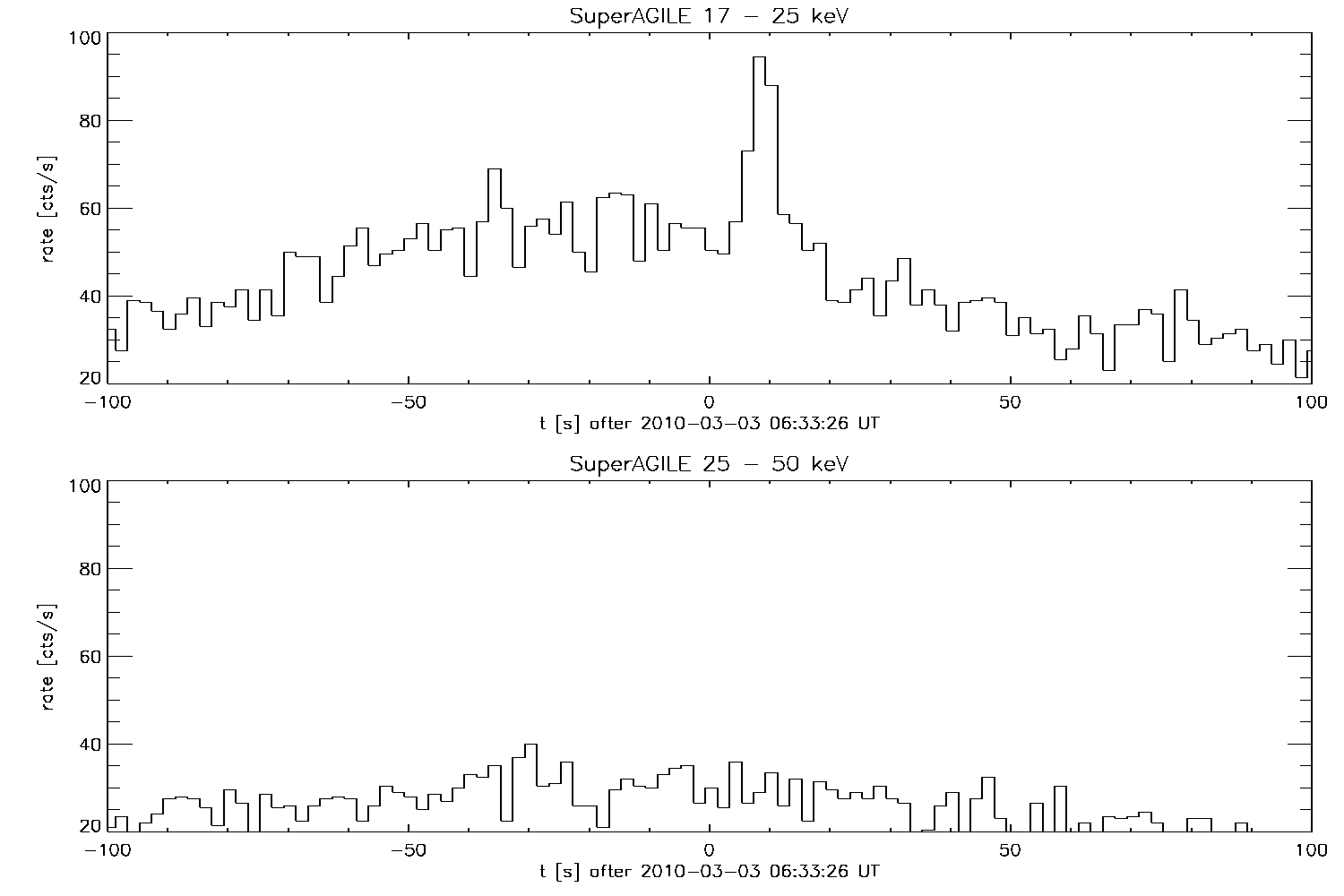
| | February 24, 2010 | AGILE detects enhanced gamma-ray emission from the blazar PKS 0537-441
New ATel issued: ATel #2454 (F. Lucarelli et al.)
| | February 15, 2010 | The AGILE satellite detects "super-energetic TGFs" that could affect air travel
"Terrestrial Gamma-Ray Flashes" (TGF) are phenomena of terrestrial (atmospheric) origin only lasting a few milliseconds that are likely associated to very intense tropical thunderstorms. The AGILE satellites detected several of these events since its first months of operations.
The AGILE equatorial orbit, together with its advanced payload capabilities, allowed the discovery of TGFs with gamma-ray energy reaching up to 50 MeV.
Such highly energetic radiation must be produced in atmospheric conditions requiring potential differences of 100 Mega Volts or more, hundreds of times larger than that required to produce the usual terrestrial lightning.
As announced in a joint press release that can be found on the ASI and INAF websites, the AGILE Team and ASI are collaborating with ENAC (Ente Nazionale per l'Aviazione Civile) to understand the possible hazards to air traffic that these very energetic atmospheric events might cause.
THE AGILE paper "Detection of Terrestrial Gamma-Ray Flashes up to 40 MeV by the AGILE satellite" by M. Marisaldi et al. (2009), previously announced on this website on October 29th 2009, is now being published in the Journal of Geophysical research and it is accessible on-line at:
https://www.ssdc.asi.it/news/Marisaldi2009_AGILE-TGF.pdf
| | February 3, 2010 | AGILE confirmation of the new gamma-ray flaring source J0109+6134 near the Galactic plane
New ATel issued: ATel #2416 (S. Sabatini et al.)
An AGILE gamma-ray intensity map of the field E>100 MeV in Galactic coordinates (AGILE error box in green color and FERMI detection in grey color) can be found here.
| | January 25, 2010 | AGILE detection of AGL J2206+6203, a new unidentified gamma-ray source
New ATel issued: ATel #2403 (A. Bulgarelli et al.)
| | January 14, 2010 | AGILE detection of enhanced gamma-ray emission from the blazar PKS 1510-089
New ATel issued: ATel #2385 (E. Striani et al.)
| | January 8, 2010 | AGILE detection of a gamma-ray flare from the blazar 3C 273
New ATel issued: ATel #2376 (L. Pacciani et al.)
| | December 31, 2009 | AGILE Detection of Gamma-Ray Emission from the Vela Pulsar Wind Nebula
The AGILE detection of Vela X, described in the Science paper "Detection of Gamma-Ray Emission from the Vela Pulsar Wind Nebula with AGILE", (A. Pellizzoni et al.), is the first experimental confirmation of gamma-ray emission (E> 100 MeV) from a pulsar wind nebula.
The AGILE detection establishes Pulsar Wind Nebulae as a new class of GeV gamma-ray sources.
| | December 28, 2009 | AGILE detection of AGL J1023-3738 , a new high-Galactic latitude unidentified source
New ATel issued: ATel #2361 (E. Striani et al.)
| | December 22, 2009 | All AGILE Cycle-1 Data Now Public
The proprietary period for the last 9 Cycle-1 Observation Blocks (from OB 5900 to OB 6400) has expired, thus the entire Cycle-1 dataset from December 1, 2007 to Novembre 30, 2008 is now public and available from the ASDC Multimission Archive webpage https://www.ssdc.asi.it/mmia/ for the AGILE Mission.
This new public delivery reflects the current best understanding and testing of calibrations, background rejection, and processing results.
| | December 15, 2009 | AGILE detection of a gamma-ray flare from the blazar PKS 1222+216
New ATel issued: ATel #2348 (F. Verrecchia et al.)
| | December 3, 2009 | AGILE detects an extraordinary gamma-ray activity from the FSRQ 3C 454.3
New ATel issued: ATel #2326 (E. Striani et al.).
The AGILE Gamma-Ray Imaging Detector (GRID) has been detecting an extraordinary intense gamma-ray emission above 100 MeV from the flat spectrum radio quasar 3C 454.3. The AGILE quick-look analysis yields a source flux of about (1800 +/- 400)e-8 ph/cm2/sec (E > 100 MeV). This flux value greatly exceeds the value reported by AGILE yesterday in ATel #2322 (E. Striani et al.), showing a rapid increase (about 80%) of the gamma-ray flux of 3C 454.3 in the last 24 hours. See ATel #2326 for further details.
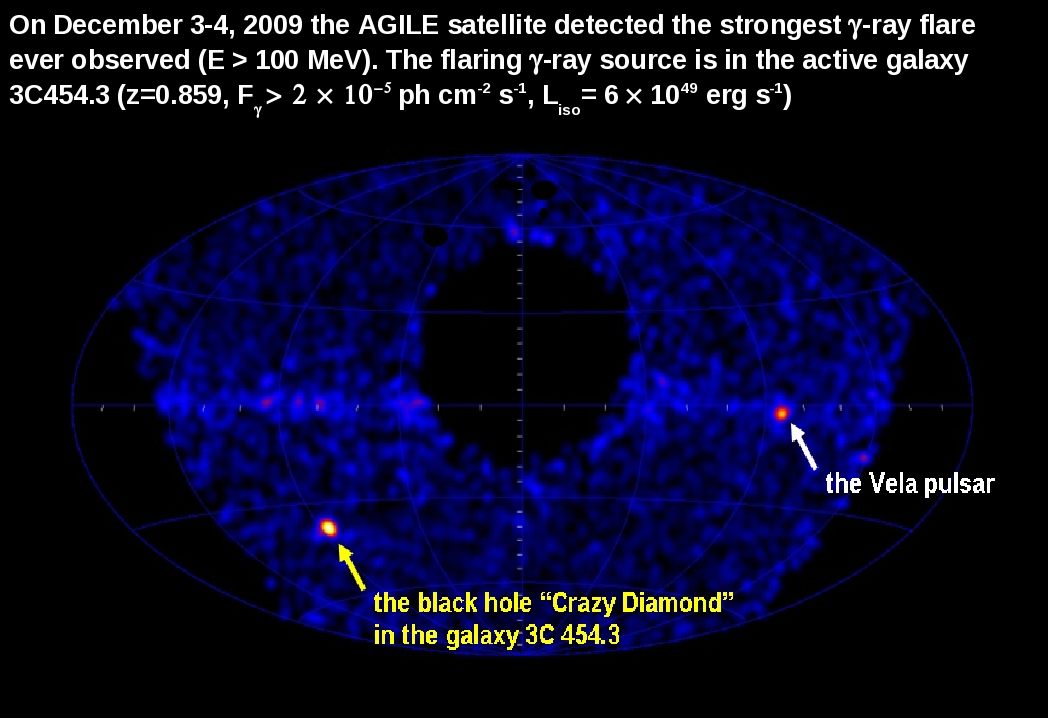
| | December 2, 2009 | AGILE detects intense and prolonged gamma-ray activity from the FSRQ 3C 454.3
New ATel issued: ATel #2322 (E. Striani et al.)
| | November 23, 2009 | AGILE confirms high gamma-ray state of GB6 B1310+4844
New ATel issued: ATel #2310 (A. Bulgarelli et al.)
| | November 19, 2009 | AGILE first detection of gamma-rays above 100 MeV from the microquasar Cygnus X-3: to appear in Nature
The paper "Discovery of extreme particle acceleration in the microquasar Cygnus X-3", by M. Tavani et al., 2009, to appear in Nature (see also arXiv:0910.5344), reports on the AGILE detection of gamma-ray flaring emission from the microquasar Cygnus X-3, which tends to occur before the onset of powerful relativistic radio jets.
| | November 12, 2009 | AGILE science operations resumed on November 4th, 2009
On November 4, 2009 at 12:25:54 the AGILE scientific operations restarted. The instrument is operating nominally, and all detectors are on and acquiring data. The satellite is currently in a safe spinning mode, with the fixed solar panels pointing towards the Sun and the GRID instrument FOV covering a good fraction of the whole sky.
In the figure below we show a preliminary 100-orbit gamma-ray intensity map above 100 MeV in the spinning configuration.
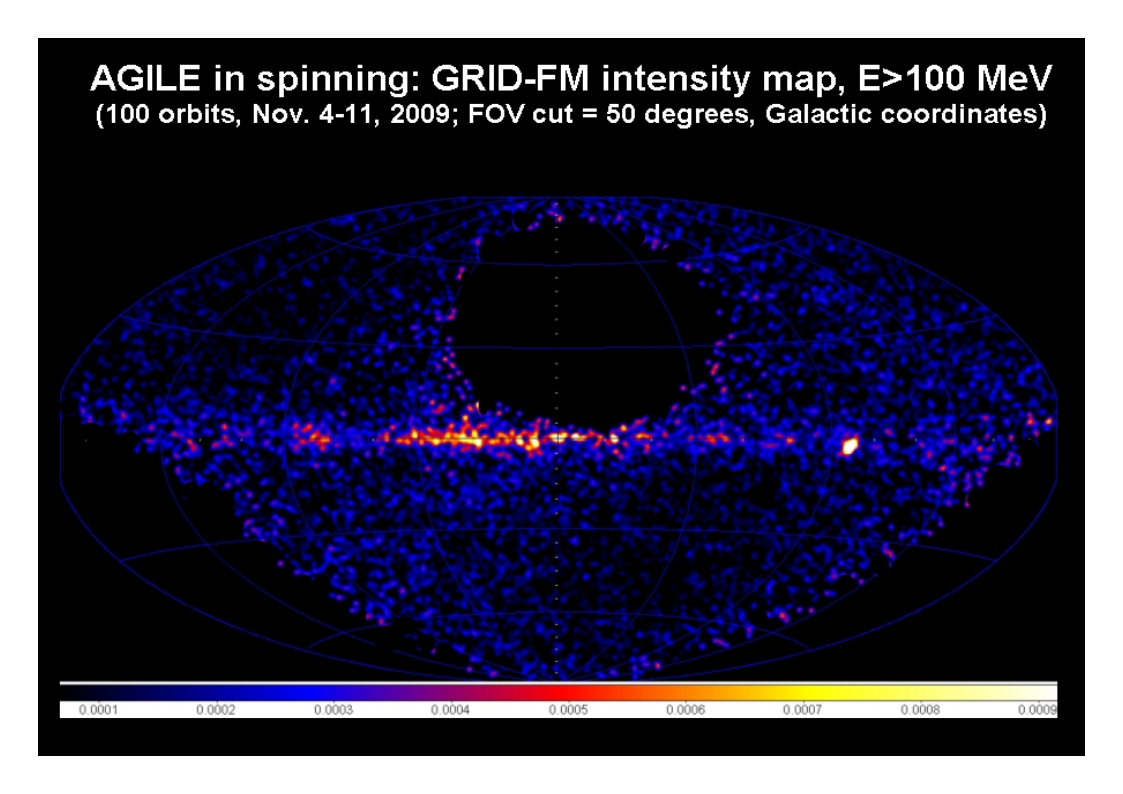
| | October 29, 2009 | AGILE paper on Terrestrial Gamma-Ray Flashes now available
The AGILE paper: "Detection of Terrestrial Gamma-Ray Flashes up to 40 MeV by the AGILE satellite", M. Marisaldi et al. 2009, is now accessible on-line here. The paper was accepted for publication in the Journal of Geophysical Research. Copyright 2009 American Geophysical Union. Further reproduction or electronic distribution is not permitted.
| | October 23, 2009 | AGILE science operations interrupted
On Sunday, October 18th 2009, one of the subsystems on board the AGILE S/C suffered a malfunction that caused the satellite to leave its nominal pointing mode and switch to the "spinning" control mode. The "spinning" control mode guarantees the safety of the Spacecraft and of the Payload.
Analysis is in progress in order to assess the status of the satellite and the possibility to restart operations as soon as possible.
| | October 15, 2009 | AGILE detection of the gamma-ray blazar PKS 1830-211
New ATel issued: ATel #2242 (E. Striani et al.)
| | October 14, 2009 | New AGILE public software package and test dataset available
We are pleased to inform you that a new software package for AGILE-GRID data analysis is now available from the AGILE Data Center webpage https://agile.ssdc.asi.it/public/AGILE_SW_4.0_SourceCode/
The software is available both for AGILE Guest Observers and for general public users. The new AGILE software package BUILD_GRID_4.0.tgz is delivered together with a test dataset, test_dataset_4.0.tgz, and it is intended for the scientific software environment setup and testing.
Warning: Since the newly delivered spacecraft auxiliary (LOG) files have a very accurate time resolution (100 msec), several GB of available disk space are needed for AGILE data analysis.
The GRID analysis software is continuously evolving and regularly updated by the AGILE instrument Team and delivered to the AGILE Data Center (ADC) located in Frascati at the ASI Science Data Center for further testing, standardisation and integration into the ADC data analysis system.
This public delivery reflects the current best understanding and testing of calibrations, background rejection, and processing results.
| | October 14, 2009 | Reprocessed AGILE Public Data Now Avalaible
The AGILE-GRID public data release (v2.0) is now available from the ASDC Multi Mission Interactive Archive webpage: https://www.ssdc.asi.it/mmia/ which can be also reached from the AGILE home page: https://agile.ssdc.asi.it by clicking: Public --> Data Release
The current set of public GRID data corresponds to the first 20 AGILE observations of Cycle-1, from December 1, 2007 to June 30, 2008.
Plese note that all Cycle-1 OB data already included in previous deliveries have been reprocessed with the latest available software.
MAIN IMPROVEMENTS:
- Event filters:
in previous data delivery a conservative event filter (F4) was used, optimized to select gamma-ray events within the central Field of View zone (< 40 deg radius) at the expenses of the effective area. The new standard AGILE event filter (FM) is optimized up to 60 deg off-axis.
- Spacecraft auxiliary (LOG) files:
the newly delivered auxiliary LOG files have a very accurate time resolution (100 msec)
This new public delivery reflects the current best understanding and testing of calibrations, background rejection, and processing results.
The previous public data release (v1.0) is still available from the MMIA AGILE webpage by selecting: Old Processing Archive.
Data delivery details can be found in the AGILE_data_release_note_v2.0 (txt, pdf)
| | October 14, 2009 | GRB 091010: SuperAGILE Localization, AGILE-MCAL measurement and GRID upper limit
SuperAGILE detected a long gamma ray burst on 10 October 2009,at 02:43:09 UT.
The burst position was reconstructed as:
RA(J2000) = 19h 54m 40.51s (298.669 deg)
Dec(J2000) = -22d 32' 17.36" (-22.538 deg)
with an uncertainty of 3' radius.
A description of the burst can be found in GCN #10004 (I. Donnarumma et al.) and GCN #10005.
AGILE-MCAL measurement and GRID upper limit for GRB 091010 can be found in GCN #10022 (M. Marisaldi et al.)
In the figure below we report the superposition of the lightcurves of GRB 091010 as detected by SuperAGILE (on top, 17 - 60 keV) and MCAL (at bottom, 330 keV - 2 MeV). No significant signal is detected in MCAL above 2 MeV .
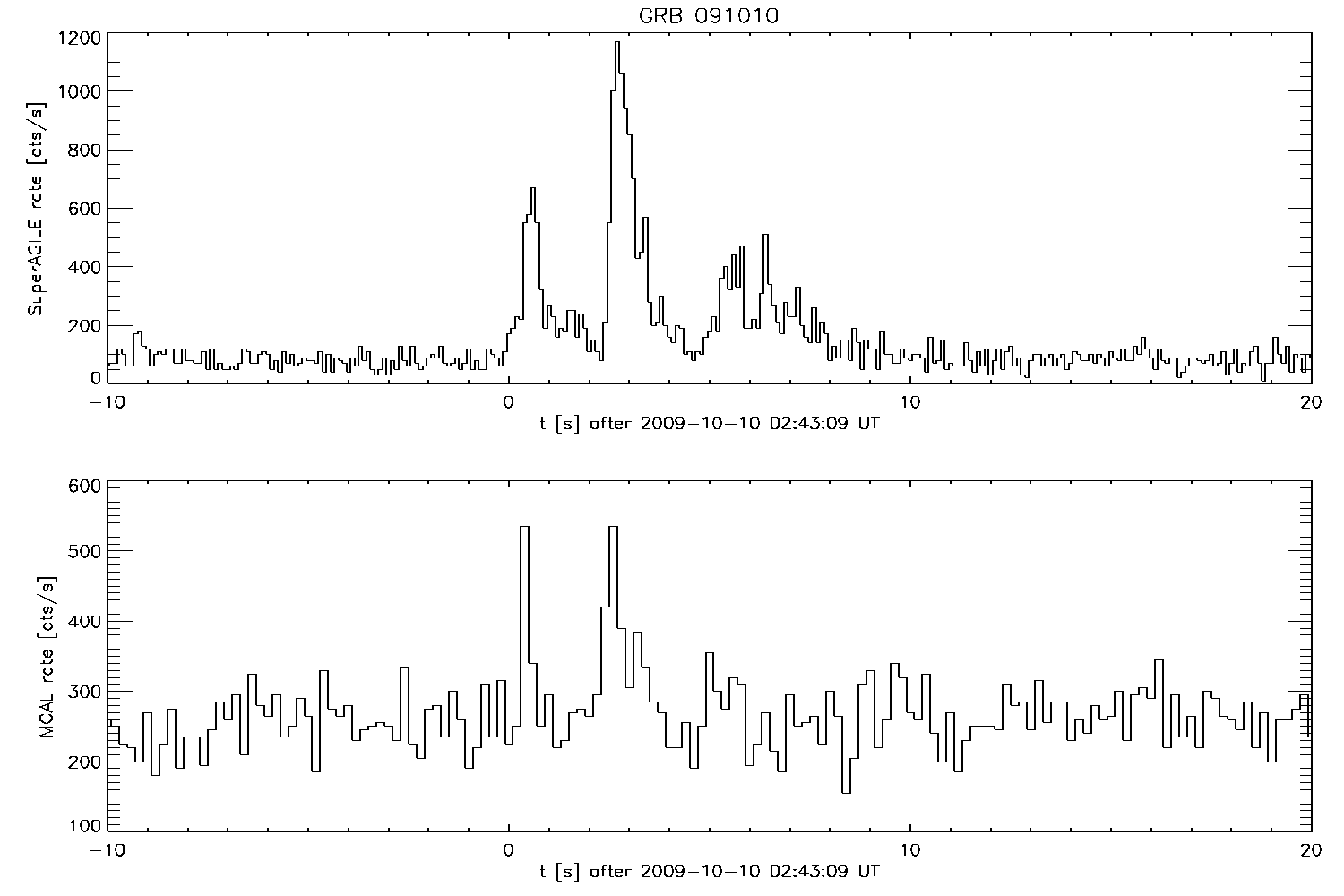
| | October 14, 2009 | SuperAGILE detection of a type I X-ray burst from a position consistent with HETE J1900.1-2455
On 9 October 2009 02:57:43 UT SuperAGILE detected a type I X-ray burst from a sky position consistent with the accreting millisecond pulsar HETE J1900.1-2455.
SuperAGILE detection details can be found in ATEL #2238 (Y. Evangelista et al.)
| | August 10, 2009 | AGILE AO-2 list of approved targets
The official list of all AGILE AO-2 approved targets is now available here
| | August 7, 2009 | The AGILE 7th Workshop: informations and updates
As previously announced on July 23, the scientific AGILE Workshop: "The Bright Gamma-Ray Sky", will be held in Frascati (Italy), ASDC-ESRIN on 29 September - 1 October, 2009.
Preliminary program and other useful information are now available at the 7th AGILE Workshop website: https://www.ssdc.asi.it/bgrsmeeting/
| | July 23, 2009 | The AGILE 7th Workshop
We are pleased to announce the AGILE 7th Workshop: "The Bright Gamma-Ray Sky", to be held in Frascati (Italy), ASDC-ESRIN on 29 September - 1 October, 2009.
The Workshop is aimed at providing an overview of the most relevant recent discoveries in gamma-ray astrophysics, with particular emphasis on the multifrequency (radio, optical, X-ray, gamma-ray and TeV) observations of cosmic sources. We will focus also on how to strengthen the multifrequency response to alerts originating from the gamma-ray experiments.
Detailed information will follow shortly on this web site.
| | July 17, 2009 | A second set of AGILE-GRID data now publicly available: period May 10, 2008 - June 30, 2008
The second set AGILE-GRID data published corresponds to 3 AGILE observation blocks (OB) of Cycle-1 including one Target of Opportunity (ToO) which cover the period May 10, 2008 - June 30, 2008.
New public data are available (together with the first set released on June 10, 2009) from the ASDC Multi Mission Interactive Archive webpage: https://www.ssdc.asi.it/mmia/ which can be also reached from the AGILE home page: https://agile.ssdc.asi.it by clicking: Public --> Data Release
| | June 10, 2009 | AGILE Public Data Now Avalaible
The AGILE-GRID public data release (v1.0) is now available from the ASDC Multi Mission Interactive Archive webpage: https://www.ssdc.asi.it/mmia/ which can be also reached from the AGILE home page: https://agile.ssdc.asi.it by clicking: Public --> Data Release
This first set of GRID data gone public corresponds to the first 17 AGILE observations of Cycle-1 following the first year AGILE Baseline Pointing Plan (ABPP1) and including 2 Target of Opportunities (ToO) and 1 Partial Repointing.
Data delivery details can be found in the AGILE_data_release_note_v1.0 (txt, pdf)
| | May 22, 2009 | Now available: AGILE-GRID public software package and test dataset
We are pleased to inform you that a new software package for AGILE-GRID data analysis is now available from the AGILE Data Center webpage https://agile.ssdc.asi.it/public
This release is available not only for AGILE Guest Observers, but also for general public users. The AGILE software package is delivered together with a test dataset and it is intended for the scientific software environment setup and testing in view of future public data releases.
The GRID analysis software is continuously evolving and regularly updated by the AGILE instrument Team and delivered to the AGILE Data Center (ADC) located in Frascati at the ASI Science Data Center for further testing, standardisation and integration into the ADC data analysis system.
This public delivery reflects the current best understanding and testing of calibrations, background rejection, and processing results.
| | May 11, 2009 | AGILE detection of GRB 090510
AGILE detected the remarkable short GRB 090510 and a new GCN Circular was issued on May 10, 2009 : GCN #9343 (F. Longo et al.).This is the first short GRB with emission above 100 MeV detected by AGILE.
| | May 8, 2009 | AGILE Software and Data Distribution News
We are pleased to inform you that a new software package for AGILE-GRID data analysis will be available from the AGILE Data Center webpage https://agile.ssdc.asi.it starting from May 21, 2009. This release is designed not only for AGILE Guest Observers, but also for general public users. The AGILE software package will be delivered together with a test dataset and it is intended for the scientific software environment setup and testing in view of future public data releases.
Following the data distribution policy described in the AGILE Science Management Plan, a general public AGILE-GRID data release is foreseen for the beginning of June, at the end of the one year proprietary period starting from June 5, 2008, when Cycle-1 observers received data (collected during the period December 1, 2007 - May 10, 2008) in a format suitable for analysis and subsequent publication.
The GRID analysis software is continuously developed and updated by the AGILE instrument Team and delivered to the AGILE Data Center (ADC) located in Frascati at the ASI Science Data Center for further testing, standardisation and integration into the ADC data analysis system.
Following a recent update by the AGILE Team of the GRID software analysis tools, the public delivery of the software (previouly planned for today) will reflect the current best understanding and testing of calibrations, background rejection, and processing results.
| | April 21, 2009 | AGILE Detection of Gamma-ray Emission from the Eta-Carinae Region
See AGILE top results: "AGILE Detection of Gamma-ray Emission from the Eta-Carinae Region"
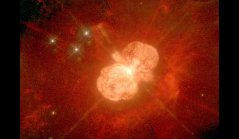
| | April 19, 2009 | The candidate gamma-ray transient AGL J1734-3310 in the Galactic plane
On April 17, 2009 a new AGILE ATel was issued: ATel #2017 (A. Bulgarelliet al.), reporting the AGILE detection a possible candidate gamma-ray transient.
The candidate gamma-ray transient AGL J1734-3310 appears to be consistent in position with 1AGL J1736-3235 and also with the INTEGRAL unidentified source IGR J17354-3255.
The ATel#2017 was subsequently referred to by ATel #2019 (S. Vercellone et al.) and ATel#2022 (J.A. Tomsick) concerning Swift and Chandra follow-ups, respectively.
| | April 8, 2009 | 6th AGILE Workshop: information and updates
As announced on April 1, a Scientific Mini-Workshop: "AGILE: 2 years after" will be held in Milano on 22-23 April, 2009 in coincidence with the second anniversary of the launch of the AGILE Mission.
Preliminary program and other useful information are now available at the 6th AGILE Workshop web site: https://agile.ssdc.asi.it/workshop2009.html
| | April 2, 2009 | AGILE Gamma-ray detection of GRB 090401B
The gamma ray burst 090401B (GCN #9066 and #9067, Schady et al. ) occurred in the field of view of AGILE, approximately 41 deg off-axis.
A description of the AGILE detection of the burst can be found in GCN #9069 (E. Moretti et al.).
A refined analysis of the AGILE-GRID (Gamma-Ray Imaging Detector) data of GRB 090401B confirms the gamma-ray detection of the GRB at energies above 30 MeV with a statistical significance larger than 4 for a 10-second integration after trigger, as reported in GCN #9075 (A. Giuliani et a.)
| | April 1, 2009 | AGILE satellite: 10.000th pass over the ASI Malindi Ground Station
On March 31, 2009 at 21:53:38 UTC the AGILE satellite successfully completed its 10.000th pass over the ASI Malindi Ground Station.
All satellite subsystems and scientific detectors are working nominally after almost 2 years after launch. This very positive result is obtained thanks to the efficient collaboration of all involved Agilists, ASI, INAF, INFN and CIFS scientists, industry colleagues and technical operators.
| | April 1, 2009 | AGILE: 2 years after (6th AGILE Workshop)
We are pleased to announce a Scientific Mini-Workshop in coincidence with the second anniversary of the launch of AGILE: "AGILE: 2 years after" to be held in Milano, 22-23 April, 2009 Congress Hall, INAF-IASF via Bassini 15, Milano, Italy.
The Mini-Workshop aims to provide an overview of the Mission highlights and hot topics related to the current high-energy missions from the point of view of the AGILE scientific users and collaborators.
Detailed information will follow shortly on this web site.
| | March 24, 2009 | GRB 090324: SuperAGILE Localization of a Long GRB
SuperAGILE detected a gamma ray burst on 24 March 2009, at 02:48:09 UT.
The burst position was reconstructed as:
RA(J2000) = 17h 08m 42.73s (257.178 deg)
Dec(J2000) = -48d 08' 47.59" (-48.147 deg)
with an uncertainty of 3' radius.
A description of the burst can be found in GCN #9029 (F. Lazzarotto et al.)
| | March 23, 2009 | A bright burst from AXP 1E 1547.0-5408/SGR J1550-5418
A bright burst from AXP 1E 1547.0-5408 / SGR J1550-5418 was triggered and imaged by SuperAGILE on 22 March 2009, at 22:39:16 UT.
A new GCN Circular was issued: GCN #9014 (E. Del Monte et al.)
| | March 19, 2009 | AGILE detection of a gamma-ray re-brightening of the blazar PKS 1510-089
New ATel issued ATel #1976 (S. Vercellone et al.)
| | March 13, 2009 | AGILE detection of a bright and persistent gamma-ray flare from the blazar PKS 1510-089
During the current AGILE pointing centered near the Galactic Center, the AGILE satellite has detected significant gamma-ray emission above 100 MeV from the source 1AGL J1511-0809 of the First AGILE Catalogue identified with blazar PKS 1510-08, see ATel #1968 (Pucella et al.) and ATel #1957 (F. D'Ammando et al.). The analysis of the most recent AGILE-GRID data integrated from 2009-03-12 06:57 UT to 2009-03-13 05:03 UT for photon energies above 100 MeV, gives a detection significance of above 9 sigma for a source flux in excess of 400 x 10^-8 ph cm^-2 s^-1.
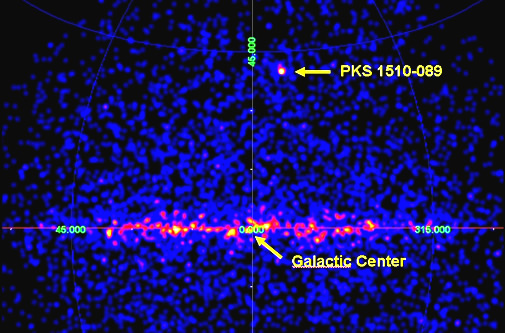
The figure shown above shows the gamma-ray count map of the relevant field of the current Galactic Center pointing.
| | March 10, 2009 | AGILE detection of the flaring gamma-ray blazar PKS 1510-089
New ATel issued ATel #1957 (F. D'Ammando et al.)
| | January 28, 2009 | SuperAGILE detects a flare from the binary source 3A 0114+650
New ATel issued ATel #1917 (L. Pacciani et al.)
| | January 12, 2009 | AGILE: ToO toward the Carina Field
The AGILE satellite will be pointing at the Galactic plane near the Carina Region: Ra(J2000)=10h 46m 40.5s DEC(J2000)=-59° 51' 39.5" (galactic coordinates: l=287.859 b=-0.693) for a 1-week period starting on Jan. 12, 18:00 UT, until Jan. 19, 18:00 UT.
| | December 22, 2008 | SuperAGILE source catalog and light curves now available
We are pleased to announce that the SuperAGILE source catalog and light curves are now publicy available at the ASDC Webpage: https://agile.ssdc.asi.it/sagilecat_sources.html .
The page will be automatically updated twice a day.
| | December 10, 2008 | AGILE First Catalog now available and AO2 deadline postponed
We are pleased to announce that the "First Catalogue of AGILE-GRID High Confidence Gamma-Ray Sources" is now available from at the ASDC Webpage: https://www.ssdc.asi.it/agilebrightcat.
Due to the unforeseen unavailability of part the AGILE scientific staff at ASDC, the preparation of the First AGILE Catalogue took longer than expected.
In order to allow AGILE AO2 guest observers to benefit of this catalog in the preparation of their proposals the previous AO2 deadline of 12 December 2008 has been postponed to 7 January 2009.
| | November 17, 2008 | AGILE detection of a possible rebrightening of the gamma-ray source AGL J2021+4032 in the Cygnus Region
New ATel issued ATel #1848M. Tavani
| | November 12, 2008 | AGILE AO2 issued
The second Announcement of Opportunity for the participation in the AGILE Guest Observers Program has been issued today.
The complete documentation for this AO2 can be found here
| | November 4, 2008 | AGILE detection of the gamma-ray source AGL J2030+4043
New ATel issued ATel #1827 (M. Tavani et al.)
| | November 3, 2008 | Key dates for the 2nd AGILE Announcement of Opportunity
The AGILE Mission Board has set the following key dates for the 2nd AGILE Announcement of Opportunity (AO2) for obtaining data rights on gamma-ray sources observed during Cycle-2:
- Release of AO2: November 12, 2008
- Due date for proposals: December 12, 2008
- AO2 Observing Period (Cycle-2): December 1, 2008 - November 30, 2009
The complete AO2 documentation will be available on-line on November 12, 2008 from the official AGILE Web site: https://agile.ssdc.asi.it
| | October 15, 2008 | SuperAGILE detection of Vela X-1 in highly active hard X-ray state
A description of the current X-ray flaring activity of the source the Vela X-1 can be found in ATel #1782 (P.Soffitta et al.).
The SuperAGILE orbital light curve of the source is shown in the figure.
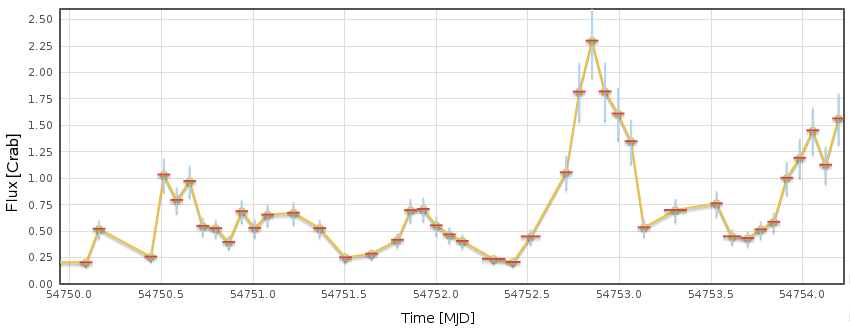
| | October 13, 2008 | Two important findings for the AGILE Satellite
COMUNICATO CONGIUNTO ASI-INAF-INFN (in italian)
| | October 10, 2008 | SuperAGILE detects an X-ray burst from SAX J1750.8-2900
New ATel issued ATel #1775 (L. Pacciani et al.)
| | October 1, 2008 | GRB081001: SuperAGILE Localization of a long GRB
A description of the burst can be found in GCN 8305 (F. Lazzarotto et al.)
| | September 23, 2008 | SuperAGILE detects an X-ray burst from the Millisecond Pulsar SAX J1808.4-3658
New ATel issued ATel #1732 (E. Del Monte et al.)
| | September 10, 2008 | SuperAGILE detects IGR J16318-4848 in a bright state at hard X-rays
New ATel issued ATel #1713 (L. Pacciani et al.)
| | September 8, 2008 | SGR 0501+4516: AGILE observations
New ATel issued ATel #1705 (M. Feroci et al.)
| | August 28, 2008 | GRB 080828: SuperAGILE GRB Localization
A description of the burst can be found in GCN 8151 (E. Del Monte et al.)
| | August 28, 2008 | AGILE special ToO pointing on SGR 0501+4516 scheduled for August 31, 2008
Following the recent identification by the Swift Team of the previously unknown Soft Gamma Repeater SGR 0501+4516 (see ATel #1676, S. D. Barthelmy et al.), AGILE will repoint at the source on August 31, 2008 12:00 UTC.
The AGILE ToO pointing on SGR 0501+4516 will last 10 days, and it is an anticipation of the Anti-Center pointing foreseen for September 30, 2008 according to the AGILE Baseline Pointing Plan (ABPP) - Cycle-1.
The reference AGILE Baseline Pointing Plan for Cycle-1 was published at the beginning of the Cycle-1 on December 1st, 2007 and is visible on: https://agile.ssdc.asi.it/ao.html
The currently scheduled AGILE pointings are visible on: https://agile.ssdc.asi.it/current_pointing.html
| | August 26, 2008 | GRB 080825B: GRB Localization by SuperAGILE
A description of the burst can be found in GCN 8133 (Y. Evangelista et al.)
| | August 4, 2008 | New ATel issued ATel #1641
ATel #1641
| | July 29, 2008 | GRB 080726: GRB Localization by SuperAGILE
A description of the burst can be found in GCN 8020 (F. Lazzarotto et al.)
The SuperAGILE light curve of the event is shown in the figure.
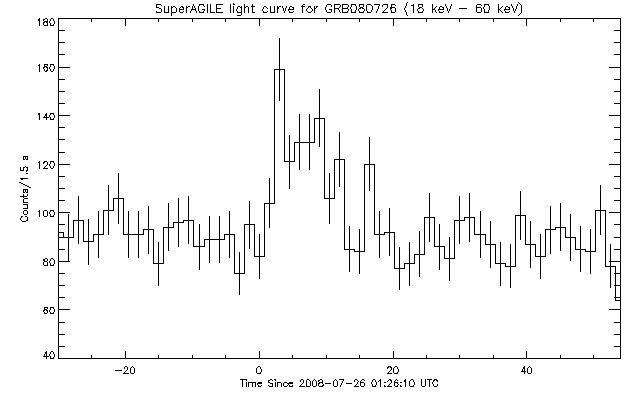
| | July 23, 2008 | GRB 080723B: Detection and Localization by SuperAGILE
A description of the burst can be found in GCN 8003 (E. Del Monte et al.)
The SuperAGILE light curve of the event is shown in the figure.

| | July 18, 2008 | New ATel issued #1619
ATel #1619
| | June 26, 2008 | New ATel issued #1592
ATel #1592
| | June 23, 2008 | New ATel issued #1585
ATel #1585
| | June 17, 2008 | New ATel issued #1583
ATel #1583
| | June 17, 2008 | New ATel issued #1582
ATel #1582
| | June 16, 2008 | New ATel issued #1581
ATel #1581
| | June 10, 2008 | AGILE special ToO pointing on W Comae (ON +231)
Following a TeV outburst from the BL Lac W Comae reported by the VERITAS Collaboration in ATEL #1565, AGILE repointed at the source on June 9 2008, 16:00 UTC.
The AGILE pointing coordinates at the beginning of the ToO pointing period are:
RA(J2000) = 182.3 deg = 12h 9m 8.3s
Dec(J2000) = 29.6 deg = 29° 36' 50.4"
(galactic coordinates: l = 195.5 b = 80.4)
This special pointing will last until June 15, 2008 12:00 UTC.
Multifrequency observations are strongly encouraged.
| | May 27, 2008 | New ATel issued #1545
ATel #1545
| | May 27, 2008 | New ATel issued #1547
ATel #1547
| | May 15, 2008 | GRB 080514B: SuperAGILE/IPN GRB Localization and possible AGILE detection at E>50 MeV
SuperAGILE and AGILE/MCAL detected a gamma ray burst on May 14th, at 09:55:56 UT. The event was localized by SuperAGILE at approximately 38 degrees off axis, in the one-dimensional portion of its field of view. The event was also detected by the burst detector onboard Mars-Odyssey, thus the IPN was able to reduce the SuperAGILE error box to the 100 sq arcmin error box, whose centroid is at (RA, Dec)= (322.820, 0.737).
The error box corners are given by the following coordinates (RA, Dec):
322.962 (21h 31m 50.81s) 0.733 (0d 43m 59.69s)
322.774 (21h 31m 5.74s) 0.667 (0d 40m 2.78s)
322.867 (21h 31m 27.99s) 0.806 (0d 48m 21.16s)
322.678 (21h 30m 42.80s) 0.740 (0d 44m 23.63s)
A description of the burst can be found in GCN 7715 (M. Rapisarda et al.)
As reported in GCN 7716 (A. Giuliani et al.) a quick look analysis of the AGILE GRID data of GRB 080514B shows a possible detection at energies E>50 MeV at a position consistent with the SuperAGILE-IPN localization .
| | May 9, 2008 | GRB 080507: GRB localization by SuperAGILE
SuperAGILE detected and localized a gamma ray burst on May 7th, at 07:45:00 UT.
The burst position was reconstructed as (RA, Dec) (233.721 deg, 56.424 deg), which is:
RA(J2000) = 15h 34m 53.11s
Dec(J2000) = 56d 25' 27.3"
with an uncertainty of 3' radius. The given uncertainty accounts for both the statistical and systematic errors.
A description of the burst can be found in GCN 7697 (I. Lapshov et al.)
The event was detected during the passage of the AGILE spacecraft through the South Atlantic Anomaly.
The telemetry of the AGILE Gamma Ray Imager (GRID) is disabled during the passage through the South Atlantic Anomaly, thus no GRID data are available for this GRB.
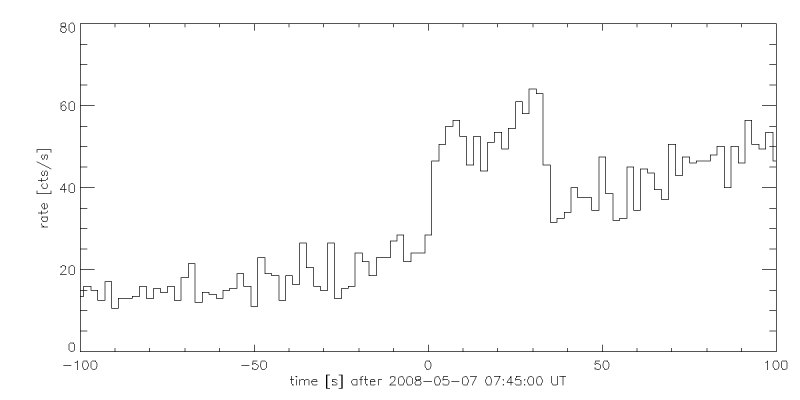
| | April 29, 2008 | Swift detection of the brightest X-ray flare from S50716+714
On 28 April 2008 Swift detected the blazar S50716+714 at X-ray and UV flux levels significantly larger than ever observed before. An analysis of the XRT data gives a 0.3-10 keV X-ray flux of 4e-11 erg/cm2/s, about 50% larger than that observed at the peak of the giant X-ray flare of October-November 2007.
Swift will continue the monitoring of S50716+714 over the next few days, while the AGILE Gamma-ray observatory will include this source within its field of view between April 30 and May 10, 2008. Multi-frequency observations are strongly encouraged (ATel.#1495, Giommi et al.)
| | April 29, 2008 | AGILE gamma-ray detection of a variable source in the Cygnus region
The AGILE satellite, from data obtained between 2008-04-27 01:39 UT and 2008-04-28 01:27 UT, detected significant and variable gamma-ray emission from a source positionally consistent with 3EG J2020+4017, see ATel #1492 (F. Longo et al.).
Multiwavelength observations of the source location are strongly encouraged.
| | April 22, 2008 | 5th Science AGILE Workshop
We are pleased to announce the 5th Science AGILE Workshop "AGILE first year of gamma-ray astrophysics" to be held on June 12-13, 2008 at ASI-ASDC c/o ESA/ESRIN, Frascati .
Detailed information will follow shortly on this web site.
| | April 10, 2008 | GRB 080408: GRB Localization by SuperAGILE
SuperAGILE detected and localized a gamma ray burst on April 8th, at 18:12:48 UT. The event was approximately 13 degrees off-axis.
The burst position was reconstructed as (RA, Dec) (114.678 deg, 33.305 deg), which is:
RA(J2000) = 114.678 deg = 07h 38m 42.68s
Dec(J2000) = 33.305 deg = 33d 18' 16.7"
with an uncertainty of 3' radius. The given uncertainty accounts for both the statistical and systematic errors.
A description of the burst can be found in GCN 7571 (P. Soffitta et al.)
A preliminary analysis of the AGILE GRID data (E>100 MeV) does not show any significant gamma ray emission at the time and coordinates of the burst GRB 080408 localized by SuperAGILE, see GCN 7572 (S. Mereghetti et al.)
Swift performed a Target of Opportunity Observation of the SuperAGILE GRB 080408, starting ~25 ks after the trigger.
The results of XRT and UVOT data analysis in this field have been reported in GCN 7576, GCN 7577.
A GROND (La Silla Observatory, Chile) detection of optical/NIR afterglow candidate is reported in GCN 7581.
| | March 27, 2008 | SuperAGILE detects an X-ray burst from a position consistent with IGR J17473-2721
The burst was detected on 26 March 2008, 23:19:40 UT, lasted approximately 40 s and it was significantly detected only in the energy range 17-25 keV, see ATel #1445 (E. Del Monte et al.).
Considering the intensity, the temporal and spectral properties of the event as well as the spatial coincidence with the source IGR J17473-2721 near the Galactic Center, we propose that the burst observed by SuperAGILE was indeed a Type I X-ray burst, and suggest that IGR J17473-2721 is an X-ray burster.
The SuperAGILE X-ray burst image and light curve are visible here .
| | March 26, 2008 | GRB 080319C: AGILE-MCAL observation of the prompt emission
On March 19 2008 the Swift localized GRB 080319C triggered the Mini-Calorimeter (MCAL) instrument onboard the AGILE satellite at 12:25:56 UT (=T0), see GCN #7457 (M. Marisaldi et al.).
| | March 26, 2008 | AGILE detection of a gamma-ray source coincident with Blazar PKS 1510-08
The AGILE satellite detected on March 20 2008 significant gamma-ray emission from a source positionally consistent with the blazar PKS 1510-08, see ATel #1436 (F. D'Ammando et al.).
Multiwavelength observations of the source location are strongly encouraged.
| | February 29, 2008 | AGILE AO-1 News
The official list of all AGILE AO-1 approved targets is now available here
| | February 25, 2008 | AGILE gamma-ray detection of a variable source in the Musca region
AGILE detected during the period between 2008-02-21 06:00 UT and 2008-02-22 07:30 UT a gamma-ray flaring source near the Galactic plane in the Musca region, see ATel #1394 (C. Pittori et al.).
The source positional error box is centered at Galactic coordinates l = 312.2 deg, b = -0.3 deg, and has a radius of about 0.5 degrees.
Multiwavelength observations of the source location are strongly encouraged.
| | February 12, 2008 | AGILE AO-1 News
The AGILE Data Center (ADC) at ASDC is currently finalizing the schedule for AGILE AO-1 software, calibration and data release for Guest Observers.
PI of accepted proposals will receive further information in the next days.
| | February 12, 2008 | AGILE TOO on Mkn 421
Following a TeV alert for the blazar Mkn 421,AGILE repointed at the source on February 9, 2008 09:00 UTC.
This special TOO pointing lasted until today, February 12, 2008 12:00 UTC when AGILE returned to look at the South Galactic Pole region, according to the Cycle 1 Baseline Pointing Plan.
| | January 4, 2008 | AGILE back in standard observing mode
From Dec. 31st, 2007 to Jan. 4th, 2008 the AGILE Payload has not been in observing mode due to technical problems.
From 13:30 UT of Jan. 4th, 2008 the AGILE detectors returned to the standard operating mode.
| | December 1, 2007 | AGILE AO1 data taking period started
The AO1 data taking period started today, as planned.
The official list of approved AO1 sources will be released within a few days.
| | November 28, 2007 | AGILE gamma-ray detection of a strongly variable source in the Cygnus region
AGILE detected on Nov. 24, 2007 a strong gamma-ray flaring source near the Galactic plane in the Cygnus region, see ATel #1308 (A. Chen et al.)
The variable source positional error box is centered at Galactic coordinates l = 75.0 deg, b = -0.4 deg, and has a radius of about 1 degree.
Multiwavelength observations of the source location are strongly encouraged.
| | November 15, 2007 | AGILE detection of a gamma-ray source coincident with Blazar 3C 454.3
The AGILE satellite, currently in its science performance verification phase, during the Observing Block that started on 2007-11-02 12:00 UT, detected significant gamma-ray emission from a source more than 40 degrees off-axis, coincident with the blazar 3C 454.3.
See ATel #1278 (A. Chen et al.) for details.
The AGILE pointing of the Galactic plane region that includes this gamma-ray source will continue until 2007-12-01 12:00 UT.
| | November 6, 2007 | GRB 071104: Gamma Ray Burst Localization by SuperAGILE
SuperAGILE detected and localized a gamma ray burst on November 4th, at 11:41:09 UT (*).
The event was approximately 22 degrees off-axis.
The burst position was reconstructed as:
RA(J2000) = 295.600 deg = 19h 42m 23.9s
Dec(J2000) = 14.645 deg = +14d 38' 42"
with an uncertainty of 8' radius. The given uncertainty accounts for both the statistical and systematic errors.
An analysis of the AGILE Gamma Ray Imager (GRID) data is in progress.
The Minicalorimeter also detected the event up to the energy range 0.7-1.4 MeV.
A description of the burst be found in GCN 7042 (Donnarumma et al.)
Swift started observing the field of view of the SuperAGILE burst GRB 071104 about 20.6 ks after the AGILE trigger.
The results of XRT and UVOT data analysis in this field have been reported in GCN 7043, GCN 7045 and GCN 7044
(*) this value of the trigger time corrects the trigger time given in the GCN 7042, affected by a typo.
| | October 29, 2007 | AGILE pointing on blazar 0716+714 extended
The AGILE special pointing on the optically active blazar 0716+714 will be extended until November 1, 2007.
Multifrequency observations are strongly encouraged.
| | October 26, 2007 | AGILE special pointing on blazar 0716+714
Following an intense optical flare of the blazar 0716+714, AGILE repointed at the source on October 24, 2007 08:00 UTC.
This special pointing will last until October 29, 2007 12:00 UTC. Multifrequency observations are strongly encouraged.
| | October 1, 2007 | AGILE AO1 issued
The first Announcement of Opportunity for the participation in the AGILE Guest Observers Program has been issued today.
The complete documentation for this AO can be found '' here
| | September 24, 2007 | AGILE detection of a gamma-ray source possibly associated with Blazar TXS 0716+714 / S5 0716+71
The AGILE satellite, currently in its science performance verification phase, during the Observing Block that started on 2007-09-04 12:00 UT, detected significant gamma-ray emission from a source possibly associated with blazar TXS 0716+714 (other name S5 0716+714). See ATel #1221 (A. Giuliani et al.) for details.
Today, September 24, 2007 the GLAST-AGILE Support Program (GASP) of the Whole Earth Blazar Telescope (WEBT) reports on the observation of an optical flare of this blazar in the same period, see ATel #1223 (D. Carosati et al.).
| | September 14, 2007 | AGILE AO-1 postponed
The dates of the AGILE AO-1 have been postponed by two weeks.
This decision had to be taken in order a) to allow the completion of the AGILE calibration/performance verification phase and b) to complete the definition of the pointing plan for the first year of operations.
The new dates of AO1 are :
● beginning of the proposal submission period 1 October 2007
● deadline for proposals submission 31 October 2007
| | September 3, 2007 | AGILE detection of a gamma-ray source off the Galactic Plane
The AGILE satellite, currently in its science performance verification phase, during an observation centered near the Galactic plane (l=334.44, b=10.06) that started on 2007-08-27 12:00 UT, detected significant gamma-ray emission from a source at approximately 33 degrees off the AGILE pointing direction, see ATel #1199 (Bulgarelli et. al).
| | August 31, 2007 | SuperAGILE detection of GRB070824
On August 24th 2007, at 20:50:09 UT the SuperAGILE GRB-search ground software was triggered by GRB070824. The GRB was seen as a 3 second event, preceded by a weaker 2 s precursor 5 s earlier, leading to an overall burst duration of about ~10 s (T90=9.5 s), see light curve below (courtesy of I. Donnarumma, E. Del Monte, F. Lazzarotto, M. Feroci of AGILE Team).
The GRB was observed by SuperAGILE at 48.1 deg off-axis, a region of the instrument field of view with only one-dimensional imaging.
In addition, its arrival direction was partially obscured by the Earth's atmosphere. For these reasons, the SuperAGILE-only error box is a long, narrow strip limited by the instrument field of view and Earth occultation in one direction and by the imaging uncertainty in the other.
This event was independently detected by other IPN experiments, namely Konus-Wind, Swift/BAT, RHESSI,AGILE/Minicalorimeter, and the AGILE/Anticoincidence, as well as by Konus-A (Cosmos-2421). Their detection combined to provide further constraints to the burst localization to a triangular region, as shown in the figure below (courtesy of Valentin Pal'shin, Ioffe Physico-Technical Institute).
A detailed description of the burst and the localization area can be found in GCN 6767 (I. Donnarumma et al.)
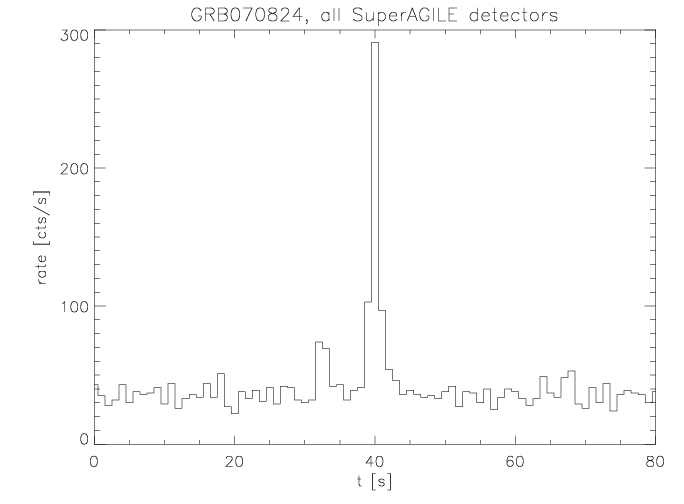
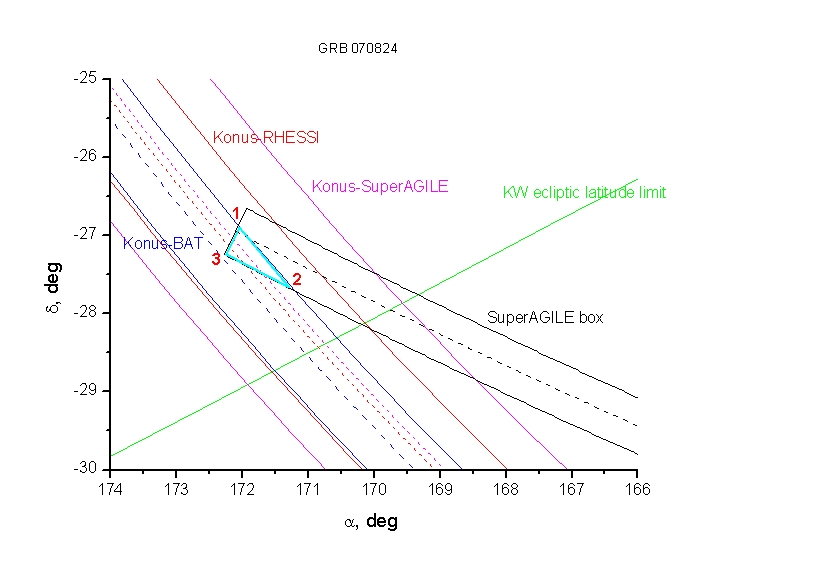
| | August 7, 2007 | AGILE detection of the blazar 3c454.3 in a high state
The AGILE satellite, currently in the science performance verification phase, has observed the 3C 454.3 field starting on 2007-07-24 14:30 UT, and ending on 2007-07-30 11:40 UT following the significant flaring activity of this blazar recently detected in the optical and X-ray energy bands.
Considering that the AGILE in-flight calibration is still ongoing, a gamma-ray source positionally consistent with 3C 454.3 was detected by the AGILE GRID (Gamma-Ray Imaging Detector), see ATel #1160 (S. Vercellone et al.) and ATel #1167 (A. Bulgarelli et al.).
The images below show the AGILE detection of the source in the gamma-ray energy band E > 100 MeV. The left picture is a detector image with superimposed a grid of Galactic coordinates in ARC projection. The right picture shows the same gamma-ray image distorted to match the Hammer-Aitoff projection in Galactic coordinates.
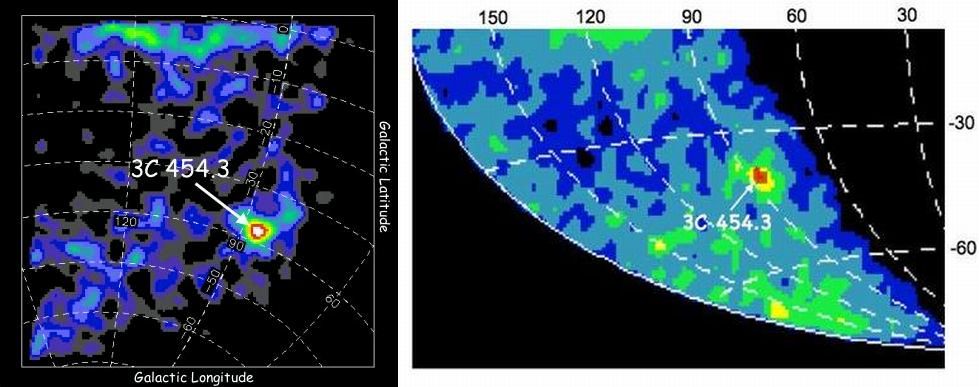
| | July 26, 2007 | First Gamma-Ray Burst detected by SuperAGILE
On July 24 approximately at 23:25:09 UT SuperAGILE detected and imaged GRB 070724b. The experiment is not yet in its optimal configuration and in particular, the onboard triggering and imaging is not active yet and the absolute position reconstruction is being calibrated by using celestial X-ray sources.
Ground analysis results showed that the event was observed at 21 degrees off-axis and the observed duration in the 20-60 keV energy range is about 55 seconds, with a multi-peak time structure (see figures).
The burst position was reconstructed as (RA, Dec) (17.629 deg,57.673 deg), which is:
RA(J2000) = 01h 10m 31.0s
Dec(J2000) = +57d 40' 23"
with an uncertainty of 20' radius. The given uncertainty is almost entirely systematic and it is due to the very preliminary absolute position calibration, carried out only on 3 X-ray sources. At this preliminary stage the absolute positioning was obtained by the ground calibrations, preliminarily checked with these sources. The error box may be improved over the next hours/days.
An analysis of the AGILE Gamma Ray Imager (GRID) data is in progress. A quick look analysis does not show any bright gamma-ray transient in coincidence with the X-ray emission of GRB 070724b.
These results have been published in GCN 6668 (Feroci et al.) http://gcn.gsfc.nasa.gov/gcn3/6668.gcn3
Following the SuperAGILE trigger the field of GRB070724b was observed by SWIFT leading to the observation of 2 probable X-ray afterglow candidates (Romano et al., GCN 6669).
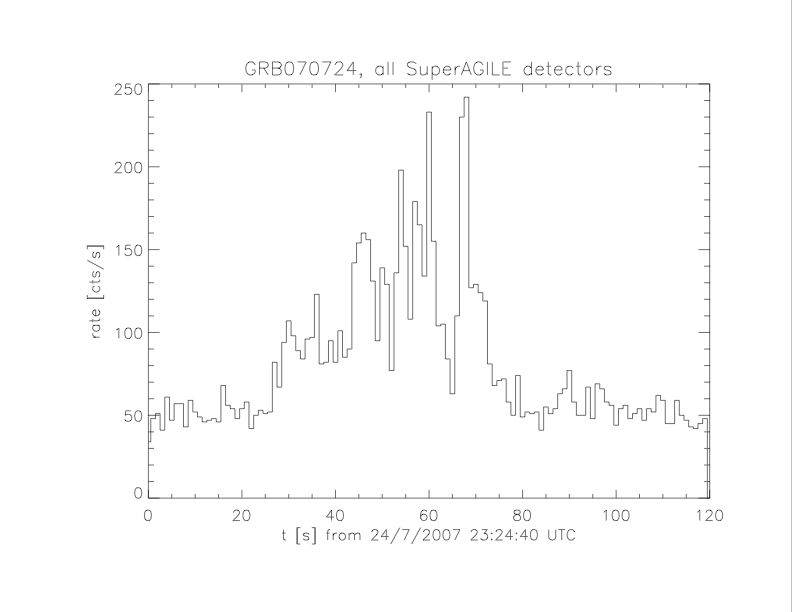
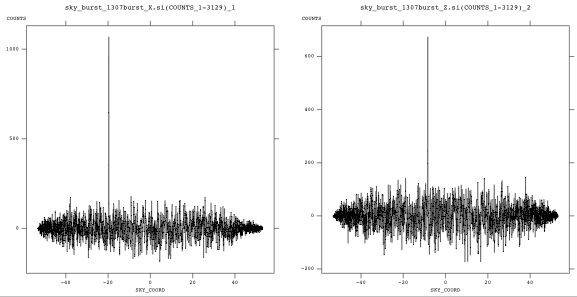
| | July 26, 2007 | AGILE Observations of 3C454.3
On July 24, 2007 AGILE Observations of 3C454.3 the AGILE satellite carried out a re-pointing of the 3C454.3 field starting on July 24, 2007, 4:30pm, following the significant flaring activity of this blazar that was recently detected in the optical and X-ray energy bands. The pointing centroid coordinates of the co-aligned AGILE gamma-ray and X-ray imagers are:
R.A. (J2000) = 17.829
DEC. (J2000) = 36.694
(l= 127.364, b = -26.007).
The 3C 454.3 source turns out to be positioned about 36 degrees off-axis with respect to the AGILE pointing centroid. The AGILE gamma-ray imager detection capability at that off-axis position is nominal.
AGILE will point at the 3C 454.3 field for the time period:
start: July 24, 2007, 4.30 pm
end: July 30, 2007, 12:00am.
Multifrequency observations of the source are encouraged. Please contact
Stefano Vercellone of the AGILE Team (stefano@iasf-milano.inaf.it,
mobile phone: +39 347 3089 465).
| | July 23, 2007 | AGILE AO1
Preliminary documentation for the Announcement of Opportunity for Cycle 1 of the AGILE Guest Observer Program is now available at https://agile.ssdc.asi.it/ao.html.
Proposals are due from September 15, 2007 up to October 15, 2007 at 18:00 UT.
| | July 10, 2007 | AGILE - GLAST Workshop
On July the 2nd and 3rd it has been hold at ASDC site the italian Workshop dedicated to gamma-ray astrophysics from space, focused on AGILE and GLAST missions.
The conference was attended by 140 people from the astrophysics and particle physics communities, industrial entities and the President of ASI, INFN and INAF.
During the Workshop the First AO for AGILE Mission was prsented. Some first very promising results were presented, some of which have been announched in other News.
Results from the GLAST on-ground calibration have been presented as well as the Science Working Group activity in preparation to the launch, now foreseen in January 2008.
Part of the Workshop was dedicated to the sinergies with other observatories and telescopes, such as INTEGRAL, Swift, MAGIC etc.
| | July 6, 2007 | AGILE: SuperAGILE first light
As announced previously, the hard X-ray imager SuperAGILE clearly detected a flare from the source GX301-2 as its first light. These images (courtesy of E. Del Monte, I. Donnarumma, Y. Evangelista, F. Lazzarotto, L. Pacciani of Agile Team) are the results of an immediate raw and very preliminary deconvolution of two detectors. Analysis of the data with the scientific software is in progress. Preliminary results show a declining of the source flux over the subsequent orbits.
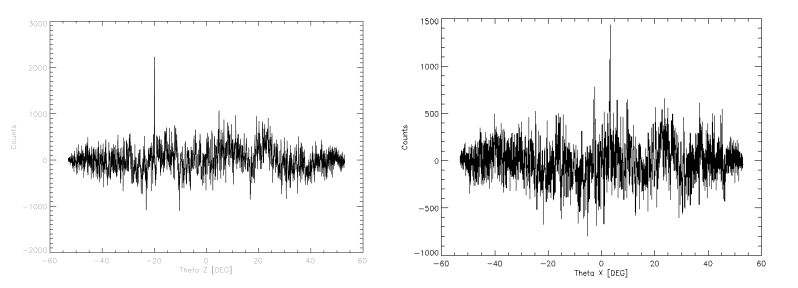
| | July 4, 2007 | AGILE: 1,000 orbits and approaching the end of the Commissioning phase
AGILE has completed yesterday its 1,000th orbit and has almost come to the completion of the initial start-up/Commissioning phase.
On July 2nd, at the ASDC/ESRIN Workshop on Gamma-ray Astrophysics in Italy, several AGILE preliminary results have been presented. In particular:
- The hard X-ray imager SuperAGILE clearly detected a flare of the source GX301-2 as its first light.
- A gamma-ray burst was detected by all active detectors on June 22. The burst position turned out to be about 80 degrees off-axis.
- The AGILE calorimeter has clearly detected emission in the 600 keV - 2 MeV energy range.
| | June 19, 2007 | AGILE Commissioning News
In this phase the SuperAGILE instrument is undergoing its configuration setting, which we plan to complete at the end of june.
| | June 1, 2007 | AGILE first detection of a cosmic source: the Vela Pulsar
The picture shows a preliminary count map (Galactic coordinates) of photons with energy above 100 MeV of the Vela Pulsar region. The observation duration is approximately half a day (7 orbits) between May 29 and 30, 2007.
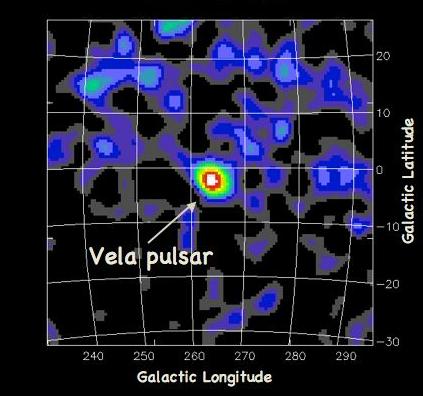
This image represents only the central part of the AGILE gamma-ray imager field of view and was built from data with a preliminary background rejection taken with an instrument configuration that is not yet optimized.
The AGILE Commissioning phase will continue until the end of June. This phase is aimed at a fully operational setting of both the gamma/ray and X-ray detectors.
| | May 17, 2007 | AGILE Commissioning news.
The AGILE Payload is now operated routinely and the thermal stabilization of the spacecraft is in progress.
All Payload subsystems are in nominal conditions with satisfactory temperatures.
The first scientific/calibration observations in nominal conditions are planned for the beginning of june with a pointing of the Vela region.
| | May 9, 2007 | First AGILE cosmic photon.
Yesterday AGILE detected its first cosmic photon during a test calibration of the Gamma-Ray Imager (Silicon Tracker).
The figure below is a view of the track left by the electron-positron pair produced by the incoming photon and recorded in the twelve silicon layers of the detector.
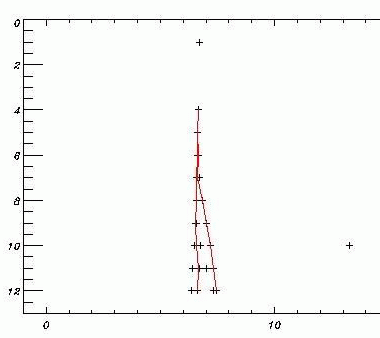
| | May 8, 2007 | AGILE's 200th pass: all Payload subsystems in nominal conditions.
Yesterday, the Payload Anticoincidence System (AC) has been successfully switched on and tested for the entire
orbit, including the South Atlantic Anomaly. All test results are nominal and the real-time analysis indicates that the total count rate is as expected.
The AC was the last major Payload subsystem awaiting testing after the mini-Calorimeter, the Silicon Tracker and SuperAGILE, which were switched on and tested last week.
The Commissioning activities will continue with the Payload thermal stabilization phase, followed by the Scientific Commissioning phase.
| | May 3, 2007 | AGILE Payload switched on!
Yesterday, Wed May 2, 2007, the AGILE mini-Calorimeter was switched on, today the Silicon Tracker (gamma-ray detector) and the SuperAGILE (hard X-ray) detector have also been switched on.
All systems are nominal and the real-time analysis indicates that the AGILE Payload is in very healthy conditions.
The Payload Commissioning will continue now with 11 orbits devoted to SuperAGILE and to the Anticoincidence System that will be switched on next week.
| | May 2, 2007 | AGILE satellite 100th pass
On Mon, 30 Apr 2007 12:03 UTC the AGILE satellite has successfully completed its 100th pass. All test results are nominal. The satellite is currently in FINE SUN POINTING attitude, as scheduled by the Commissioning Plan.
The Payload Commissioning Phase will begin on Wed, 2 May 2007 to verify the physical and functional integrity of the scientific instruments.
| | April 27, 2007 | AGILE satellite status
On Apr. 23rd the AGILE satellite was injected in the nominal equatorial orbit in agreement with the Scientific Requirements of the Mission.
The satellite is now in the initial Commissioning Phase.
All test results are nominal.
The satellite is being tracked at each orbit by the ASI Malindi ground station in Kenya.
The AGILE data flow Malindi-Fucino-ASDC is nominal since its first pass on Apr. 23rd
| | April 23, 2007 | AGILE succesfully launched!
AGILE was succesfully launched at 10:00 GMT by the Indian PSLV rocket from
the Shriarikota ISRO base (Chennai-Madras), India.
The first acquisition from the Malindi ground station occurred at 11:30 GMT.
The orbital parameters are very close to the predicted values (altitude 550 km, inclination of 2-3 degrees) and
the satellite status is nominal.
| | April 16, 2007 | AGILE satellite status
The AGILE satellite has been successfully integrated with the PSLV launcher at the ISRO - Sriharikota launch base (Chennai-Madras) India.
The final functional tests after integration have been completed on Sunday, April 15th, 2007, at 17:00 (Indian Time).
The AGILE satellite is now ready for flight.
The AGILE launch is currently scheduled for April 23rd, 2007 GMT Time 10:00, Indian Time 15:30, Italian time 12:00.
| | March 27, 2007 | AGILE satellite status
On March 25th AGILE as been shipped to India (SHAR) for the launch
campaign.
Launch is currently scheduled for 23 April 2007.
The following link provides more information from the Indian viewpoint
at the Launch Pad.
www.space-travel.com/reports/ISRO_To_Launch_Foreign_Satellite_As_Primary_Payload_First_Time_999.html
| | March 21, 2007 | AGILE satellite status
The AGILE System Validation Tests 4 (SVT4) at the IABG facility (Munich) have been successfully concluded.
AGILE is scheduled to be shipped to India (SHAR) for launch on march 25.
| | March 5, 2007 | Latest AGILE news
AGILE satellite status
The AGILE System Validation Test 4 (SVT4) currently under way at IABG facility (Munich) will be completed on March 13.
AGILE will then be packed and shipped to India (SHAR) for launch.
| | January 26, 2007 | AGILE satellite status
The AGILE satellite has been shipped at the IABG facility (Munich) for the final delta qualification tests before launch.
| | January 26, 2007 | India Test Technology For Space Vehicles
All Four Satellites in Healthy Condition After PSLV-C7 Launch PSLV-C8 will take the Italian satellite, Agile, to outer space by the end of march 2007.
|
|



